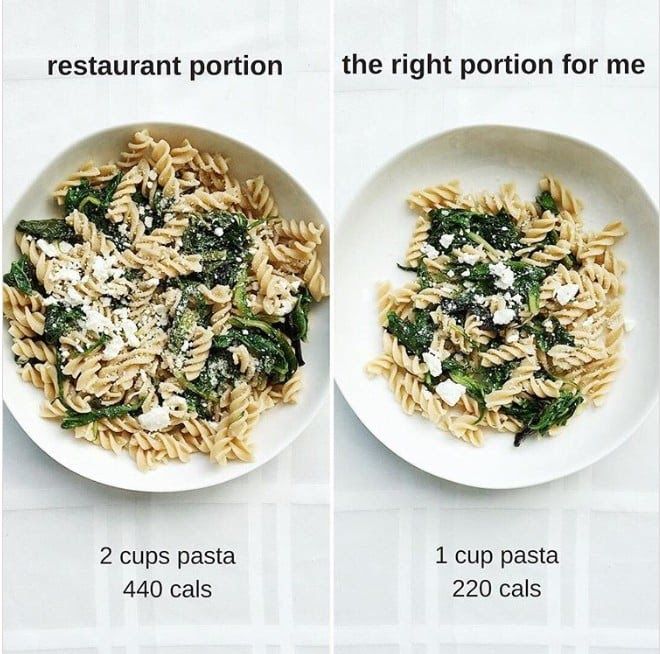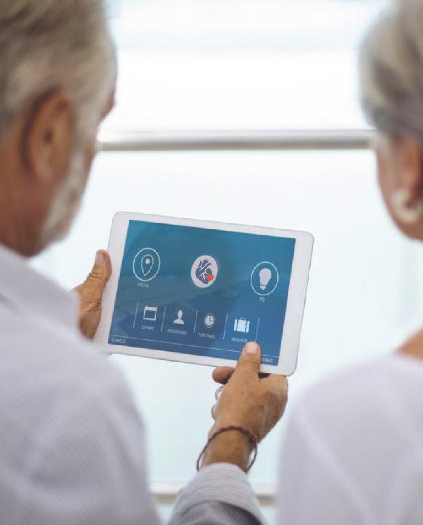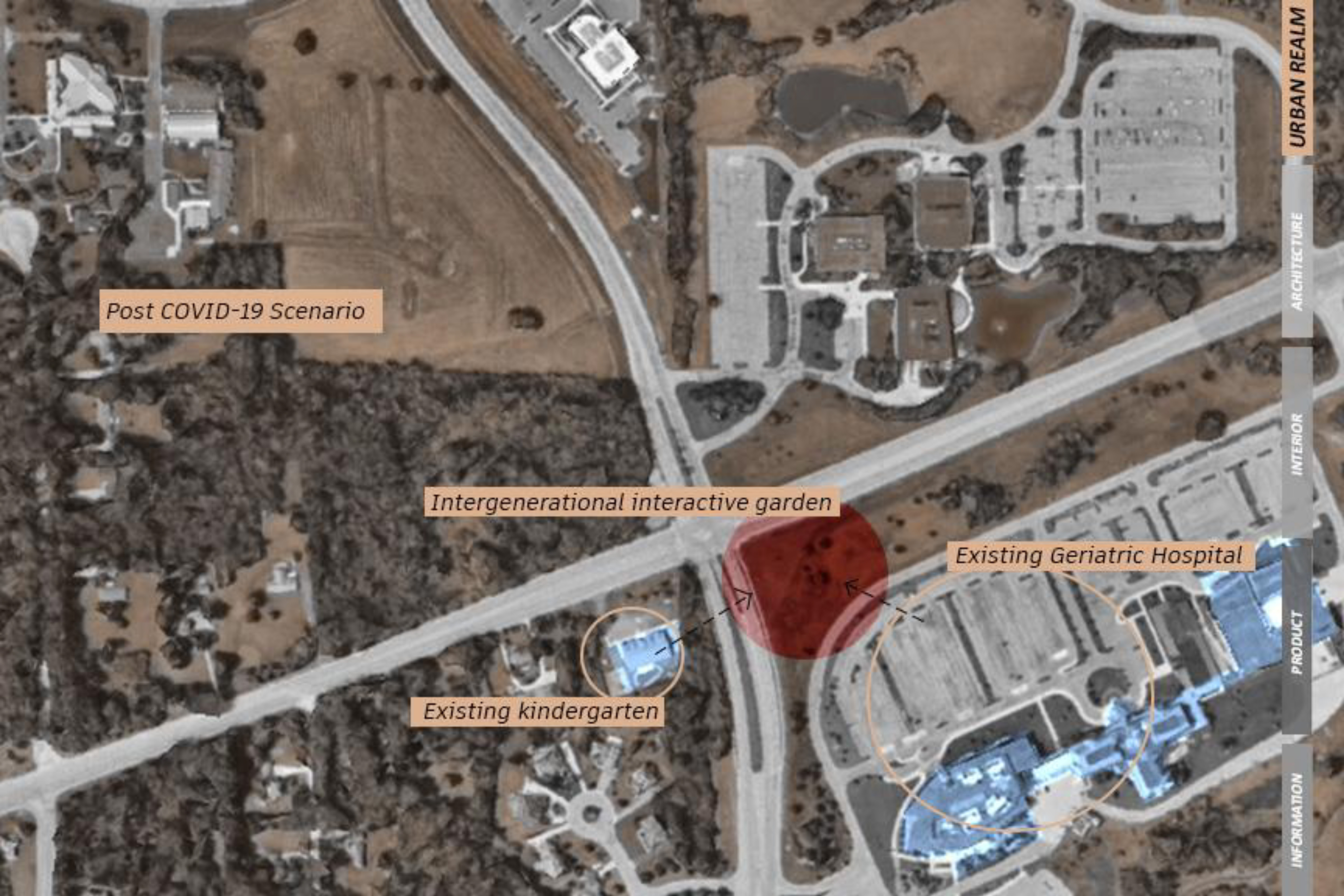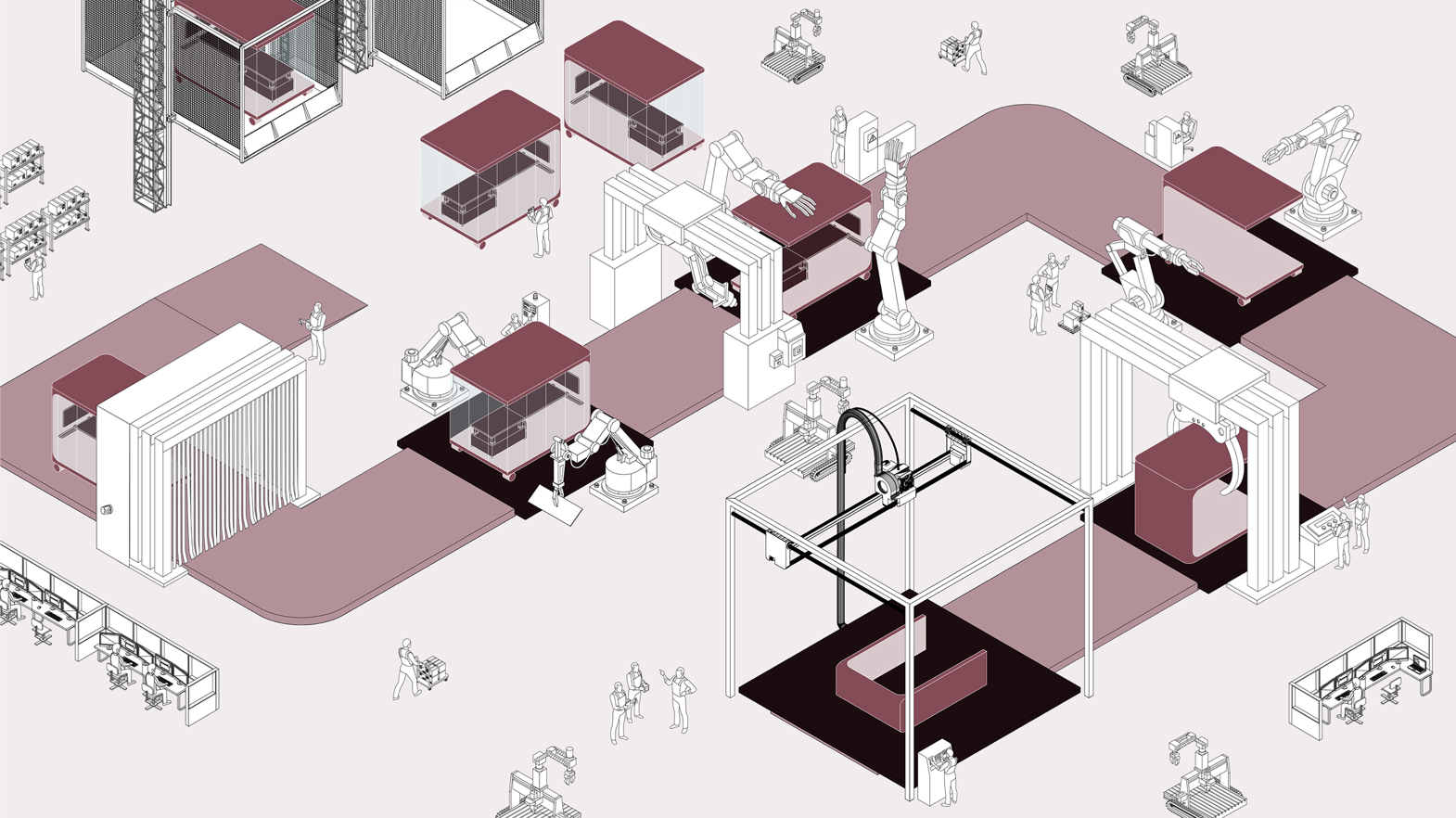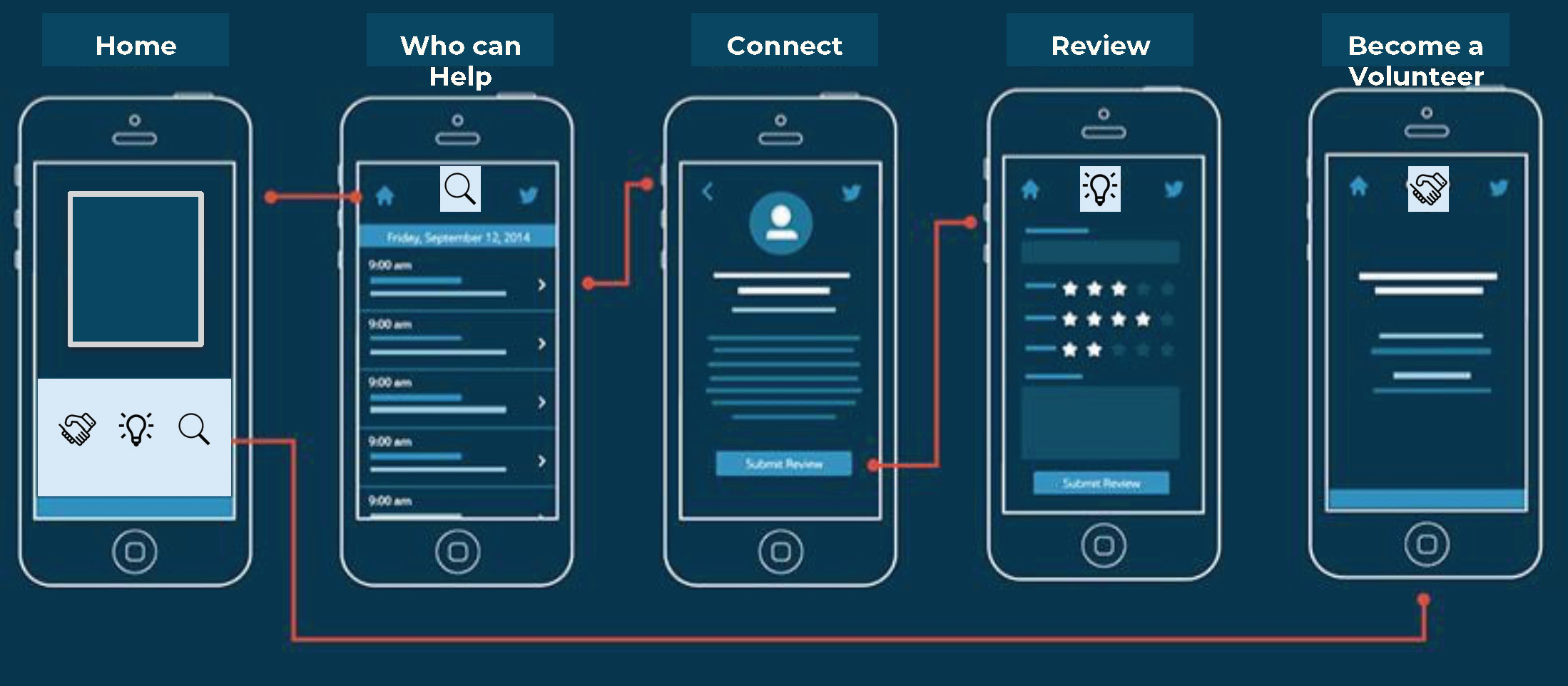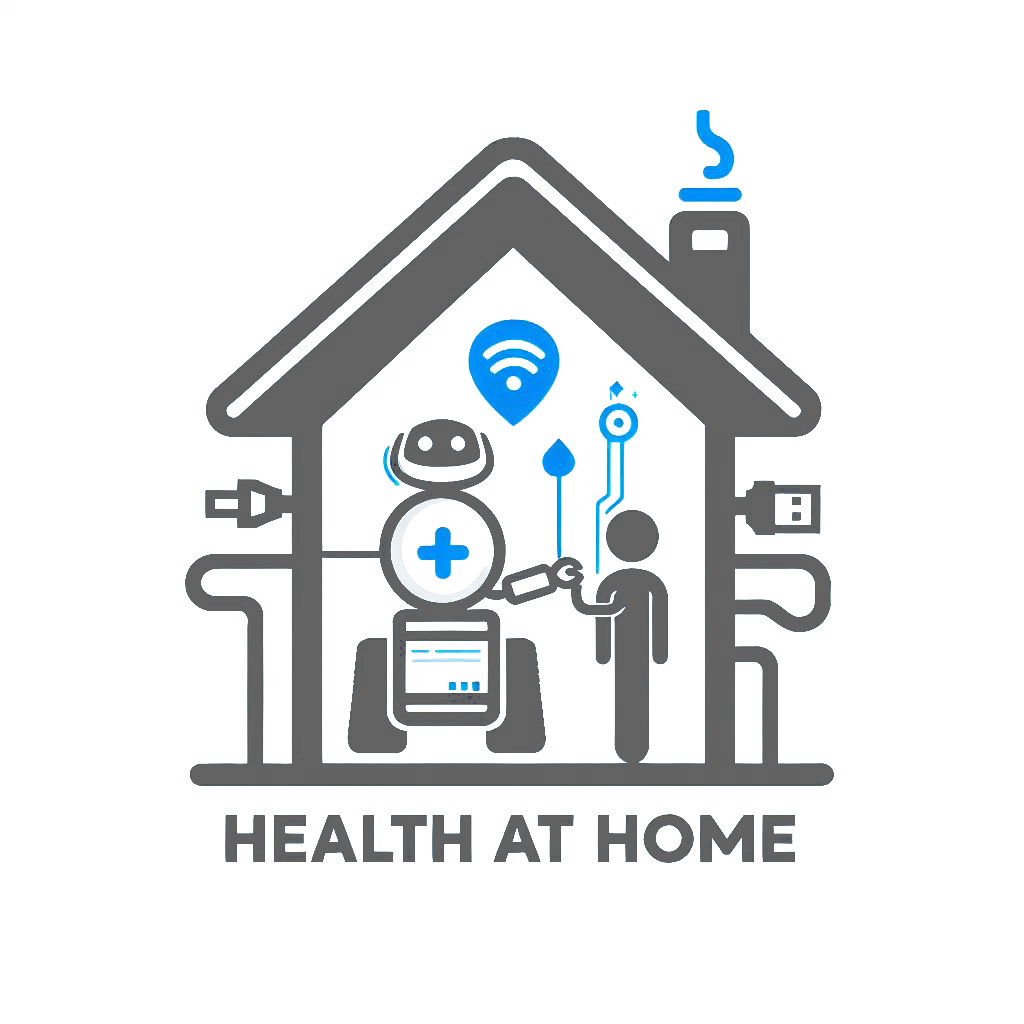︎ Consumption Of Alcohol In Moderation
Bringing in zoning regulations + information to help a community to reduce their consumption of alcohol
By Apurva Muralidha ︎


Hypothesis
The design challenge here for a Neighborhood to consume Alcohol in Moderation, alcohol has become an integral part of the society, Even
after knowing the harmful effects of alcohol, the amount of alcohol consumption has not reduced. Then WHY is alcohol really Harmful?
1.Americans spend about 1 PERCENT of their gross annual income on alcohol. For the average household, that's $565 a year; $5,650 in 10 years, or a whopping $22,600 over a 40-year period.- Bureau of Labor St.atistics.
2. TWENTY-FIVE to FORTY percent of all patients in U.S. general hospital beds (not in maternity or intensive care) are being treated for complications of alcohol-related problems- Center on Addiction and Subst.ance Abuse, Columbia University, 1994
3.Annual health care expenditures for alcohol-related problems amount to $22.5 BILLION. The total cost of alcohol problems is $175.9 billion a year (compared to $114.2 billion for other drug problems and $13 7 billion for smoking)-2 Economic costs of subst.ance abuse, 1995
4.Binge drinking is most common among younger adults aged 18--34 YEARS, but more than haff of the total binge drinks are consumed by
those aged 35 and older. - National center for Biotechnology Information {NCBI}
The design challenge here for a Neighborhood to consume Alcohol in Moderation, alcohol has become an integral part of the society, Even
after knowing the harmful effects of alcohol, the amount of alcohol consumption has not reduced. Then WHY is alcohol really Harmful?
1.Americans spend about 1 PERCENT of their gross annual income on alcohol. For the average household, that's $565 a year; $5,650 in 10 years, or a whopping $22,600 over a 40-year period.- Bureau of Labor St.atistics.
2. TWENTY-FIVE to FORTY percent of all patients in U.S. general hospital beds (not in maternity or intensive care) are being treated for complications of alcohol-related problems- Center on Addiction and Subst.ance Abuse, Columbia University, 1994
3.Annual health care expenditures for alcohol-related problems amount to $22.5 BILLION. The total cost of alcohol problems is $175.9 billion a year (compared to $114.2 billion for other drug problems and $13 7 billion for smoking)-2 Economic costs of subst.ance abuse, 1995
4.Binge drinking is most common among younger adults aged 18--34 YEARS, but more than haff of the total binge drinks are consumed by
those aged 35 and older. - National center for Biotechnology Information {NCBI}
- How?
After interviewing people in the neighborhood 4 personas stood out.
1. Fresh graduate 2. Health Enthusiast 3. College Student 4. Working Professional
Common answers:
1.Drinking alcohol for fun and stress.
2. Non-alcoholic drinks Unhealthy or more expensive.
3.Fitness helps reduce consumption of alcohol.
4.Like minded influences help reduce consumption of alcohol.
5.Information helps choice.
- Why/ What?
Zoning regulations that help increase accessible healthy restaurants and activity centers + information through apps enhance freedom of
choice to promote healthy communities and moderate consumption of alcohol in the longterm.
- So What?
Identifying key points where a person decides to consume alcohol helped us determine the key points where intervention would be effective in helping a person make informed choices.
1. Neighborhood
2. Accessibility of a restaurant.
3. Information about surroundings
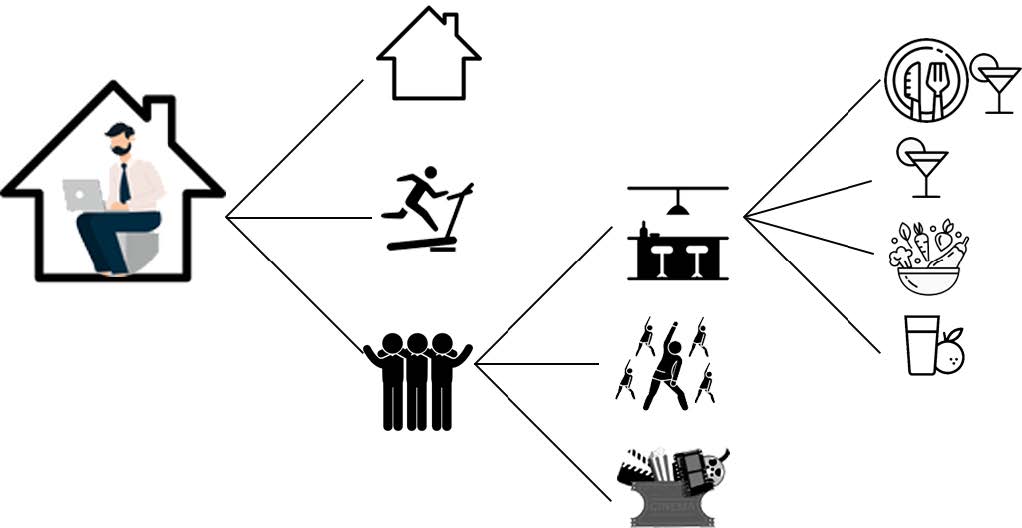
The design and outcomes.
Design to Outcomes
Accessibility and information is an key to help a community make right decisions about alcohol. The intervention is interested in bringing in zoning regulations + information to help a community to reduce their consumption of alcohol. To help people to make right decisions for consumption of alcohol it was important to know why people drink alcohol.
︎
Works Cited
1. l. Linton, A~. "How Much Does Drinking Really cost?"' The Balance EVe,yday. Bureau of Labor Statistics, August 24, 2018. https://www.thebalanceeve,yday.com/what-Jlfetime-of-iirin/cmg-costs-4142309.
2. Policy Alconol. Health Care Costs of Alcohol. Center on Addiction and Subst.mce Abuse. Accessed January 31, 2020. http://www.alcoholpolic;ymd.com/alcohol and health/costs.htm. target="_blank">costs.htm.
3. Policy, Alcohol. Health Care Costs of Alcohol. Center on Addiction and Substance Abuse. Accessed January 31, 2020. http://www.alcoholpolicymd.r:om/alcohol and health/costs.htm.
4. CDC act Sheets-Binge Drinkins-Aloohol.N Centet5 for Disease Control and Prevention. National center for Biotechnology Information (NCBI}, October 24, 2018. https://www.ak.gav/alr:ohol/fact-sheets/bingeninking. htm.
Image Citation
1. "Alcoholism Statistics & Information on Group Demogra_p_hics: Alcohol Abuse Statistics & Information on Alcoholism & Addiction Treatment Help. Alcohol Treatment Admission Statistics, December 20, 2019. h!1P5J/www.alcohol.orgMtatlstlcs-lnformatlon/.
2. "CDC- Fact Sheets-Binse Drink!ns- Alcohol." Centet5 for Disease Control and Prevention. Youth Risk Behavior Surveillance ~m and Behavioral Risk Factor Surveillance system, 2fJl5, OctDber 24, 2018. nttps://www.cdc.gov/alcohol/fact-sheets/blnge-drlnklng.htm.
︎ Street Greening
Re-envisioning the relationship of privacy and engagement through vertical planters, providing comfort to the residents, and interaction for the passerby
By Scott Crandall ︎

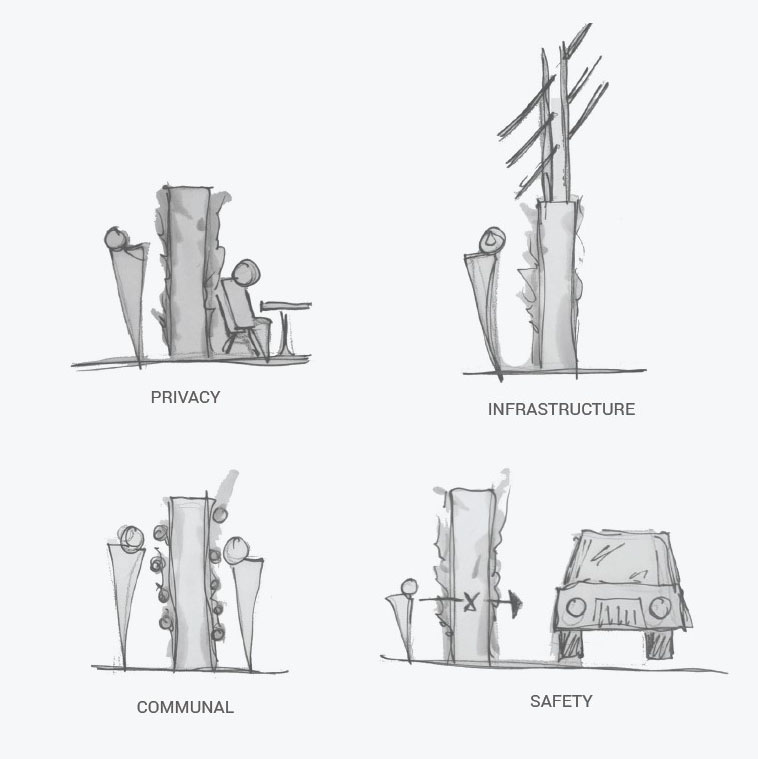
Hypothesis
Despite the comfort found in the environment of Ann Arbor, Michigan, there’s still a degree of visual and auditory distraction caused by local traffic (both vehicular and pedestrian). The main roadways leading into Ann Arbor are hot spots for both of these kinds of ”pollution”, a problem that is only exacerbated during local events (such as sports or festivals). This makes life a little less comfortable for the residents stationed along these high-traffic corridors.
Despite the comfort found in the environment of Ann Arbor, Michigan, there’s still a degree of visual and auditory distraction caused by local traffic (both vehicular and pedestrian). The main roadways leading into Ann Arbor are hot spots for both of these kinds of ”pollution”, a problem that is only exacerbated during local events (such as sports or festivals). This makes life a little less comfortable for the residents stationed along these high-traffic corridors.
- Why?
Noise pollution and visual disturbances will be decreased leading to reduced stress and irritation to the residents.
- How?
Installation of vertical planters
- What?
Privacy, comfort, and increased interaction using street greening.
- So What?
This may encourage residents to engage more in outdoor activities, increasing opportunities for community interaction and physical activity.
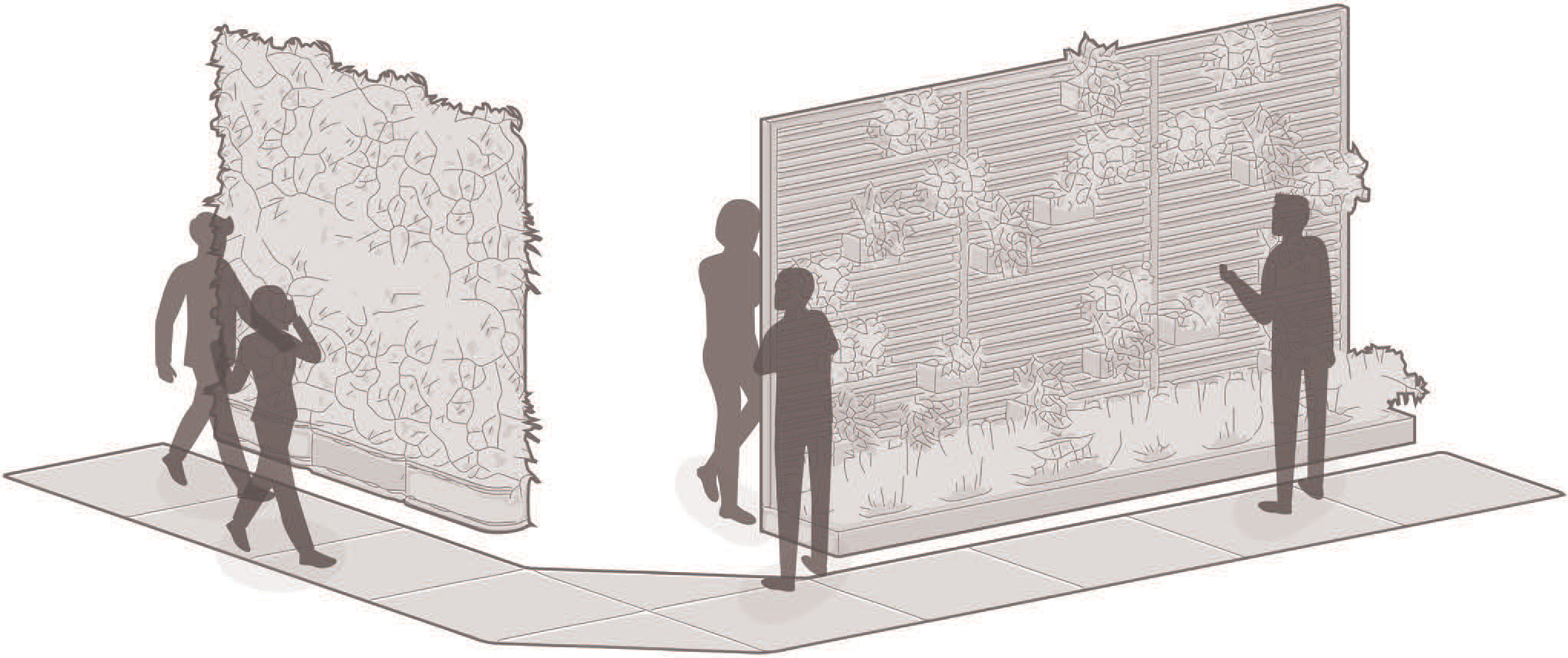
The design of street greening.
Design to Outcomes
By proposing a network of infrastructural vertical planters, we can both mitigate the pollution caused by the activities of these corridors, providing privacy and solace to the residents, as well as providing opportunities for curated engagement between both the residents and the chance pedestrians. Ann Arbor is already considered a botanical haven due to the ratio of plant-to-hardscape it maintains, and this would only benefit that status. Beyond this, there’s a variety of tertiary benefits that could be obtained through such a consideration.
︎
Works Cited
1. “Walker's Paradise.” n.d. Walk Score. Accessed February 10, 2020. https://www.walkscore.com/score/ann arbor, michigan.
2. MapEsri, HERE, Garmin, (c) OpenStreetMap contributors, and the GISuser communityBureau of Transportation Statistics, VOLPECONUS https://maps.bts.dot.gov/arcgis/apps/webappviewer/index.htmlid=a303ff5924c9474790464cc0e9d5c9fb
3. Holzman, David C. 2014. “Fighting Noise Pollution: A Public Health Strategy.” Environmental Health Perspectives 122 (2). https://doi.org/10.1289/ehp.122-a58.
4. A. Can, L. Leclercq, J. Lelong, D. Bottledoren. Traffic noise spectrum analysis: dynamic modeling vs. experimental observations. Applied Acoustics, Elsevier, 2010, vol71, n8, p764-70. ffhal-00506615.
5. Purves D, Augustine GJ, Fitzpatrick D, et al., editors. Neuroscience. 2nd edition. Sunderland (MA): Sinauer Associates; 2001. The Audible Spectrum. Available from: https://www.ncbi.nlm.nih.gov/books/NBK10924/
6. “What Is the Decibel Scale?” n.d. What Is the Decibel Scale | Soundstop.co.uk. Accessed February 10, 2020. https://www.soundstop.co.uk/decibel-scale.
7. Fan, Yang & Zhiyi, Bao & Zhu, Zhujun & Jiani, Liu. (2010). The Investigation of Noise Attenuation by Plants and the Corresponding Noise-Reducing Spectrum. Journal of environmental health. 72. 8-15.
︎ Diet Assisstance
Automatically generating recipes based on products available in the refrigerator
By Wenjing(Jane) Cen ︎


Hypothesis
Based on the Research analysis of the article Frequency of eating home cooked meals and potential benefits for diet and health: cross-sectional analysis of a population-based cohort study published on The International Journal of Behavioral Nutrition and Physical Activity, In a cross-sectional population-based study, consuming home cooked main meals more frequently was associated with a range of indicators of a healthier diet… findings suggest that regularly eating home cooked meals may confer benefits to diet and health, and that home cooking promotion and skill development should form part of future public health initiatives. [1]
In addition, according to The U.S. Department of Health & Human Services Americans eat less than the recommended amounts of vegetables, fruits, wholegrains, dairy products, and oils. This indicates in the foreseeable future, there will be a trend in more people adapting the new and healthier eating habit. [2]
Based on the Research analysis of the article Frequency of eating home cooked meals and potential benefits for diet and health: cross-sectional analysis of a population-based cohort study published on The International Journal of Behavioral Nutrition and Physical Activity, In a cross-sectional population-based study, consuming home cooked main meals more frequently was associated with a range of indicators of a healthier diet… findings suggest that regularly eating home cooked meals may confer benefits to diet and health, and that home cooking promotion and skill development should form part of future public health initiatives. [1]
In addition, according to The U.S. Department of Health & Human Services Americans eat less than the recommended amounts of vegetables, fruits, wholegrains, dairy products, and oils. This indicates in the foreseeable future, there will be a trend in more people adapting the new and healthier eating habit. [2]
- Why?
1.To help reduce food waste
2.To encourage people to adapt healthier diet habits of eating home cooked meals
- How?
1. Notifications of the items already have in refrigerator
2. Approximations of food items freshness
3. Estimations of possible recipes in arranging different food combination
- What?
A auto-generated app for home-cooked recipes.
- So What?
To help reduce food waste and to encourage people to adapt healthier diet habits of eating home cooked meals.


Design to Outcomes
The design intervention is an app that can automatically generate recipes based on products available in the refrigerator. People will record the items they have bought in the grocery stores and the app will search through the greater database with possible recipes available based on purchase ingredients.
︎
Works Cited
1. Mills, Susanna, Brown, Heather, Wrieden, Wendy, White, Martin James, and Adams, Jean Margaret, “Frequency of eating home cooked meals and potential benefits for diet and health: cross-sectional analysis of a population-based cohort study,” 2017.
2. Only 1 in 10 Adults Get Enough Fruits or Vegetables [Internet]. [cited 09th February 2020]. Available from: https://www.cdc.gov/media/releases/2017/p1116-fruit-vegetable-consumption.html
︎ MDining Design
Diet & Activity Decisions
By Thea Thorrell ︎

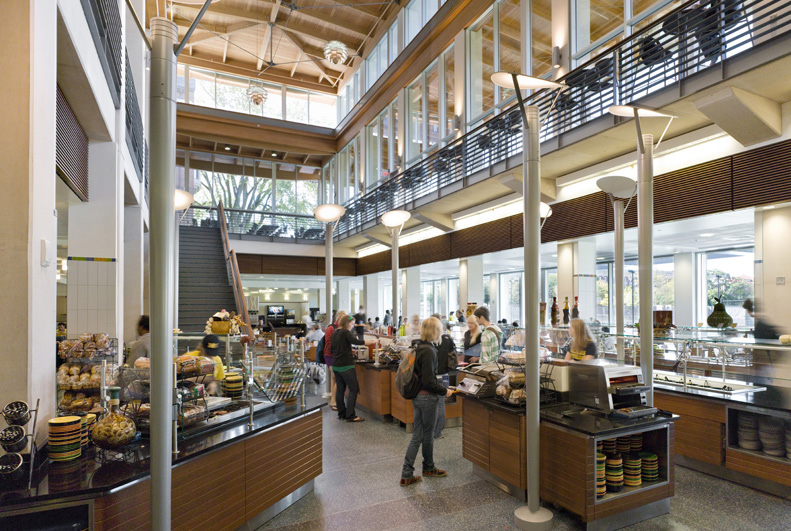 Photo credit: Mosher-Jordan Dining Hall by Anton Grassl/ESTO
Photo credit: Mosher-Jordan Dining Hall by Anton Grassl/ESTO
Hypothesis
The following project takes a semi-comprehensive approach when rethinking the design of the University of Michigan – Ann Arbor’s Dining Halls, which ultimately influences students’ diet, eating behaviors and physical activities. The information the university does not provide to its students, the lack of proper product design in addition to some paramount interior and architectural decisions are exacerbating obesity rates as well as the prevalence of eating disorders.
The following project takes a semi-comprehensive approach when rethinking the design of the University of Michigan – Ann Arbor’s Dining Halls, which ultimately influences students’ diet, eating behaviors and physical activities. The information the university does not provide to its students, the lack of proper product design in addition to some paramount interior and architectural decisions are exacerbating obesity rates as well as the prevalence of eating disorders.
- What/ So What?
Informing students about healthier options and the amount of food waste they contribute to as well as daily composting percentages, will help reduce waste.
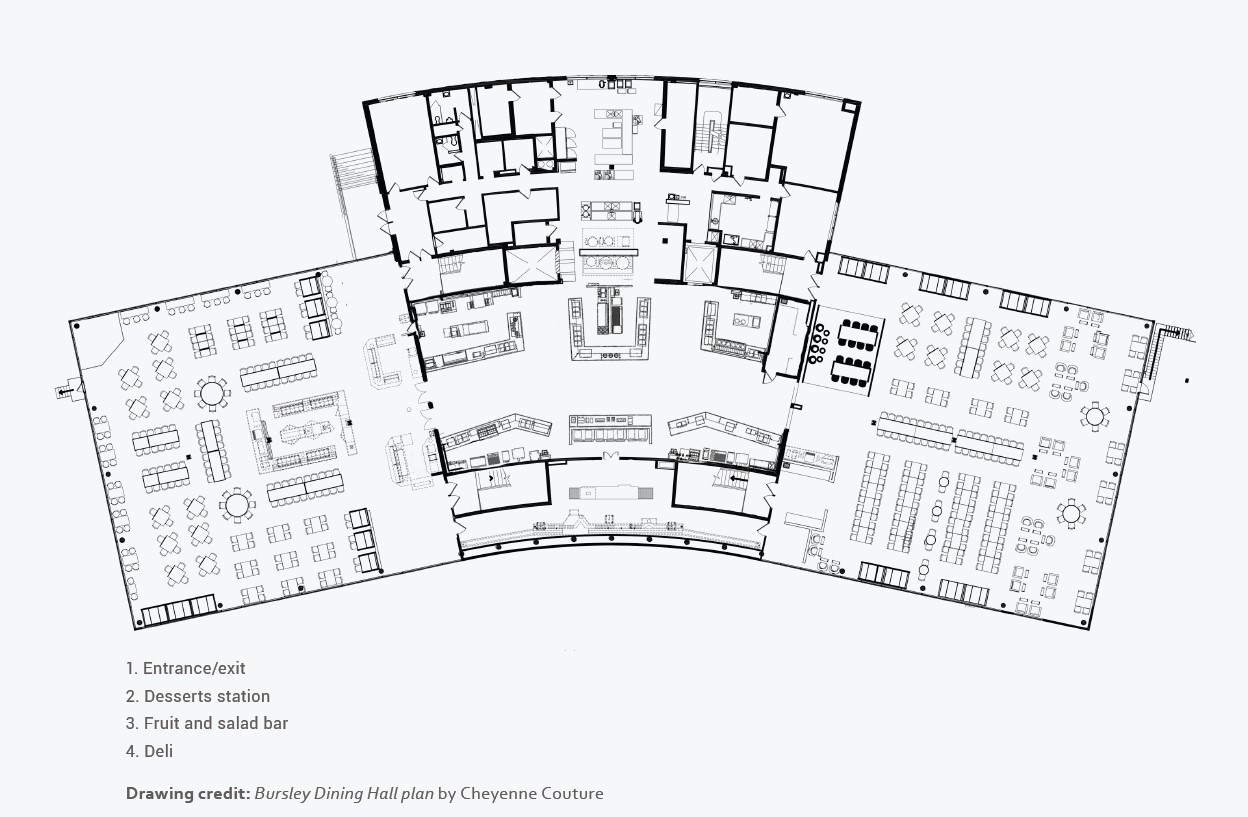
1. Locating restaurants in different areas instead of one major core will promote more physical movement.
2. The incorporation of Dining Halls with two floors instead of one will also promote more physical movement.
3. According to research conducted by Gilston and Privitera (2015), color schemes that include more subtle and neutral colors will increase healthier dining behaviors.
4. With respect to a preceding study (Ittersum & Wansink, 2012), replacing wooden tables with white ones (or white tablecloth) will decrease negative dining practices.
Design to Outcomes
- The distribution of media will inform students regarding the amount of food waste they contribute to as well as daily composting percentages and will prevent them from selecting food they do not consume.
-
Restricting buffet-style dining by charging based on meal/plate weight will promote more careful meal selection and will also prevent students from
wasting food.
-
Placing fruit stations instead of dessert stations near the entrances/exits
will promote the selection of healthier snacks on students’ way out.
-
Placing bigger plates and bows by the fruit and salad bars and smaller plates by the Pizza and Grill restaurants will promote healthier eating habits.
︎
Works Cited
1. Onufrak, S. J., Watson, K. B., Kimmons, J., Pan, L., Khan, L. K., Lee-Kwan, S. H., & Park, S. (2018). Worksite Food and Physical Activity Environments and Wellness Supports Reported by Employed Adults in the United States. American journal of health promotion : AJHP, 32(1), 96–105. https://doi.org/10.1177/0890117116664709
2. Quintiliani, Lisa, Sattelmair, Jacob, and Sorensen, Glorian. (2007). The workplace as a setting for interventions to improve diet and promote physical activity. World Health Organization. https://www.who.int/dietphysicalactivity/Quintiliani-workplace-as-setting.pdf?ua=1
3. Johns Hopkins Bloomberg School of Public Health. Institute for Health and Productivity Studies. ; Centers for Disease Control and Prevention (U.S.) (2016) .Physical Activity in the Workplace: A Guide for Employers. The Institute for Health and Productivity Studies, Johns Hopkins Bloomberg School of Public Health. https://www.jhsph.edu/research/centers-and-institutes/institute-for-health-and-productivity-studies/_docs/archived-projects/WHRN_PA.pdf
4. Siegel, RP (2013). How Biking Improves Employee Productivity. Tripli Pundit the business of doing better. https://www.triplepundit.com/story/2013/how-biking-improves-employee-productivity/59136
︎ SmartEatingWare
How to promote a healthy diet and improving spatial qualities at diverse scales to an healthy office working culture?
By Camy Trinh ︎




Hypothesis
1. Dietary Issues in America
a. The prevalence of obesity was 39.8% and affected about 93.3 million of US adults in 2015~2016 [1]
b. Obesity-related conditions include heart disease, stroke, type 2 diabetes and certain types of cancer that are some of the leading causes of preventable, premature death. [6]
c. The estimated annual medical cost of obesity in the United States was $147 billion in 2008 US dollars; the medical cost for people who have obesity was $1,429 higher than those of normal weight [1]
d. Unhealthy eating and physical inactivity are leading causes of death in the U.S. [5]
e. Unhealthy diet contributes to approximately 678,000 deaths each year in the U.S., due to nutrition and obesity-related diseases [1]
2. Common Causes
a. Genetic conditions [3]
i. Vitamin deficiencies
ii. Eating disorders
b. Overeating/Undereating [2]
i. Depression and anxiety coping mechanism
ii. Socially-induced eating disorders
iii. Different ideas of food portions
3. Current Hit-or-Miss Solutions
a. Weight Watchers
i. Weight Watchers: “diet” inaccurately implies temporary lifestyle changes; differs per person depending their personal mographics and life decisions
b. Attempts to Track Energy Input/Output
i. Smart watches (i.e. Apple Watch, Fitbit)
ii. Personalized settings
1. Dietary Issues in America
a. The prevalence of obesity was 39.8% and affected about 93.3 million of US adults in 2015~2016 [1]
b. Obesity-related conditions include heart disease, stroke, type 2 diabetes and certain types of cancer that are some of the leading causes of preventable, premature death. [6]
c. The estimated annual medical cost of obesity in the United States was $147 billion in 2008 US dollars; the medical cost for people who have obesity was $1,429 higher than those of normal weight [1]
d. Unhealthy eating and physical inactivity are leading causes of death in the U.S. [5]
e. Unhealthy diet contributes to approximately 678,000 deaths each year in the U.S., due to nutrition and obesity-related diseases [1]
2. Common Causes
a. Genetic conditions [3]
i. Vitamin deficiencies
ii. Eating disorders
b. Overeating/Undereating [2]
i. Depression and anxiety coping mechanism
ii. Socially-induced eating disorders
iii. Different ideas of food portions
3. Current Hit-or-Miss Solutions
a. Weight Watchers
i. Weight Watchers: “diet” inaccurately implies temporary lifestyle changes; differs per person depending their personal mographics and life decisions
b. Attempts to Track Energy Input/Output
i. Smart watches (i.e. Apple Watch, Fitbit)
ii. Personalized settings
iii. Attempts to track and monitor physical activity regularly (sleep, steps, exercise)
iv. Optional ability to log food intake, and compare to physical activity
1. Food types and amounts need to be accurate
2. Requires smartphone
- Why?
The challenge I’ve set out to solve is how to create an easier method to identify and measure amounts of foods (to increase accuracy of logging foods into diet programs like Weight Watchers and smart watch food logs). How can we create a product that allows all to be aware of their dietary health, and allows all to easily monitor and regulate their food and drink consumption? Can be used to facilitate weight loss? Meant to promote awareness of food intake and effects on health?
- How?
Creating a product that enables users to easily identify and measure amounts of foods.
1. This product would not necessarily replace a smartwatch or the Weight Watchers Program, but rather it could function independent of these other products, but also have the ability to function in cooperation with these products.
2. For instance, many people already using a smartwatch do not always also participate in Weight Watchers, and vice versa. However, these two products work well in conjunction. What limits the success rate of both of these products is the accuracy of logging foods that the user consumed. My product would simply alleviate the errors in this data, improving the performance of the smartwatch and Weight Watchers.
3. The product itself would likely have a smart camera system installed on the top and bottom of the bowl to best identify the contents. And it would also have a smart sensor at the very bottom of the bowl to accurately read the weight of the contents. A similar system would be deployed across the other variations of this product, such as, in a mug, or even a flat plate.
- What?
Implementing an accurate method to log foods consumed through smart eating-ware will improve adults’ diet and portion control in the United States.
Design Intervention (what/how): X = Smart Eating-ware
Context (where): Y= United States
Sample (with whom): Z= adults
Outcome (your intended outcome): Effective portion control
- So What?
1. Users of the product will likely be surprised by how much the true amount of each item truly weighs. This may lead to frustration, but it will allow users to finally accurately log their foods (which would be done by the equipment itself, without a method to cheat).
2. This accuracy in logging the food will enable more accurate suggestions and results to come out of their Weight Watchers and/or smartwatch usage.
Design to Outcomes
Subjects will take a photo of their usual food portion size (pre-eatingware), then take a photo of their new portion size with eatingware like this:
︎
Works Cited
1. “Adult Obesity Facts.” CDC.gov. target="_blank">CDC.gov. Centers for Disease Control and Prevention. N.d. Web. Feb 2020.
2. Fit. “Are You Overeating or Undereating?” mfit.com. N.d. Web. Feb 2020.
3. Lyons, Libby. “Genetic Factors Behind Eating Disorders.” EatingDisorderHope.com. N.d. Web. Feb 2020.
4. “Overeating & Undereating.” Encinoeatingdisorders.com. N.d. Web. Feb 2020.
5.“Poor Nutrition.” CDC.gov. Centers for Disease Control and Prevention. N.d. Web. Feb 2020.
6. “Why Good Nutrition is Important.” CPSInet.org. Center for Science in the Public Interest. N.d. Web. Feb 2020.
7. “10 ‘Low Fat’ Foods That Are Actually Bad for You.” Healthline.com. N.d. Web. Feb 2020.
︎ Creating Nourishing Environments
An intergenerational community-building fruit and vegetable garden to improve social cohesion and community resilience in fringe populations.
By Priya Bayisetti ︎

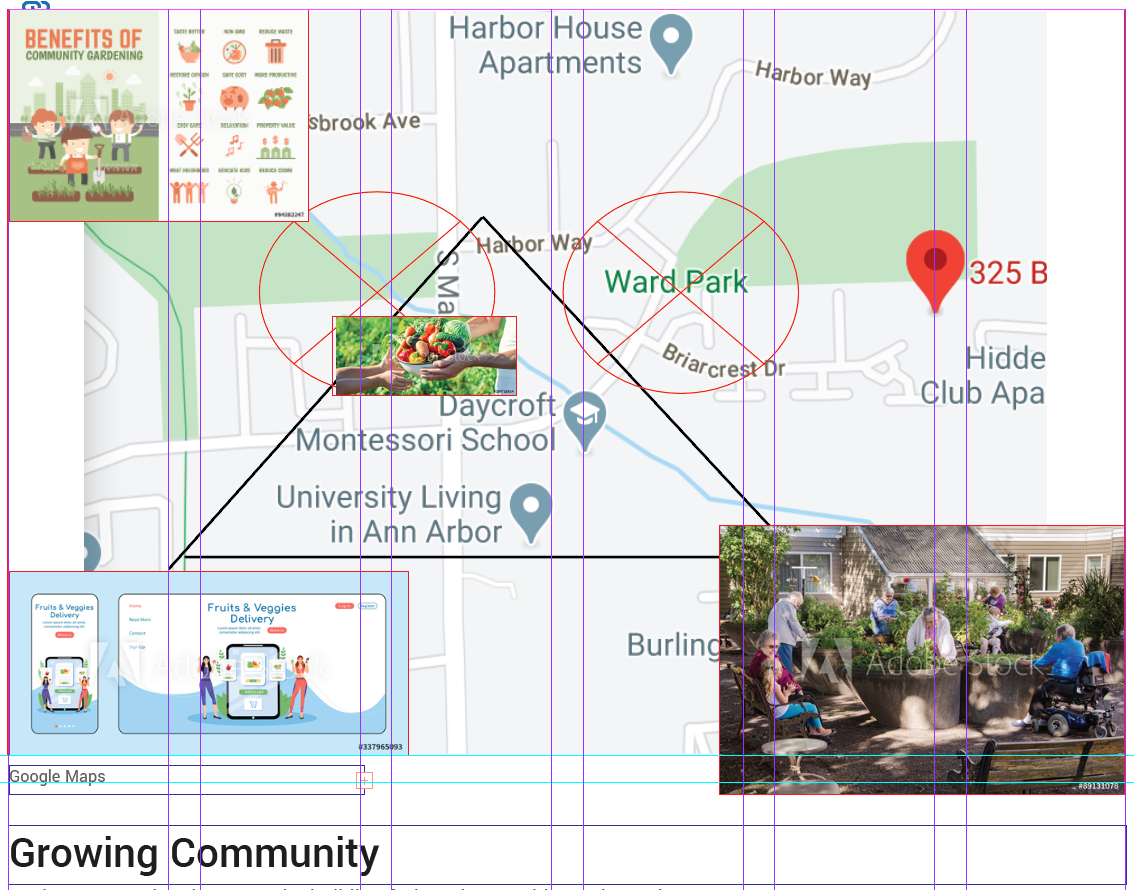
Caption / Source 2020
Project Intro. Lorem Ipsum dolor sit amet, consectetur adipiscing elit, sed do eiusmod tempor incididunt ut labore et dolore magna aliqua. Project pitch in bold for emphasis. Ut enim ad minim veniam, quis nostrud exercitation ullamco laboris nisi ut aliquip ex ea commodo consequat.
Duis aute irure dolor in reprehenderit in voluptate velit esse cillum dolore eu fugiat nulla pariatur. Excepteur sint occaecat cupidatat non proident, sunt in culpa qui officia deserunt mollit anim id est laborum.
Hypothesis
Lorem Ipsum dolor sit amet, consectetur adipiscing elit, sed do eiusmod tempor incididunt ut labore et dolore magna aliqua. Ut enim ad minim veniam, quis nostrud exercitation ullamco laboris nisi ut aliquip ex ea commodo consequat. Duis aute irure dolor in reprehenderit in voluptate velit esse cillum dolore eu fugiat nulla pariatur.
Caption / Source 2020
Lorem Ipsum dolor sit amet, consectetur adipiscing elit, sed do eiusmod tempor incididunt ut labore et dolore magna aliqua. Ut enim ad minim veniam, quis nostrud exercitation ullamco laboris nisi ut aliquip ex ea commodo consequat. Duis aute irure dolor in reprehenderit in voluptate velit esse cillum dolore eu fugiat nulla pariatur. Excepteur sint occaecat cupidatat non proident, sunt in culpa qui officia deserunt mollit anim id est laborum.
Questions
Lorem Ipsum dolor sit amet, consectetur adipiscing elit, sed do eiusmod tempor incididunt ut labore et dolore magna aliqua.
- Who
- What
- Why
- So What
Qualitative Observations: Caption
Methodology
Lorem Ipsum dolor sit amet, consectetur adipiscing elit, sed do eiusmod tempor incididunt ut labore et dolore magna aliqua. Ut enim ad minim veniam, quis nostrud exercitation ullamco laboris nisi ut aliquip ex ea commodo consequat. Duis aute irure dolor in reprehenderit in voluptate velit esse cillum dolore eu fugiat nulla pariatur. Excepteur sint occaecat cupidatat non proident, sunt in culpa qui officia deserunt mollit anim id est laborum.
Subheading
Lorem Ipsum dolor sit amet, consectetur adipiscing elit, sed do eiusmod tempor incididunt ut labore et dolore magna aliqua. Ut enim ad minim veniam, quis nostrud exercitation ullamco laboris nisi ut aliquip ex ea commodo consequat. Duis aute irure dolor in reprehenderit in voluptate velit esse cillum dolore eu fugiat nulla pariatur. Excepteur sint occaecat cupidatat non proident, sunt in culpa qui officia deserunt mollit anim id est laborum.
<replace video below with your link under ‘code view’>
Design to Outcomes
The Growing Community Garden Inititiative is Designed to Create Community Resilience, Increased Social Cohesion, and Increased Sense of Belonging by Creating Intergenerational Opportunities to grow fresh fruit and vegetables in pockets of land between childcare facilities, assisted living facilities, and primary care offices.
︎
Works Cited
Dr Wilfreda E. Thurston & Bilkis Vissandjée (2005) An ecological model for understanding culture as a determinant of women's health, Critical Public Health, 15:3, 229-242, DOI: 10.1080/09581590500372121
Thompson R. (2018). Gardening for health: a regular dose of gardening. Clinical medicine (London, England), 18(3), 201–205. https://doi.org/10.7861/clinmedicine.18-3-201
Soga, M., Gaston, K. J., & Yamaura, Y. (2016). Gardening is beneficial for health: A meta-analysis. Preventive medicine reports, 5, 92–99. https://doi.org/10.1016/j.pmedr.2016.11.007
Howarth, M., Brettle, A., Hardman, M., & Maden, M. (2020). What is the evidence for the impact of gardens and gardening on health and well-being: a scoping review and evidence-based logic model to guide healthcare strategy decision making on the use of gardening approaches as a social prescription. BMJ open, 10(7), e036923. https://doi.org/10.1136/bmjopen-2020-036923
Husk, K., Lovell, R., Cooper, C., Stahl-Timmins, W., & Garside, R. (2016). Participation in environmental enhancement and conservation activities for health and well-being in adults: a review of quantitative and qualitative evidence. The Cochrane database of systematic reviews, 2016(5), CD010351. https://doi.org/10.1002/14651858.CD010351.pub2
Rees, S., & Williams, A. (2009). Promoting and supporting self-management for adults living in the community with physical chronic illness: A systematic review of the effectiveness and meaningfulness of the patient-practitioner encounter. JBI library of systematic reviews, 7(13), 492–582. https://doi.org/10.11124/01938924-200907130-00001
Spano, G., D'Este, M., Giannico, V., Carrus, G., Elia, M., Lafortezza, R., Panno, A., & Sanesi, G. (2020). Are Community Gardening and Horticultural Interventions Beneficial for Psychosocial Well-Being? A Meta-Analysis. International journal of environmental research and public health, 17(10), 3584. https://doi.org/10.3390/ijerph17103584
About HCWH. (n.d.). Retrieved August 12, 2020, from https://www.greenhospitals.net/about-hcwh/
Detweiler, M. B., Sharma, T., Detweiler, J. G., Murphy, P. F., Lane, S., Carman, J., Chudhary, A. S., Halling, M. H., & Kim, K. Y. (2012). What is the evidence to support the use of therapeutic gardens for the elderly?. Psychiatry investigation, 9(2), 100–110. https://doi.org/10.4306/pi.2012.9.2.100
Milligan, C., Gatrell, A., & Bingley, A. (2004). "Cultivating health": therapeutic landscapes and older people in northern England. Social science & medicine (1982), 58(9), 1781–1793. https://doi.org/10.1016/S0277-9536(03)00397-6
Detweiler, M. B., & Warf, C. (2005). Dementia wander garden aids post cerebrovascular stroke restorative therapy: a case study. Alternative therapies in health and medicine, 11(4), 54–58.
Söderback, I., Söderström, M., & Schälander, E. (2004). Horticultural therapy: the 'healing garden'and gardening in rehabilitation measures at Danderyd Hospital Rehabilitation Clinic, Sweden. Pediatric rehabilitation, 7(4), 245–260. https://doi.org/10.1080/13638490410001711416
Scott, T. L., Masser, B. M., & Pachana, N. A. (2020). Positive aging benefits of home and community gardening activities: Older adults report enhanced self-esteem, productive endeavours, social engagement and exercise. SAGE open medicine, 8, 2050312120901732. https://doi.org/10.1177/2050312120901732
Whear, R., Coon, J. T., Bethel, A., Abbott, R., Stein, K., & Garside, R. (2014). What is the impact of using outdoor spaces such as gardens on the physical and mental well-being of those with dementia? A systematic review of quantitative and qualitative evidence. Journal of the American Medical Directors Association, 15(10), 697–705. https://doi.org/10.1016/j.jamda.2014.05.013
Institute of Medicine (US) Food Forum. Providing Healthy and Safe Foods As We Age: Workshop Summary. Washington (DC): National Academies Press (US); 2010. 5, Nutrition Concerns for Aging Populations. Available from: https://www.ncbi.nlm.nih.gov/books/NBK51837/
Noguchi, T., Kondo, K., Saito, M., Nakagawa-Senda, H., & Suzuki, S. (2019). Community social capital and the onset of functional disability among older adults in Japan: a multilevel longitudinal study using Japan Gerontological Evaluation Study (JAGES) data. BMJ open, 9(10), e029279. https://doi.org/10.1136/bmjopen-2019-029279
Wendelboe-Nelson, C., Kelly, S., Kennedy, M., & Cherrie, J. W. (2019). A Scoping Review Mapping Research on Green Space and Associated Mental Health Benefits. International journal of environmental research and public health, 16(12), 2081. https://doi.org/10.3390/ijerph16122081
Detweiler, M. B., Sharma, T., Detweiler, J. G., Murphy, P. F., Lane, S., Carman, J., Chudhary, A. S., Halling, M. H., & Kim, K. Y. (2012). What is the evidence to support the use of therapeutic gardens for the elderly?. Psychiatry investigation, 9(2), 100–110.https://doi.org/10.4306/pi.2012.9.2.100
︎ Indoor/Outdoor Shed
Multi-Purpose Shed at the University of Michigan.
By Areej Shahin ︎
The ongoing COVID-19 pandemic has significantly impacted the mental health of individuals throughout the United States and the world.
Returning to campus will be difficult for students and faculty if they do not have spaces that will allow them to engage and socialize safely with their peers. Physical distancing will be required when schools reopen but most schools across the United States were not built to accommodate students 6 feet apart inside their buildings.
By Areej Shahin / August 2020
Hypothesis
So by designing a shed that provides both indoor and outdoor spaces and can be mobilized at different places across campus it will not only accommodate social distancing and allow students and faculty to engage and communicate safely during this pandemic but also, it will help improve students and faculty well-being.
By Areej Shahin / August 2020
Components of the Shed:
- Movable garage door: it could be open to the outside area in the pleasant months and could be closed in the winter to have closed inside space.
- Mobilized wooden blocks: the wooden blocks can be used as flexible furniture which could be placed inside and outside. Also, these blocks can provide more seating areas to space by extending the stairs.
- Windows: that are designed to improve the airflow and to increase the natural light.
This shed is a multipurpose shed. The first purpose is to have outside areas that are placed around campus. Research shows that outdoor areas are the most beneficial and safest spaces to be in during the pandemic. So by using the mobilized wooden blocks students can gather around with their peers during lunch and break time outside this shed, also there is a shaded outdoor area in the back of the shed that can be used also as a gathering area.
Using outdoor spaces will reduce the burden on indoor classrooms while providing fresh air, hands-on learning opportunities, and health benefits associated with increased access to nature.
However, due to Michigan’s weather, this idea could not be approached in the winter semester. Therefore, The design of the shed allows to have an indoor space that could be used as study groups, tutorial sessions, and classrooms for students and faculty. In addition, there are windows that are designed to improve the airflow and to increase the natural light in the space as research shows that by opening windows the rate of airflow can dilute virus particles.
Design to Outcomes
The primary outcome of this proposal is having better social interaction when returning to campus to help improve mental and physical health for students and faculty. Second, this intervention will provide a good learning environment with better air-flow and natural sunlight.
Also, this shed can be used after the pandemic as multiple purpose community space that supports inhabitants of the University of Michigan and across The United States.
Prototype multiple purposes shed that provides both indoor and outdoor space which could be mobilized at different places across campus
︎
Works Cited
1. Malani, M.D., Preeti N. "Managing Pandemic Health Risks on College Campuses." , The New York Times, 13 Aug. 2020, www.nytimes.com/2020/08/13/well/family/coronavirus-pandemic-college-campuses-student-health.html
2. DUCHARME, JAMIE. "Spending Just 20 Minutes in a Park Makes You Happier. Here's What Else Being Outside Can Do for Your Health." , 28 Feb. 2019, time.com/5539942/green-space-health-wellness/
3. "Indoor Air and Coronavirus (COVID-19)." , United States Environmental Protection Agency, 2020, www.epa.gov/coronavirus/indoor-air-and-coronavirus-covid-19
4. N.H., HANOVER. "COVID-19 Increased Anxiety, Depression for Already Stressed College Students." , Dartmouth, 24 July 2020, www.dartmouth.edu/press-releases/covid-19-stressed-college-students.html.
5. "Outdoor Infrastructure Planning Strategies for Taking Learning Outside as Schools Reopen." , Green School yards, www.greenschoolyards.org/outdoor-infrastructur
︎ Campus COVID-19 Dashboard
An interactive dashboard that highlights current safety standards and displays data in an empathetic manner.
By Stephanie Schouman ︎

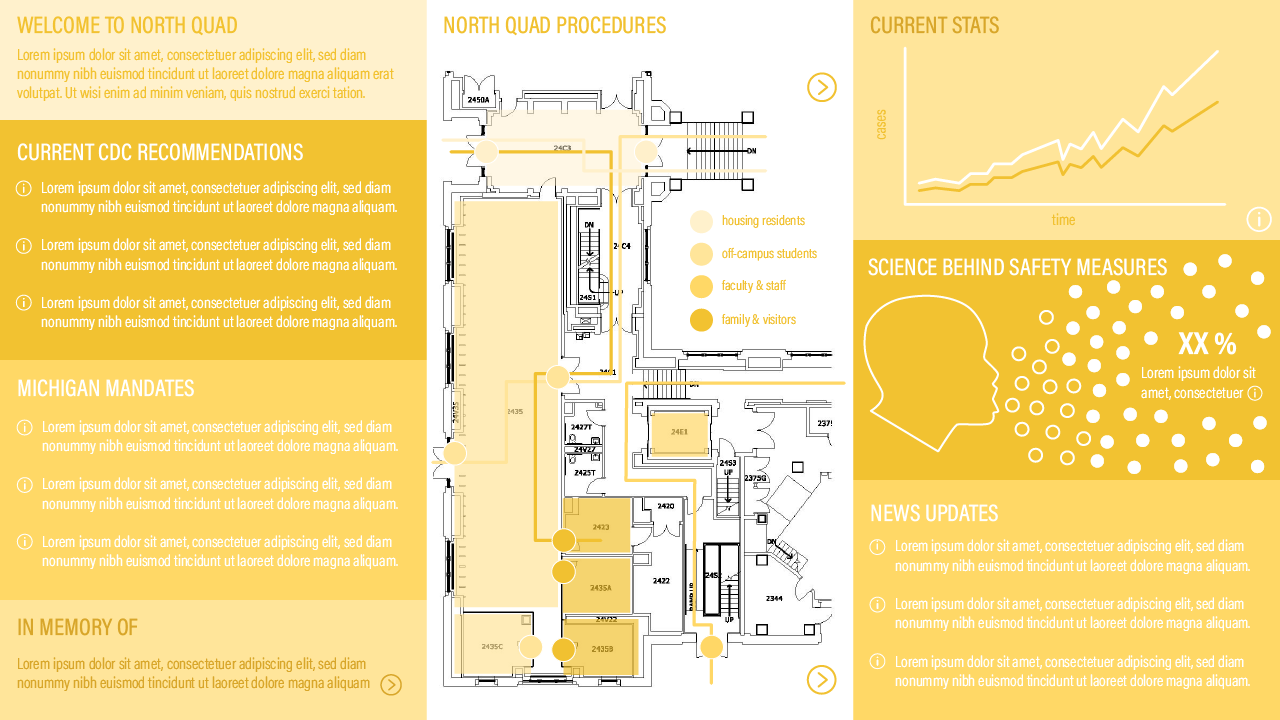
Landing page of dashboard / Schouman 2020
Alongside the COVID-19 global pandemic there has been widespread confusion and misleading information surrounding transmission of the virus, mortality rates, number of cases, and what the general public should do to keep each other safe. Information surrounding the current situation is changing almost every day and it can be difficult to stay informed and know which sources to trust.
When the actions of individuals directly impact the health of the general public, it is also crucial that the data and information being shared highlights the importance of adhering to safety standards in the convincing way With students returning to campus and campus-specific safety measures being put in place, the University of Michigan needs to recognize the need for a centralized space to host health and safety information.
Hypothesis
The University of Michigan should consolidate information, for both campus-specific and nationwide safety recommendations, and create a information hub for students and staff to consume the most relevant COVID-19 related data. This tool should have links to external sources and visualizations to reduce the cognitive load of the viewer. Using compelling visuals and allowing users to validate information, this dashboard can help students and staff feel informed, feel confident in their understanding, and stay safe on campus.
Consolidated Information Elements
One key piece of this tool is gathering and sorting the most relevant and up-to-date information surrounding the virus and the pandemic as a whole.
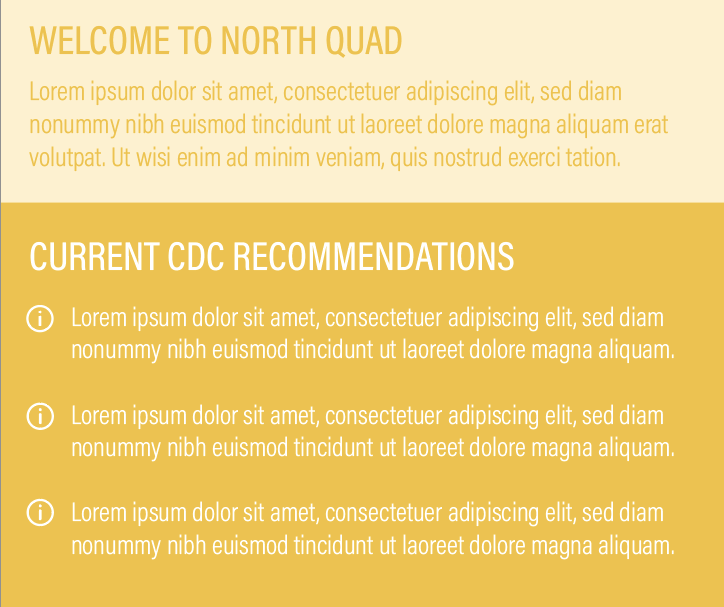
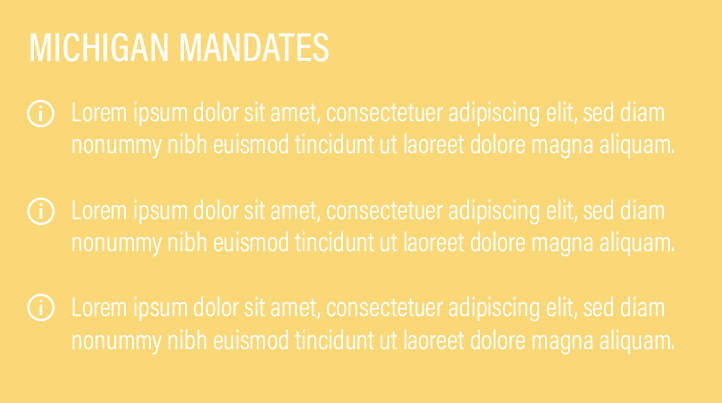
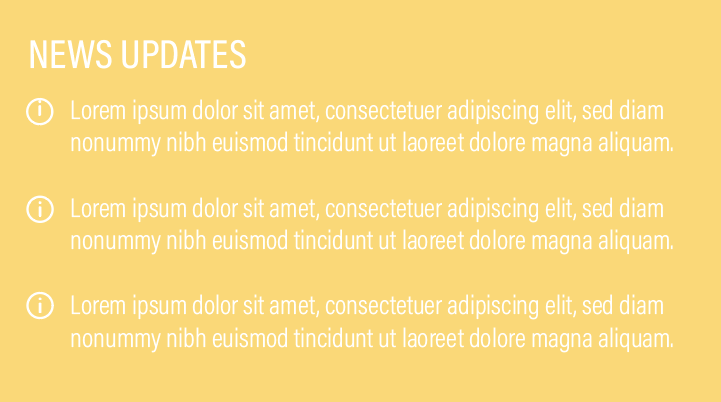
Consolidated Information Panels
By only displaying a few recommendations or safety measures at a time, users are able to quickly and effectively consume this information. The icons to the left of each bullet link to credible sources for users to further validate and explore this information.
Empathetic Data Elements
Qualitative Observations: Caption
Methodology
Lorem Ipsum dolor sit amet, consectetur adipiscing elit, sed do eiusmod tempor incididunt ut labore et dolore magna aliqua. Ut enim ad minim veniam, quis nostrud exercitation ullamco laboris nisi ut aliquip ex ea commodo consequat. Duis aute irure dolor in reprehenderit in voluptate velit esse cillum dolore eu fugiat nulla pariatur. Excepteur sint occaecat cupidatat non proident, sunt in culpa qui officia deserunt mollit anim id est laborum.
Subheading
Lorem Ipsum dolor sit amet, consectetur adipiscing elit, sed do eiusmod tempor incididunt ut labore et dolore magna aliqua. Ut enim ad minim veniam, quis nostrud exercitation ullamco laboris nisi ut aliquip ex ea commodo consequat. Duis aute irure dolor in reprehenderit in voluptate velit esse cillum dolore eu fugiat nulla pariatur. Excepteur sint occaecat cupidatat non proident, sunt in culpa qui officia deserunt mollit anim id est laborum.
<replace video below with your link under ‘code view’>
Design to Outcomes
Lorem Ipsum dolor sit amet, consectetur adipiscing elit, sed do eiusmod tempor incididunt ut labore et dolore magna aliqua. Ut enim ad minim veniam, quis nostrud exercitation ullamco laboris nisi ut aliquip ex ea commodo consequat. Duis aute irure dolor in reprehenderit in voluptate velit esse cillum dolore eu fugiat nulla pariatur. Excepteur sint occaecat cupidatat non proident, sunt in culpa qui officia deserunt mollit anim id est laborum. Closing statement in bold for emphasis.
︎
Works Cited
Jeremy Boy, Anshul Vikram Pandey, John Emerson, Margaret Satterthwaite, Oded Nov, Enrico Bertini. “Showing People Behind Data: Does Anthropomorphizing Visualizations Elicit More Empathy for Human Rights Data?” ACM CHI Conference. 6-11 May 2017.
Kim Bui. “Designing data visualisations with empathy.” DataJournalism.com. 11 June 2019.
Michael Correll. “Ethical Dimensions of Visualization Research.” Tableau Research. ACM CHI Conference. 4-9 May 2019.
Joanna Sleigh, MA; Manuel Schneider, MSc; Julia Amann, PhD; Effy Vayena, PhD. “Visualizing an Ethics Framework: A Method to Create Interactive Knowledge Visualizations From Health Policy Documents.” Journal of Medical Internet Research. 2020.
Alli Torban. “Critiquing data visualizations: A discussion on channeling empathy and productivity.” Tableau Research. 10 May 2019.
Mushon Zer-Aviv. “DataViz - The UnEmpathetic Art.” RD. 2020.
︎ [Student] Housing is Health
Strategies for healthier student housing, specifically as they relate to two bedroom apartments, using the existing Northwood IV student housing complex at the University of Michigan as an example.
By Noah Russin ︎

On campus housing is an essential part of college and university life. However, as a result of the pandemic, while vacancy rates are high, schools are developing strategies to combat the spread of disease.
This presentation focuses on design strategies schools can potentially use to create healthier student housing. One of the University of Michigan’s student housing options, Northwood IV, is used as an example to showcase these strategies, specifically as it relates to two-bedroom apartments.
The University of Michigan offers a variety of on-campus student housing ranging from one-bedroom apartments to four-bedroom suites. Northwood IV boasts the availability of a two-bedroom apartment equipped with a shared kitchen, shared bathroom, a study area, and a combined dining and living room (Michigan Housing).
College and university housing present an important question which design can help answer: How can students maintain health and wellbeing while sharing an apartment and apartment complex?
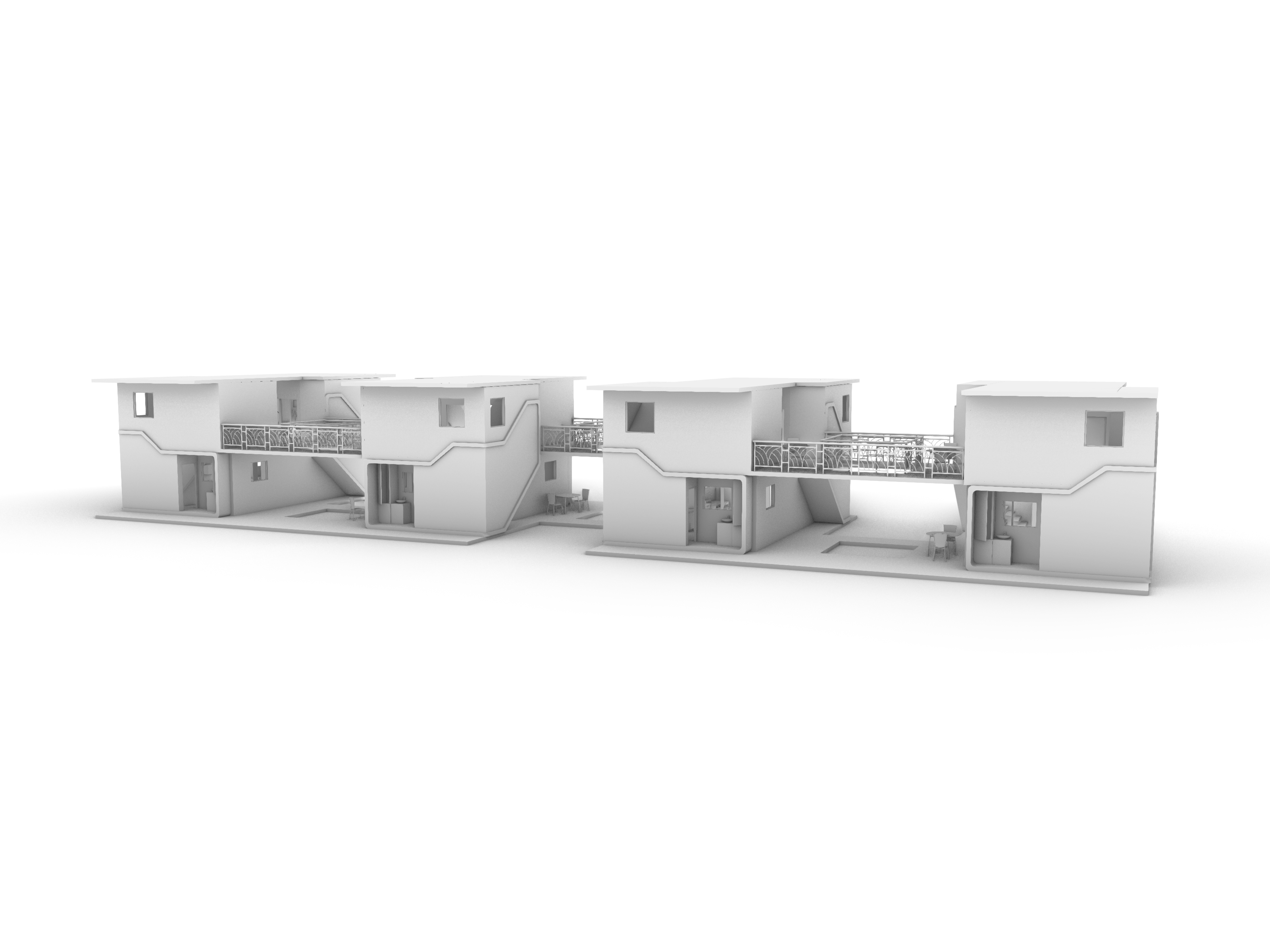
By Noah Russin, August 2020
Hypothesis: Each of the interventions introduced, using the University of Michigan’s existing Northwood IV student housing as an example, will allow for a healthier student population.

By Noah Russin, August 2020
The first strategy for improving health safety in the University of Michigan’s student housing is to separate the massing of each apartment. Design should consider allowing for more distance between students upon approaching their units, therefore reducing the likelihood of transmission.
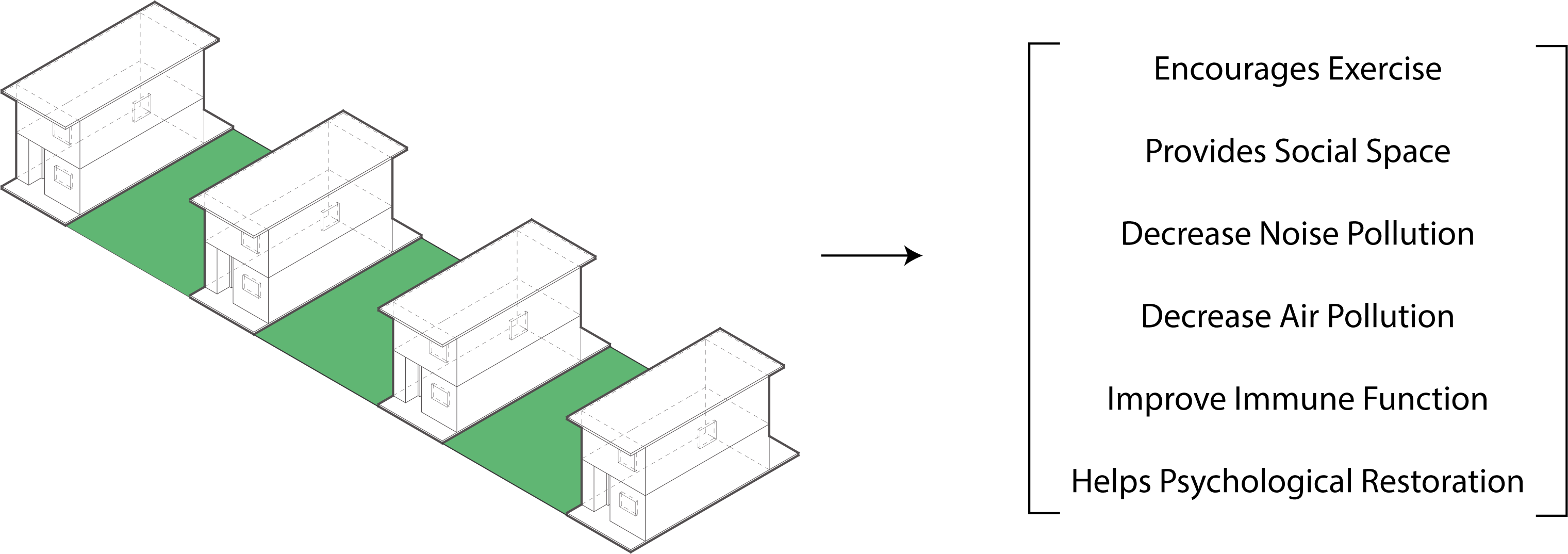
By separating the massing of each apartment, more green space can be introduced between apartments. According to Earth Observatory at NASA, “green space is good for mental health” (NASA). “It can encourage exercise, provide spaces for socializing, decrease noise and air pollution, and improve immune function by providing exposure to beneficial microbiota. It also can help with psychological restoration; that is, green space provides a respite for over-stimulated minds” (NASA). We all know how over-stimulating academic settings can be. Research from World Resources Institute found “urban trees in the United States could yield $25 million in savings just in air pollution related health care costs and lost workdays” (Thomson Rueters Foundation). These benefits are crucial when extrapolated to a campus setting. Students often find themselves over-worked and over-stressed and a simple solution to this is the introduction of more and better green spaces, especially close to where students live.
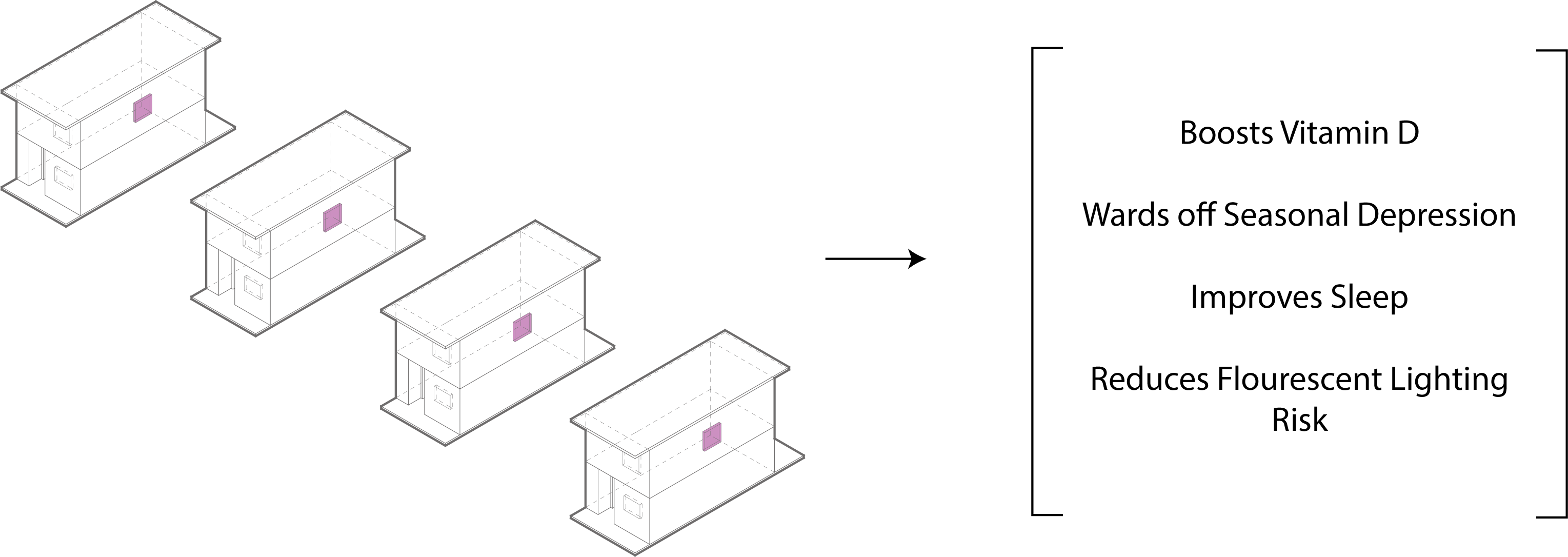
By separating the massing of each apartment, more windows can be introduced so that the full benefits of greater green space can be experienced. This can be accomplished because walls are no longer being shared by adjacent apartments. This also allows for more windows to be southern facing in order to consistently face the Sun in the northern hemisphere, allowing them to make the most of solar gain by letting natural light shine through while absorbing heat. According to Healthline, “natural light provides measurable health benefits by boosting vitamin D, warding off seasonal depression, improving sleep, and reducing the health risks associated with fluorescent lighting” (Garone).

Since walls are no longer being shared by adjacent apartments, the risk of noisy neighbors is essentially eliminated. This is ideal for a university setting especially during a pandemic. It can be difficult to concentrate or converse via video conferencing with noisy neighbors. By separating the massing of the apartments, noise is significantly reduced.
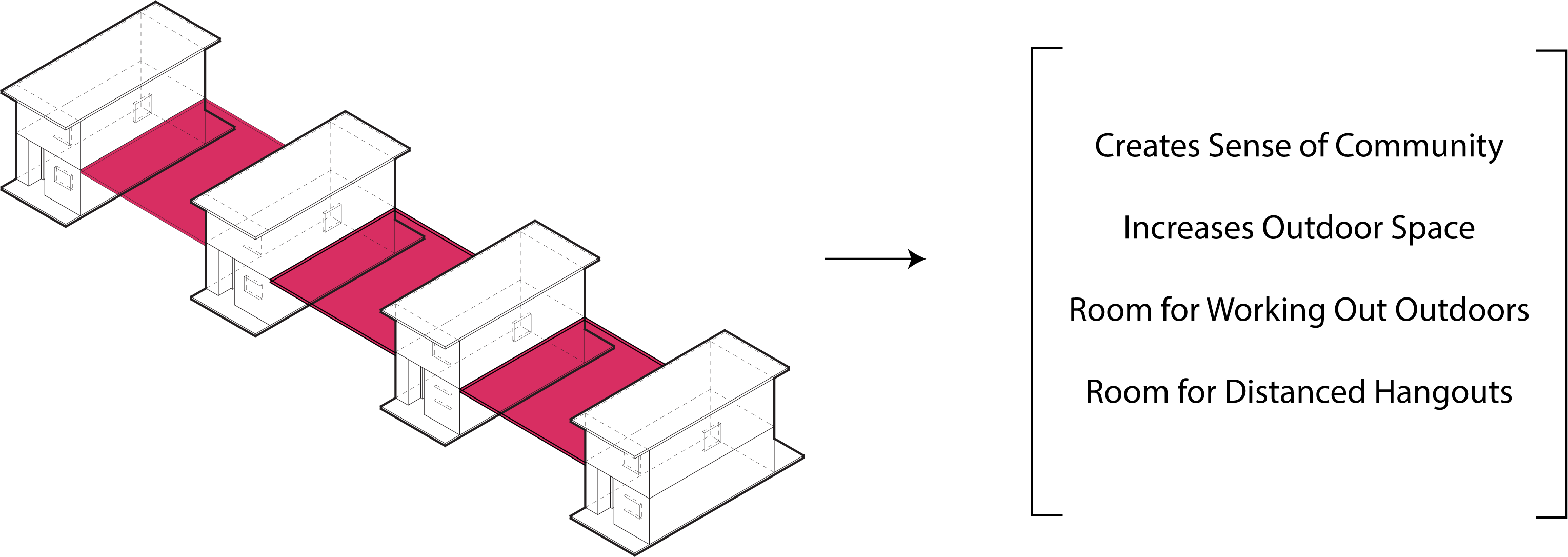
By separating the massing of each apartment, a feeling of community can be somewhat lost. By physically distancing apartments from each other, residents are also physically distanced. This can be beneficial in terms of reducing the risk of transmission but can be detrimental in terms of fostering social space and a sense of community. By connecting the second level balconies into one cohesive platform, a greater sense of community can be accomplished, while also increasing balcony and outdoor space for each resident. This provides space that can be used for working out, social hangouts both distanced and non-distanced, studying outdoors, and more. It also allows for neighbors to be more easily connected, which is not always the best thing. In order to separate the visual connection from a person’s bedroom to the balcony, no windows are adjacent to the balcony and the balcony is staggered to reflect the interior layout of the apartments.
Each of the interventions mentioned to this point reflect health measures between apartments but not within them. A student should not have to worry if their roommate is experiencing symptoms or has tested positive that the disease will automatically be transmitted to them. The layout of each apartment reflects this worry and introduces various interventions as means to combat this risk.
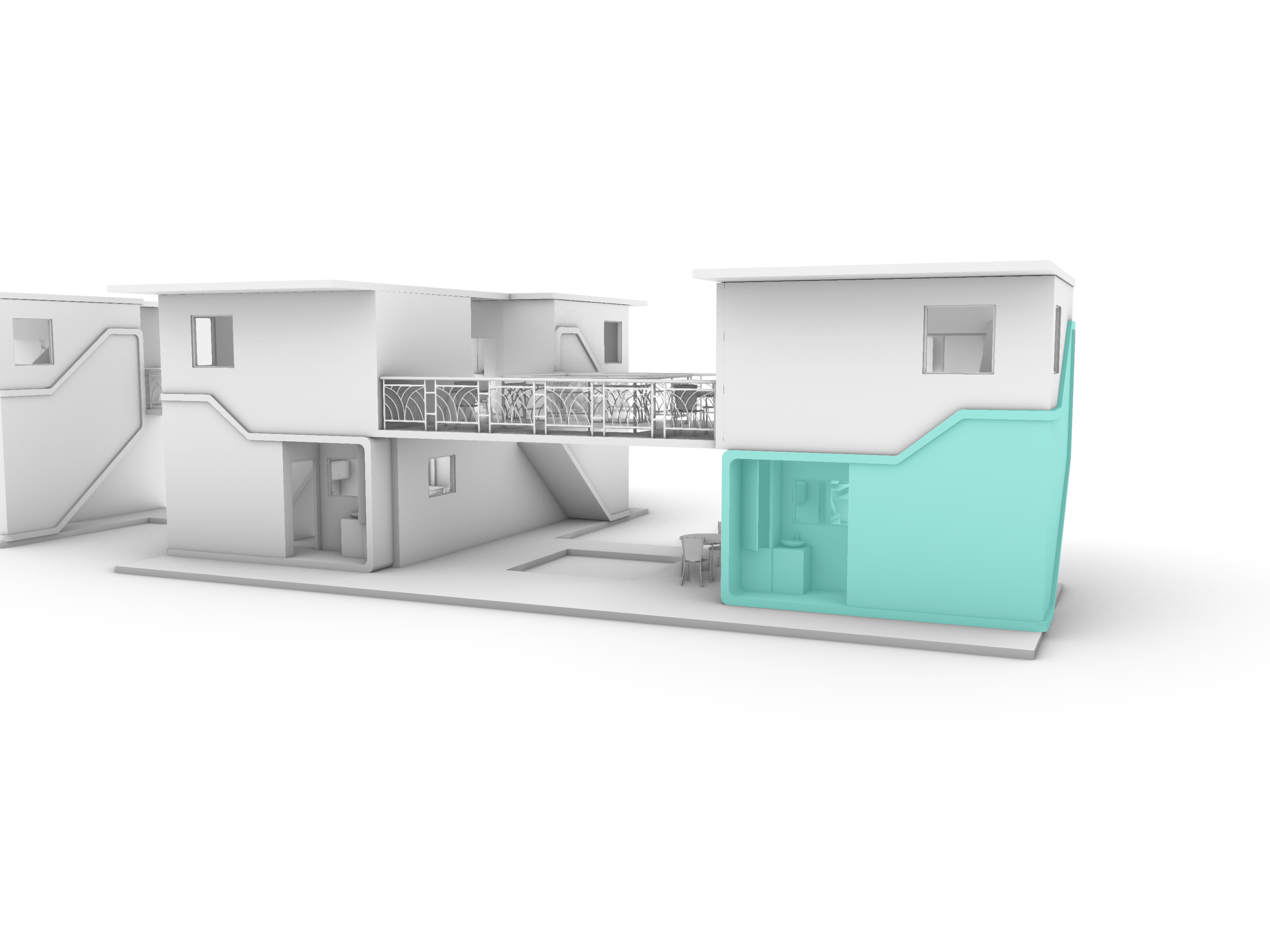
Upon approaching the two-bedroom units, the residents will notice that they each have their own entry way and circulation. This significantly reduces the possibility of transmission by physically separating high touch surfaces and shared air space which would otherwise exist if there was only one entryway and one set of stairs.
The threshold between outdoors and indoors becomes a particularly important tool in separating sanitized space from un-sanitized space. As opposed to just being a wall with a door for entry, the threshold should rather be utilized as a space that allows one to wipe down or wash away any fear of disease compromised materials. Adjacent to the front door for each resident, exists a small locker and a sink. This allows the student to place any potentially compromised materials such as a jacket, coat, sneakers, or other items which may have come into contact with the disease in the locker before entering the apartment. It also allows and emphasizes the importance of washing hands before entering the apartment. This space can also be utilized during times of health. The locker can used for extra storage and is a great place to keep an umbrella or an extra jacket for those especially cold days in Michigan.
Upon entering the apartment and within the threshold space also exists circulation for each resident to reach the second floor of the apartment. By creating a separate circulation space, residents do not have to worry about using the same air space or railing with a potentially sick roommate.
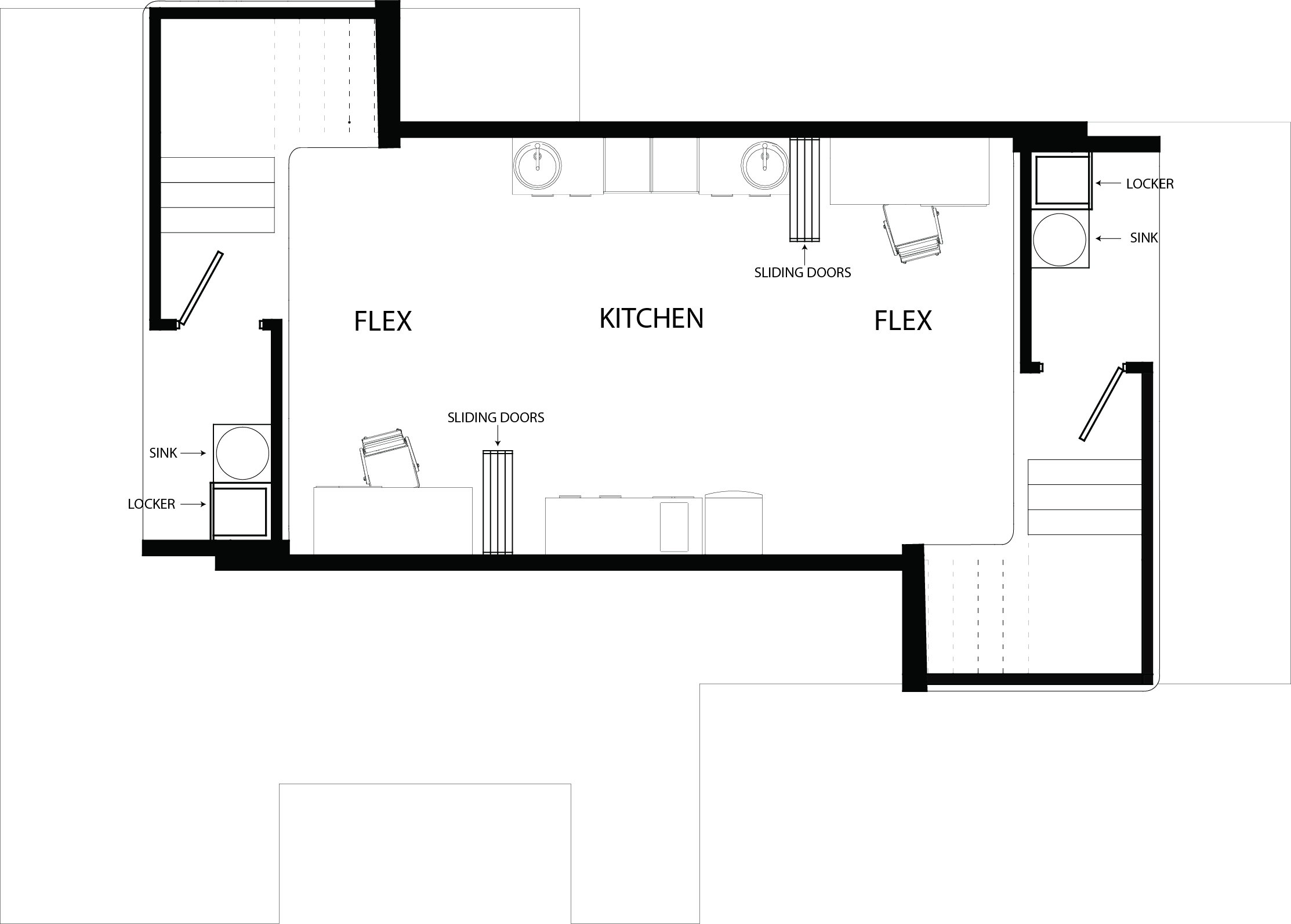
On the first level of each apartment exists two flex spaces, one for each resident, and a shared kitchen equipped with a stove oven, refrigerator, two sinks, and plenty of storage space.
The flex spaces provide a large enough area to be utilized in whatever way the student likes. This space can be used for schoolwork, working out indoors, dining, socializing and more. The two flex spaces are separated by the shared kitchen. Sliding glass panels allow each resident to close themselves off when they feel necessary. The glass panels can be closed off on either side of the kitchen so as to provide more flexibility and options when needed. These panels can be closed off if one roommate is sick or has tested positive for the disease. It can also be closed off when one student is trying to focus on work while the other cooks or has friends over. The panels provide a distancing measure while also retaining the importance of visual connectivity.

During times of pandemic, the first floor can be effective in separating a compromised roommate from a healthy one. The two residents can negotiate who has access to the kitchen and can choose to slide whichever of the two sets of panels makes the most sense. During times of health, the panels can be slid back into place and the first floor can be shared between the roommates.
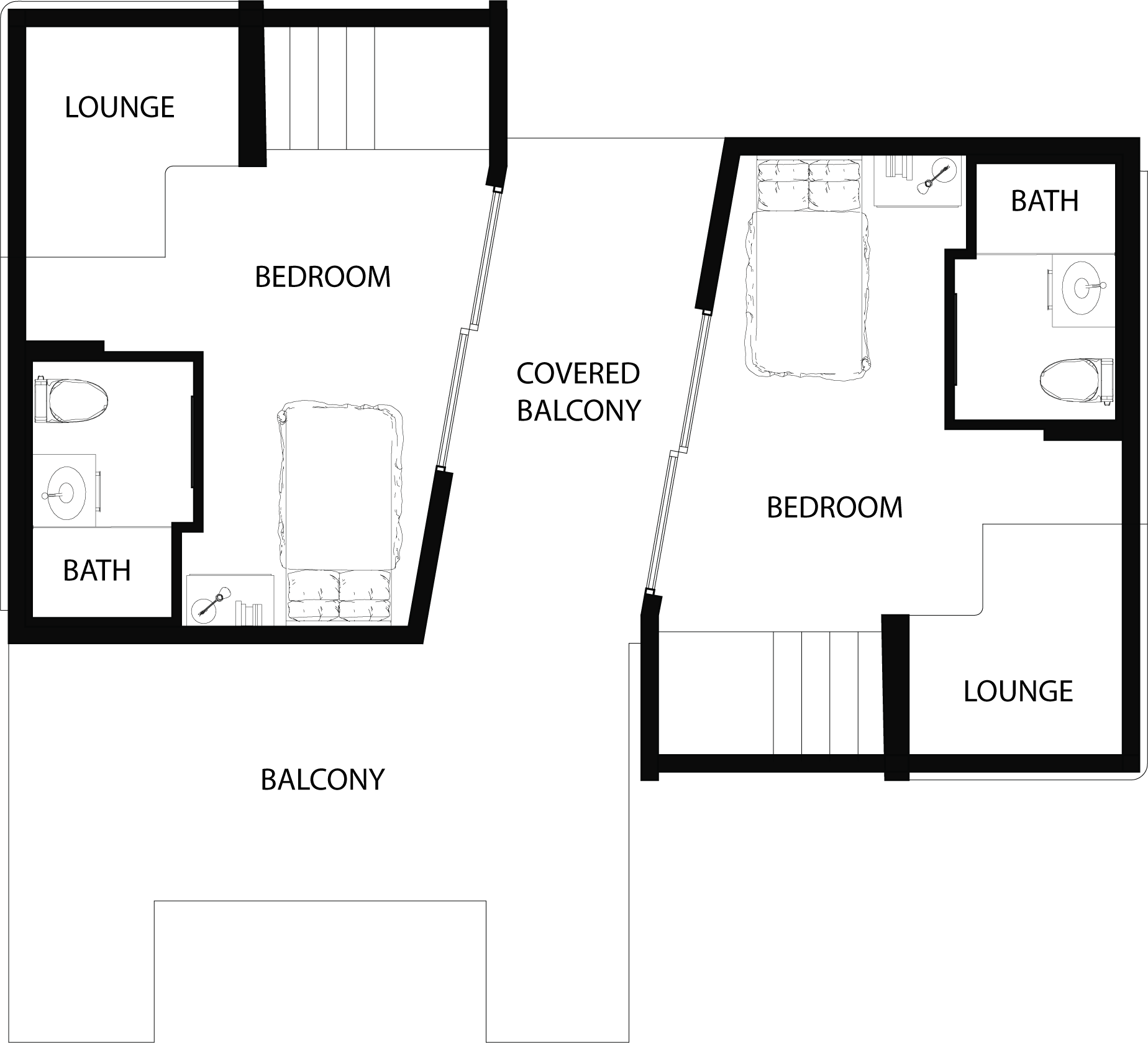
After ascending their respective stairs to the second floor, the resident will find themselves in their own bedroom. The second floor consists of two bedrooms, one for each resident, with an open but covered balcony space between them. The bedrooms come with their own bathroom, bed, and lounge area. Because each resident has their own bathroom, as opposed to a shared one, the risk associated with sharing bathroom space with a potentially sick roommate is eliminated.
The balcony space between the bedrooms allows for better ventilation of the whole space. Between the sliding glass doors and the operable windows, the apartment can be opened up to vent any compromised air particles thus reducing the risk of disease spreading amongst roommates.
Testing the Hypothesis
In order to test whether the hypothesis is correct or not, a study can be conducted to analyze students’ health and production before and after these strategies are implemented. This can be done through surveys as well as statistical analyses of the health of the student population. If health improves and students feel comfortable, safe, and productive in the new space that utilizes these strategies, then the hypothesis is correct.
The Bottom Line
Understandably, a college or university might be hesitant to apply these interventions. Most of these interventions imply an increase in cost in terms of construction. By separating the massing of the building, more walls need to be constructed. By introducing more windows, a larger balcony, more sinks, sliding glass panels, and a spatially larger design, construction costs will surely increase.
However, these costs can be mitigated when taking a holistic approach to university financing. Typically, in order for a college to pay for a new building or to renovate an existing building a combination of revenue, contingency savings, federal bonds and grants, state bonds and grants, public-private partnerships, or donors are used (Kroll).
A public-private partnership can potentially be utilized to deliver this project. A private developer is incentivized to complete this project because although the rents must be affordable, the occupancy rate will almost always be 100%. This means that all of the apartments will most likely be booked reducing the risk associated with financing the project. When considering what students will want in choosing housing, health safety will be at the front of everyone’s minds following this pandemic. This design clearly delivers that need which again shows the likelihood of a 100% occupancy rate. This reduction in risk and the partnership in and of itself reduces the costs.
Typically, a university will also hold a contingency fund. This fund is designed to be used when economic struggles are experienced. This pandemic presents the perfect reason for a university to utilize these savings in order to provide for the student population. When analyzing the cost benefit relationship of doing so a few issues should be considered. First, if a university does not provide the necessary health safety measures for on campus housing then it automatically will be competing with nearby residences as well as other schools who are introducing health safety measures. If the student population as a whole and the student population who choose to live on campus diminishes, the university will have a difficult time financially. The cost of constructing these interventions is significantly less when compared to the costs associated with losing a portion of the student population.
Schools also need to consider the health benefits of these interventions and their associated cost decreases. It is likely that due to these interventions the college or university will experience a healthier overall student population. This decreases the cost burden put on academic health institutes therefore reducing the net bottom line for the school. By providing a health safety intervened building, the school will likely experience savings in other areas of their financing, again reducing the overall cost associated with delivering this project.
︎
Works Cited
Alati, Danine. “These Are the 7 Requests Clients Will Make Post COVID-19.” Architectural Digest, 22 May 2020, www.architecturaldigest.com/story/these-are-the-7-features-clients-will-be-requesting-post-covid-19.
Chayka, Kyle, et al. “How the Coronavirus Will Reshape Architecture.” The New Yorker, 17 June 2020, www.newyorker.com/culture/dept-of-design/how-the-coronavirus-will-reshape-architecture.
Davies, Sophie. “Sliding Walls, Hideable Offices: How Pandemic Could Change Home Design.” Reuters, Thomson Reuters, 4 Aug. 2020, www.reuters.com/article/us-health-coronavirus-global-homes/sliding-walls-hideable-offices-how-pandemic-could-change-home-design-idUSKCN2500FY.
Foundation, Thomson Reuters. “Sliding Walls: How Pandemic Could Change Home Design.” News.trust.org, 4 Aug. 2020, news.trust.org/item/20200804114129-f29h2/.
Garone, Sarah. “11 Things to Know About Natural Light and Your Health.” Healthline, Healthline Media, 3 Oct. 2018, www.healthline.com/health/natural-light-benefits.
“Green Space Is Good for Mental Health.” NASA, NASA, 2019, earthobservatory.nasa.gov/images/145305/green-space-is-good-for-mental-health.
Kroll, Karen. “Types of Funding for Construction Projects on Campus |.” University Business Magazine, 12 Nov. 2019, universitybusiness.com/capital-projects-5-ways-to-pay/.
Mackres, Eric. “Insights from Big Data on How COVID-19 Is Changing Society.” World Resources Institute, 22 July 2020, www.wri.org/blog/2020/05/insights-big-data-how-covid-19-changing-society.
“Northwood III.” Michigan Housing, 10 Aug. 2020, housing.umich.edu/residence-hall/northwood-iii/.
Ogundehin, Michelle. “‘In the Future Home, Form Will Follow Infection.’” Dezeen, 4 June 2020, www.dezeen.com/2020/06/04/future-home-form-follows-infection-coronavirus-michelle-ogundehin/.
“Risk Management Plan for Buildings.” The American Institute of Architects, 2020, www.aia.org/resources/6299432-risk-management-plan-for-buildings.
︎ Lunchables: REthought
How can we mitigate that through providing a product that covers the 4 A’s and also benefits kid’s nutrition?
By Aidan Barron ︎ , Zoe Elliott ︎ , Maya Fraser ︎

Hypothesis
We target elementary school children for a healthy-eating intervention because eating habits as kids can affect eating habits for life. School is a convenient point of access.
Currently, a fair number of these aren’t snacks. The whole meals are convenient and great but the lack of snacks is concerning. Those that are snacks such as the Good& Gather aren’t marketed to children specifically. Paw Patrol snacks on the other hand are appealing but the overall convenience is overridden by the poor quality of the food. Our goal is to make a product that is fun and appealing to kids, healthy, has a good variety and is affordable and available to parents and kids.
We target elementary school children for a healthy-eating intervention because eating habits as kids can affect eating habits for life. School is a convenient point of access.
Currently, a fair number of these aren’t snacks. The whole meals are convenient and great but the lack of snacks is concerning. Those that are snacks such as the Good& Gather aren’t marketed to children specifically. Paw Patrol snacks on the other hand are appealing but the overall convenience is overridden by the poor quality of the food. Our goal is to make a product that is fun and appealing to kids, healthy, has a good variety and is affordable and available to parents and kids.
- Why?
Obesity is an increasing problem among children. Around 20% of children are obese, and these numbers are even worse among Hispanic (26%) and Black (25%) children (1). People who are obese in childhood are five times more likely to be obese as adults than those of normal weight (2), so tackling obesity in children is the easiest way to tackle obesity in adults.
- How?
Introducing kids to healthy foods in a fun and appealing way will help them get used to vegetables and establish eating patterns into adulthood.
- What?
Snack food for kids is often very unhealthy. We propose a healthy alternative to the popular Lunchable snack kits. Our design will use fun packaging and a points rebate system to get kids excited about the product. We pay special attention to creating an appealing mix of textures, colors, and shapes to entice kids towards the product.
- So What?
When kids choose our REthough Lunchables, they will consume fewer calories and receive more nutrients than traditional snacks. They will also form a habit of eating vegetables that will continue on into adulthood. The intervention will help prevent obesity for kids in the present and the future adults they will become.

Design to Outcomes
Popular advertising techniques (use of fun characters, bright colors) have been shown to be effective for advertising healthy food in school cafeterias (3).
︎︎︎Download Lunchables: REthought Poster
︎
Works Cited
1. Fryar CD, Carroll MD, Afful J. Prevalence of overweight, obesity, and severe obesity among children and adolescents aged 2–19 years: United States, 1963–1965 through 2017–2018. NCHS Health E-Stats. 2020
2. Simmonds M, Llewellyn A, Owen CG, Woolacott N. Predicting adult obesity from childhood obesity: a systematic review and meta-analysis. Obes Rev. 2016;17(2):95-107. doi:10.1111/obr.12334
3. Hanks, A. S., Just, D. R., & Brumberg, A. (2016). Marketing Vegetables in Elementary School Cafeterias to Increase Uptake. Pediatrics. https://doi.org/10.1542/peds.2015-1720
︎ The Conscious Life
How to encourage people to explore their city through incentivising getting out and moving?
By Elyssa Bakker ︎ , Erica Behm ︎


Hypothesis
The Conscious Life will help residents and visitors learn about resources and activities available to them to maintain a healthy / fun lifestyle through the use of a mobile application that will reward users with coupons to healthy food options and recreational activities upon completion of tasks.
The Conscious Life will help residents and visitors learn about resources and activities available to them to maintain a healthy / fun lifestyle through the use of a mobile application that will reward users with coupons to healthy food options and recreational activities upon completion of tasks.
- Why
Encourage people to explore their city through incentivising getting out and moving!
- How
Through the use of location tracking + app technology, push notifications delivered at points of decisioncan remind or informpeople of alternative, more active modes of transport.
- What
The Conscious Life is a mobile application that rewards individuals with coupons for: healthy food options, groceries, gym trainers or memberships, and recreational activities. While walking about the city and getting exercise The Conscious Life will provide locations for installations, architecture, and unique hidden locations. The Conscious Life sends notifications periodically reminding people of their ability to make use of the space they have and reach their goals!
- So What
The goal is to get people engaged with their city in a healthy way. The Conscious Life will help residents and visitors learn about resources and activities available to them to maintain a healthy, fun lifestyle. The Conscious Life gives people motivation to start orcontinue their health journey in a user friendly way.
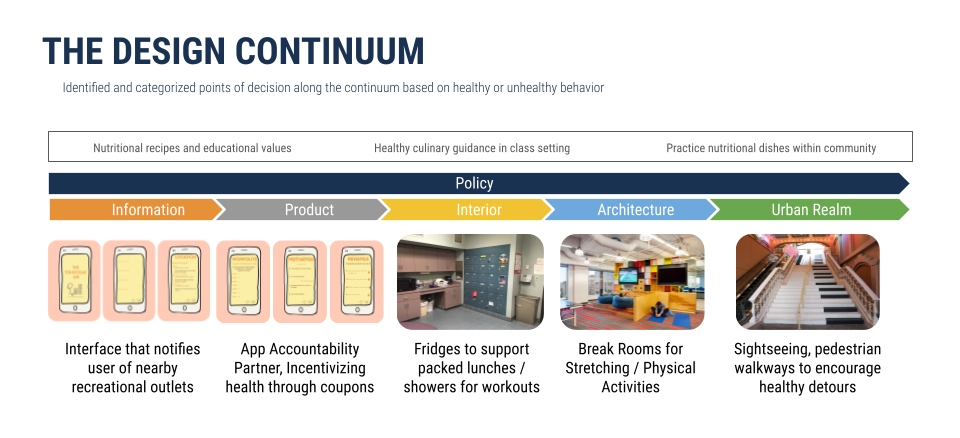
The design continum shows the topics proposed in the database.
Design to Outcomes
The community becomes a more connected and positive community; greater engagement and excitement over the different health and recreational outlets within the city.
︎︎︎Download The Conscious Life Poster
︎
Works Cited
1. Onufrak, S. J., Watson, K. B., Kimmons, J., Pan, L., Khan, L. K., Lee-Kwan, S. H., & Park, S. (2018). Worksite Food and Physical Activity Environments and Wellness Supports Reported by Employed Adults in the United States. American journal of health promotion : AJHP, 32(1), 96–105. https://doi.org/10.1177/0890117116664709
2. Quintiliani, Lisa, Sattelmair, Jacob, and Sorensen, Glorian. (2007). The workplace as a setting for interventions to improve diet and promote physical activity. World Health Organization. https://www.who.int/dietphysicalactivity/Quintiliani-workplace-as-setting.pdf?ua=1
3. Johns Hopkins Bloomberg School of Public Health. Institute for Health and Productivity Studies. ; Centers for Disease Control and Prevention (U.S.) (2016) .Physical Activity in the Workplace: A Guide for Employers. The Institute for Health and Productivity Studies, Johns Hopkins Bloomberg School of Public Health. https://www.jhsph.edu/research/centers-and-institutes/institute-for-health-and-productivity-studies/_docs/archived-projects/WHRN_PA.pdf
4. Siegel, RP (2013). How Biking Improves Employee Productivity. Tripli Pundit the business of doing better. https://www.triplepundit.com/story/2013/how-biking-improves-employee-productivity/59136
5.
6.
︎ Health Foundations Mini Course and Intermission Periods
How can we promote and encourage healthy diet and movement habits in college students throughout their education and the rest of their lives?
By Eliza Beird ︎ , Sophie Jackson ︎


Hypothesis
College is a pivotal time in an individual’s life to create habits, establish values, and make decisions that can impact the rest of one’s life. It is hypothesized that providing a policy-level design intervention (based upon providing time and helping students learn the principles of health) will aid students in establishing healthy life habits.
College is a pivotal time in an individual’s life to create habits, establish values, and make decisions that can impact the rest of one’s life. It is hypothesized that providing a policy-level design intervention (based upon providing time and helping students learn the principles of health) will aid students in establishing healthy life habits.
- Why?
A breif poll was conducted to gather information regaurding the exercise habits of students at the University of Michigan with specific emphasis on understanding main barriers that prevent them from working out. The data collected suggested that the most prominent barrier to students engaging in physical activity was conflicts with their class schedule and lack of understanding on how to work out effectively and effeciently
- How?
The proposal aims to provide educational materials and increased free time throughout the day in order to eliminate the discoverd barriers
- What?
A 2-part policy change within UofM’s curriculum including a required freshme mini course on health foundations and twice-weekly intermission periods where no classes are held. The design intervention educates students on health principles, encourages students to establish health habits and gives students time to engage in those habits.
- So What?
By providing resources and time, the intervention aims to improve the general health of college students at the University of Michigan both physically and mentally as the benefits of movement are expansive. As well, it aims to increase student’s perceived behavioral control in order to incite long-lasting lifestyle changes

Design to Outcomes
It is belived that a 2-part policy change within UofM’s curriculum including educational material time opportunites for college students will lead to aiding college students in building and establishing healthy habits throughout their college career and the rest of their lives.
︎︎︎Download Health Foundations Mini Course and Intermission Periods Poster
︎
Works Cited1. Kinesiology Department, “Health Dynamics: Going Strong!,” Hope College Blog Network [blog], October 13, 2017, https://blogs.hope.edu/kinesiology/kinesiology/health-dynamics-going-strong/
2. Miller et. al. “The Health Benefits of Exercise and Physical Activity,” Current Nutrition Reprots, 5 (2016): 204-212. doi:10.1007/s13668-016-0175-5
3. Sarah Gehlert and Trina Ward, “Theories of Health Behavior,” in Handbook of Health Social Work, (Wiley and Sons, 2019), 143-163
︎ Healthy Points of Decision through Accessibility and Visibility
How do the concepts of “Mobility and Accessiblity” improve student ability to seek healthy food options?
By Irene Routte ︎ , Saranmegha Parimi ︎


Hypothesis
University students face many barriers to healthy eating, such as time constraints, conveninece to high calorie food, high prices, scarcity of healthy food options and easy access to junk food. If we design for individuals to both be drawn to certain points at centralized and decentralized levels, and design for easier access to healthy food options at points of decision at each these levels, students will make overall healthier food choices. By focusing on placement design and focused lighting, we can better support students in accessing healthy food options.
University students face many barriers to healthy eating, such as time constraints, conveninece to high calorie food, high prices, scarcity of healthy food options and easy access to junk food. If we design for individuals to both be drawn to certain points at centralized and decentralized levels, and design for easier access to healthy food options at points of decision at each these levels, students will make overall healthier food choices. By focusing on placement design and focused lighting, we can better support students in accessing healthy food options.
- Why?
University students have both time and structural barriers in accessing healthy food options on campus.
- How?
Through the use of focused lighting and placement of healthy food options at specific locations.
- What?
Our interventions are based on how they connect to overall intrapersonal and environmental needs of students in a University environment - the easing of stress and anxiety due to time constraints, the desire to socialize and the peer pressure surrounding group food choices. Strategic decentralized healthy food options along student’s paths between activities allows for greater accessibility, decreasing stress of being able to access food in a timely manner. Students who are deciding on meal times based on wanting to be in a space of socialization will also be met with healthy food options in a centralized space to decrease on poor food choices based around peer pressure. Both decentralized and centralized spaces use focused lighting in order for students to be drawn to the healthy food options at both levels.
- So What?
These interventions promote the needs of students (decreasing anxiety around time, desire for connection and decrease in peer pressure) while offering healthy food options at critical points of decision. By making these adjustments to the environment, we allow students to make healthier choices daily.

The design continuum shows the topics based on “point of decision strategies” for college students
Design to Outcomes
We believe that by building both decentralized and centralized healthy food options within a University environment will promote making healthy food choices at points of decision for a student which meets their needs of both accessibility/time, as well as socialization.

︎︎︎Download Centralization & Decentralization Poster
︎
Works Cited1. Kim,Chŏng-yŏn.(2014).Impulse buying:Theeffect of decision time and product scarcity on buying impulse.
2. Kuijsters,A.,Redi,J.,deRuyter,B.,& Heynderick,I.(2015).Lighting to Make You Feel Better: Improving
the Mood of Elderly People with Affective Ambiences.PloSone,10(7).
3. McCloughan,C.L.B.,Aspinall,P.A.,& Webb,R.S.(1999).The impact of lighting on mood. International Journal of Lighting Research and Technology,31(3),81–88.
4. Sogari, Giovanni, Catalina Velez-Argumedo, Miguel I. Gómez, and Cristina Mora. 2018. "College Students and Eating Habits: A Study Using An Ecological Model for Healthy Behavior" Nutrients 10, no. 12: 1823. https://doi-org.proxy.lib.umich.edu/10.3390/nu10121823
5. Song,S.,& Yamada,S.(2019).Ambient lights influence perception and decision-making. Frontiers in
Psychology,9.. https://doi.org/10.3389/fpsyg.2018.02685
︎ Nutrition by Design
How to promote a healthy diet and improve social engagement through the experience of gardening?
By Tia Blanchard ︎ , Marco Dominguez ︎


Hypothesis
When it comes to a healthy diet, it can be a challenge when identifying and understanding what ingredients and dishes fall under the category of nutritional eating. By providing a community garden meant for all ages, intergenerational social engagment is intergrated with the access to fresh and affordable foods mended by the hands of the community. The use of a garden empowers individuals to create healthier dishes made from the ingredients grown by their own hands and encourages the experience with others.
When it comes to a healthy diet, it can be a challenge when identifying and understanding what ingredients and dishes fall under the category of nutritional eating. By providing a community garden meant for all ages, intergenerational social engagment is intergrated with the access to fresh and affordable foods mended by the hands of the community. The use of a garden empowers individuals to create healthier dishes made from the ingredients grown by their own hands and encourages the experience with others.
- Why?
Finding fresh, affordable food can be difficult to find and understanding what foods are beneficial to the body and mind are not always so simple to recognize. Unknowing the full benefits of a healthy diet can lead to a negative influence on nutritional choices causing a decline in health of body and mind.
- How?
Through researching nutritional benefits on positive thinking, well-being, and physical health, we can establish a design that encourages healthy choices by providing knowledge on nutritional decisions and affordable foods through intergenerational and educational gardening.
- What?
The project goal is to create a garden space for all ages to interact and engage while learning of the nutritional benefits of the foods they produce and how they may further develop healthier choices to share within their homes with friends and family. The garden is meant to provide individuals with fresh and affordable food that is to be shared with others.
- So What?
Gardens ensure fresh fruits and vegetables to those who provide the upkeep, empowering individuals to choose healthier dishes and make healthier decisions. The use of intergenerational gardens adds for social interaction across all ages and the sharing of knowledge.

The design continum shows the topics proposed in the database.
Design to Outcomes
It is in our own understanding that when providing the community with the space and tools to garden fresh foods with no age restrictions, social interactions are met through intergenerational engagement and individuals have the opportunity to grow and consume nutrional foods while providing freshness and affordability.
︎︎︎Download Nutrition by Design Poster
︎
Works Cited
1. Crichton-Stuart, Cathleen. (December 10, 2020). What are the Benefits of Eating Healthy? Medical News Today. https://www.medicalnewstoday.com/articles/322268
2. Knott, Dr. Laurence. (September 16, 2020). Healthy Eating. Patient. https://patient.info/healthy-living/healthy-eating
3. (October 29, 2020). 5 Science-Based Reasons Why Healthy Cooking Is Important? Happy Belly Fish. https://happybellyfish.com/2020/10/29/5-science-based-reasons-why-healthy-cooking-is-important/
4. Hasan, Bashar., Thompson, Warren G., Almasri, Jahad., Wang, Zhen., Lakis, Sumaya., Prokop, Larry J., Hensrud, Donald D., Frie, Kristen S., Wirtz, Mary J., Murad, Angela L., Ewoldt, Jason S., Murad, M. Hassan. (2019).
5. Daniels, Pam. (January 30, 2017). The Benefits of Going to a Cooking Class. Michigan State University Extension. https://www.canr.msu.edu/news/the_benefits_of_going_to_a_cooking_class
Making healthy choices can be complicated in the uncovering of healthy dishes and their nutritional benefits.
︎ Sensory Stimulation Through Nature
How can nature create positive stimulation and spaces for social interaction for aging adults?
By Kayla Hawley ︎ , Erica Behm ︎ , Tia Blanchard ︎

Why
Adults over 50 are especially vulnerable to mental illnesses and cognitive decline. The environment they live in can heavily impact this, along with outside sources such as financial stress. Often minority groups with low income end up living in highly urbanized areas where access to nature is either difficult or non-existent. This lacks outlets for stress, reduces sensory stimulation, and aids in cognitive decline.
How can an architectural environment create positive, stress-free spaces that promote sensory stimulation in aging adults through nature based interventions?
By focusing on sensory stimulation, healthy aging, and cognitive function, implementing natural elements will provide a safe space for enjoyment, encourage cognitive engagement and sensory use, reduce risk of depressive symptoms, promote intergenerational interaction, and provide ‘meaning of purpose’ tasks.

Noticable decline begins at or after the age of 50 for the average human being. This chart shows a relative decline starting at this known point and following guidelines of which senses tend to have higher loss. (Graphic by Kayla Hawley)
Hypothesis
If we stimulate senses through nature, then aging adults will have decreased degradation of senses, improved cognition, and reduced stress.

Nature -> Brain <- Senses
Through recent research we have found that natural elements affect the brain through sensory stimulation. The diagram shown above provides examples of nature elements and the senses they may stimulate. For example, water elements such as rain or waterfalls allow the sense of smell and taste to be stimulated as well as providing a sense of touch and soothing sounds to affect auditory. (Graphic by Tia Blanchard)

(Graphic by Tia Blanchard, Erica Behm)
How
Through researching sensory degradation, compensation, and stimulation, we can assess the background in sensthetics. Combined with research on nature and its impacts on mental health and aging, we can develop interventions implemented over various lengths of time that promote positive sensory stimulation through nature.
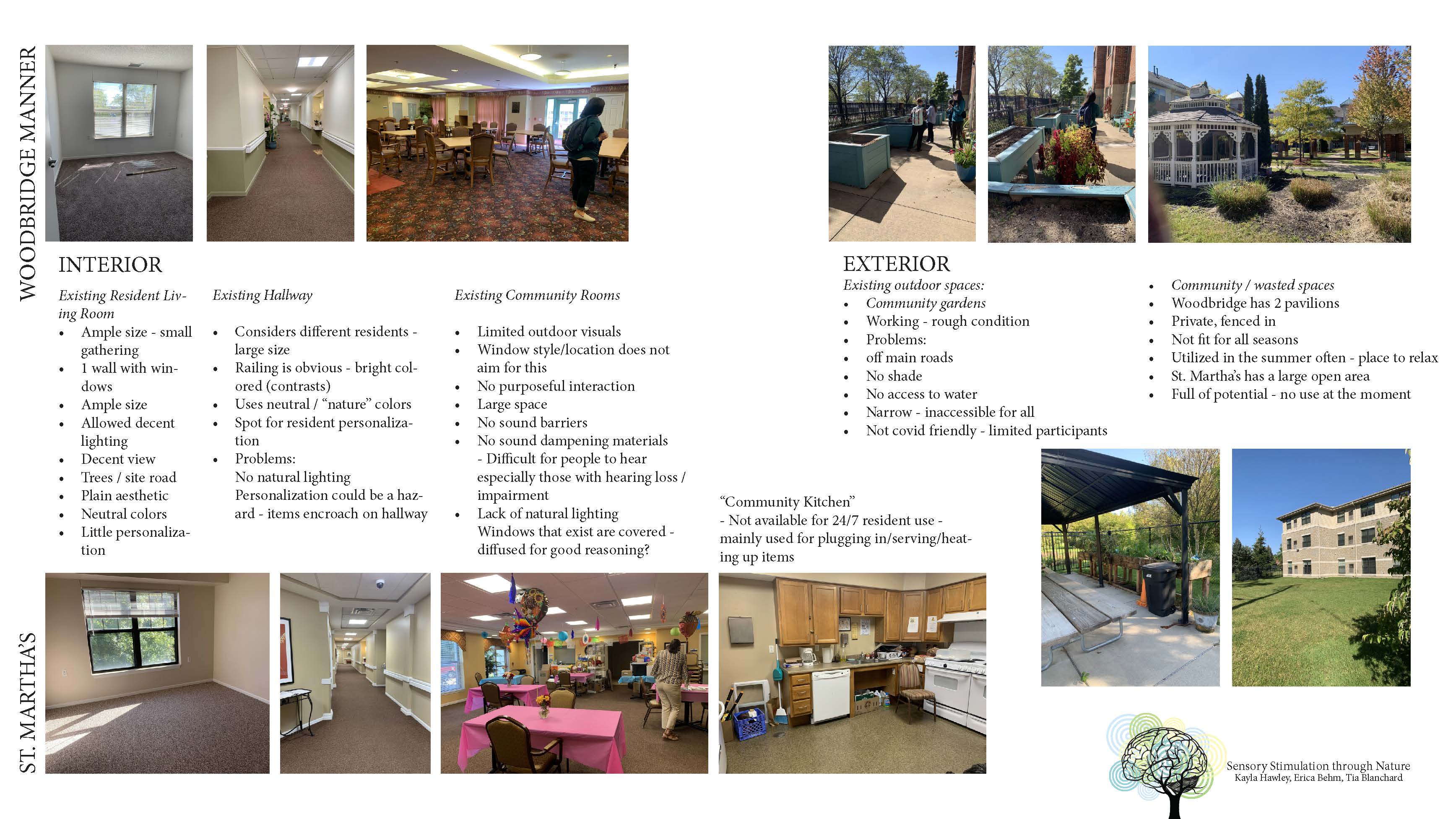 Site Visit Analysis (Graphic by Kayla Hawley, Erica Behm)
Site Visit Analysis (Graphic by Kayla Hawley, Erica Behm)What
Our project goal is to create a mini sensory ecosystem that promotes stimulation and socialization. To encourage sensory use and compensation elements of nature will be implemented within the residents’ environment. These spaces will be focusing on sensory use and sensory compensation development in those that have sensory loss.

_Sensory Room_Intervention 1

(Graphics by Erica Behm)
_Sensory Based Products_Intervention 2

(Graphics by Tia Blanchard)
_Horticulture Therapry_Intervention 3

(Graphics by Kayla Hawley)
Design To Outcomes
Our design proposal will create a healthy, safe social environment for residents to enjoy, relax, and experience sensory stimulation through natural elements. Through the incorporation of nature, both inside and outside, we will increase stimulation; this will encourage sensory compensation and positively impact cognitive function. Additionally, interactions with nature, other residents, and family will reduce levels of stress while creating positive thoughts, reactions, experiences, and task-driven activities.
So What
Nature based sensory interventions create stress free enriching environments that can be invested and implemented on multiple scales by operators and builders. This stimulation is important to engage cognitive function among seniors who may be struggling with sensory decline.
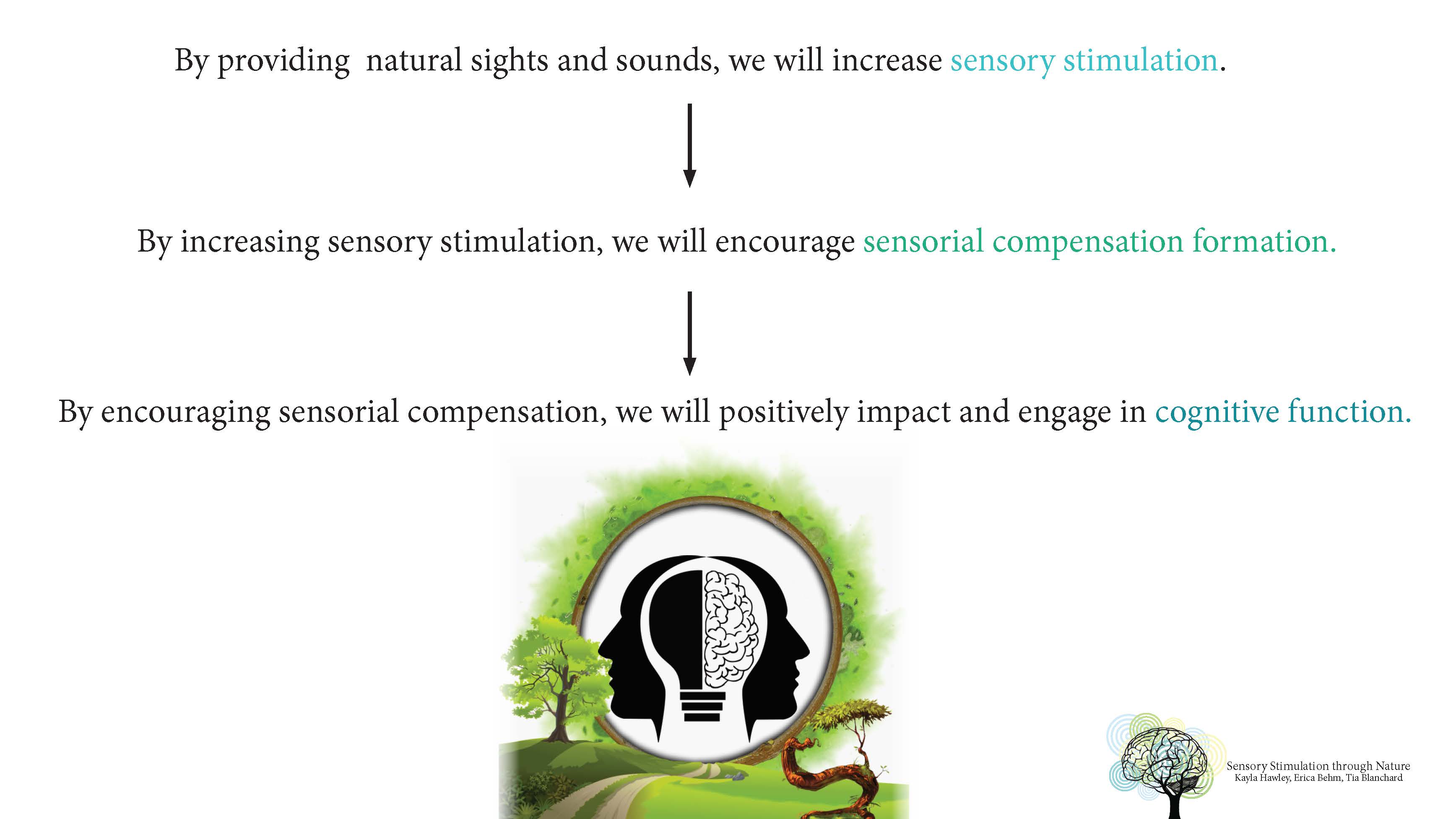
(Graphic by Erica Behm)
Links to Follow:
︎︎︎Two Page Report
︎︎︎Miro Board
︎
Works Cited
2. Aging, Institute on. “Birdwatching Helps Older Adults Reconnect with Nature and Their Health.” IOA Blog, June 8, 2016. https://blog.ioaging.org/activities-wellness/birdwatching-helps-older-adults-reconnect-nature-health/.
3. “Brain Health: Boost Your Brain with Gardening.” Aging Outreach Services, June 1, 2020. https://agingoutreachservices.com/advice/health-wellness/brain-health-boost-your-brain-with-gardening/.
4. “Cognitive Health and Older Adults.” National Institute on Aging. U.S. Department of Health and Human Services. Accessed December 6, 2021. https://www.nia.nih.gov/health/cognitive-health-and-older-adults.
5. “Enhancing Vision through Touch.” National Federation of the Blind . Accessed December 6, 2021. https://nfb.org/images/nfb/publications/books/integrating-print-braille/integratingprintandbraillechapter3.html.
6. Humes, Larry E, and Levi A Young. “Sensory-Cognitive Interactions in Older Adults.” Ear and hearing. U.S. National Library of Medicine, 2016. https://www.ncbi.nlm.nih.gov/pmc/articles/PMC4930008/.
7. Jpanayotov. “Sensory Stimulation Activities for Seniors with Dementia.” Assisting Hands , November 25, 2020. https://assistinghands.com/20/illinois/hinsdale/blog/sensory-stimulation-activities-for-seniors-with-dementia/.
8. L, Chinnery Holly, and Thompson Simon BN. “Sensory Compensation in Children Following Vision Loss after Trauma and Disease.” Journal of Clinical Research and Ophthalmology. Peertechz, September 23, 2015. https://www.peertechzpublications.com/Clinical-Research-Ophthalmology/JCRO-2-121.php.
9. Nanda, Upali., Hoelting, Melissa., Soja, Rebecca., Nautiyal, Divya., Warner, Grant. “Enriched Environments for Brain Health that Foster Creativity, Promote Positivity, and Reduce Stress: A Neurogenesis Hypothesis” HKS. June 1, 2021. https://www.hksinc.com/how-we-think/research/enriched-environments-for-brain-health-that-foster-creativity-promote-positivity-and-reduce-stress-a-neurogenesis-hypothesis/
10. Tompa , Dr. Rachel. “The Plastic Fantastic Brain: Why Losing One Sense Rewires Others.” Fred Hutch, January 19, 2016. https://www.fredhutch.org/en/news/center-news/2016/01/losing-senses-rewires-others-study.html.
11. V;, Wettstein M;Wahl HW;Heyl. “Visual Acuity and Cognition in Older Adults with and without Hearing Loss: Evidence for Late-Life Sensory Compensation?” Ear and hearing. U.S. National Library of Medicine. Accessed December 6, 2021. https://pubmed.ncbi.nlm.nih.gov/29256920/.
12. Walsh, Fiona E ; Walsh, Greg S ; Eyre, Harris A ; Dawson, Walter D. “Late-Life Brain Health Architecture: Leveraging Convergence Science Principles.” The American Journal of Geriatric Psychiatry. Washington: Elsevier Inc, n.d. doi:10.1016/j.jagp.2020.05.003.
13. “Why Bird-Watching Can Be Healthy for Seniors.” Medicareful Living. Ritter Insurance Marketing. Accessed December 6, 2021. https://living.medicareful.com/why-bird-watching-can-be-healthy-for-seniors.
︎ Intergenerational Community Connections
How can we connect the senior citizens to the community through different design strategies?
By Alanna Rosenthal ︎ , Eliza Beird ︎ , Marco Dominguez ︎, Saranmegha Parimi ︎

Why
Despite its proximity to community resources, Woodbridge Manor remains isolated from its surrounding community, with residents staying on site due to lack of transportation and other obstacles. This barrier to community engagement is concerning due to the research on the importance of diverse social connectedness on both physical and mental health.

Hypothesis
By community mapping and establishing relationships with local resources and programs, it is hypothesized that Senior Residents at Woodbridge Manor will be more likely to engage in intergenerational interactions and public spaces which will act as a protective factor to both physical and mental well-being among aging adults.
How
Through site visits, staff and resident conversations, an in-depth literature review, and community scanning via mapping, we identified current barriers, wants, and needs of Woodbridge Manor residents. Our literature review highlighted the benefits of intergenerational interactions and connecting aging adults to specific community resources.
 Literature Review Mind Mapping / Graphic by Saranmegha Parimi, Literature Collection by Eliza Beird, Alanna Rosenthal and Saranmegha Parimi
Literature Review Mind Mapping / Graphic by Saranmegha Parimi, Literature Collection by Eliza Beird, Alanna Rosenthal and Saranmegha ParimiWhat
We addressed this proposal with a now, near, and future framework to allow for immediate interventions that allow room for growth. With this in mind, we looked at the potential affects of delivering efficient information, sharing community resources, and creating communal spaces.
As a NOW intervention, we looked at creating a pamphlet or a wallpaper community map with large icons, closest resources, fastest paths, event programming, and information on currently available transportation resources.


As a NEAR intervention, we hope to create community partnerships in order to share events and resources. Our literature review identified the health benefits of connecting aging adults to a variety of resources (schools, museums, community centers). By identifying the economical, social, and other benefits of these resources connecting with aging adults, we hope to stress the mutual benefits of partnerships in order to share resources. One such example could be a partnership with a school that could share buses as a transportation resource based on the “Michigan Pupil Transportation Act of 1990” and the benefits of connecting youth and older adults.

 Resources Mapping / Graphics by Marco Dominguez
Resources Mapping / Graphics by Marco DominguezFinally, as a FAR intervention, we looked at developing a multi-purpose communal space beside Woodbridge to stimulate intergenerational interaction within close proximity to eliminate the barrier of transportation for Woodbridge Manor. This could be done using the empty lot next to Woodbridge that is privately owned but could be developed as a communal multi-purpose space due to it being zoned as Planned Development.

 Design of Intergenerational Community Area / Graphics by Saranmegha Parimi
Design of Intergenerational Community Area / Graphics by Saranmegha ParimiDesign To Outcomes
Our design proposal seeks to stimulate intergenerational interactions along various points along the design continuum. It is believed that providing direct and efficient information will lead to an increased likelihood of residents leaving Woodbridge Manor to engage with the community. Through the development of community partnerships, it will allow for the sharing of resources and increase the accessibility to neighborhood resources. Finally, by designing a multi-purpose community space next to Woodbridge Manor, we will see a decrease in the need for transportation resources and an increase in community members coming into Woodbridge. All three of these interventions are believed to lead to increased levels of intergenerational interaction in some capacity.
So What
Woodbridge residents struggle to access surrounding resources. By providing information about transportation and resources through community mapping, establishing mutually beneficial relationships to share resources, and eventually developing a space that brings the community to Woodbridge, we aim to stimulate intergenerational interactions and social connectedness between residents and community members . If this can happen, we hope to see positive changes in ageist stereotypes, which may lead to the aging population feeling more acknowledged and important in society, ultimately affecting overall brain health.
︎︎︎ Link to research Miro Board
︎︎︎ Link to two page research paper
︎
Works Cited
1. “9 (Most Popular) Use Cases of Digital Signage in Movie Theaters.” Xynage. Accessed 7 December, 2021. https://www.xynage.io/blog/digital-signage-for-movie-theaters/
2. Briguglio M, Giorgino R, Dell’Osso B, Cesari M, Porta M, Lattanzio F, Banfi G, and Peretti G. “ Consequences for the Elderly After Covid-19 Isolation: FEaR (Frail Elderly amid Restrictions).” Frontiers in Psychology. September 28, 2021. https://www.ncbi.nlm.nih.gov/pmc/articles/PMC7549544/
3. Cicirelli V. “ Fear of Death in Older Adults: Predictions from Terror Managemnet Theory.” The Journal of Gerontology: Series B. July 1, 2002. https://academic.oup.com/psychsocgerontology/article/57/4/P358/593449?login=true
4. Fingerman K, Huo M, Charles S, Umberson D, and Brown J. “Variety is the Spice of Late Life: Social Integration and Daily Activity.” Journal of Gerontology Series B: Psychological Sciences and Social Sciences, January 18, 2019. https://www.ncbi.nlm.nih.gov/pmc/articles/PMC7179804/
5. Hawkley L, Kozloski M, and Wong J. “A Profile of Social Connectedness in Older Adults.” NORC. The University of Chicago. September 18, 2021. https://capitolhillvillage.org/wp-content/uploads/2018/11/A-Profile-of-Social-Connectedness-1.pdf
6. “Hidden in Plain Sight: How Intergenerational Relationships can Transform Our Future.” Stanford Center on Longevity. Stanford University. June 2016. https://longevity.stanford.edu/wp-content/uploads/sites/24/2018/09/Intergenerational-relationships-SCL.pdf
7. “Loneliness and Health.” National Poll on Healthy Aging. University of Michigan. Accessed 7 December, 2021. https://www.healthyagingpoll.org/reports-more/report/loneliness-and-health
8. Magalhaes V, Teixeira C, Boas E, Pereira R, dos Santos N, and Rozendo C. “ Fear of Falling in Older Adults Living at Home: Associated Factors*. Journal of School of Nursing, January 5, 2017. https://www.scielo.br/j/reeusp/a/cPt55FvTTf9kTRk9m5tBKcm/?format=pdf&lang=en
9. “The Pupil Transportation Act of 1990.” Michigan Compiled Laws. Michigan State Government. Accessed 7 December, 2021
10. AARP, January 17. “Transportation Services for Seniors and the Disabled.” AARP, January 17, 2020. https://www.aarp.org/caregiving/home-care/info-2020/transportation-services.html.
11. “Community Food Environments and Healthy Food Access among Older Adults: A Review of the Evidence for the Senior Farmers' Market Nutrition Program (SFMNP).” Taylor & Francis. Accessed December 8, 2021.
12. “Event Reader Boards.” Touchquest. Accessed December 8, 2021. http://www.touchquest.com/digital-signage-solutions/event-reader-boards/.
13. Hanslmaier, Michael, Andreas Peter, and Brigitte Kaiser. “Vulnerability and Fear of Crime among Elderly Citizens: What Roles Do Neighborhood and Health Play? - Journal of Housing and the Built Environment.” SpringerLink. Springer Netherlands, September 5, 2018. https://link.springer.com/article/10.1007/s10901-018-9626-1.
14. Marcarelli, Rebekah. “Creating Digital Menu Board Magic.” Winsight Grocery Business. Winsight Grocery Business, May 29, 2019. https://www.winsightgrocerybusiness.com/technology/creating-digital-menu-board-magic.
15. “ProQuest Ebook Central - Reader.” Accessed December 8, 2021. https://ebookcentral.proquest.com/lib/nu/reader.action?docID=3545133&ppg=12.
16. “ProQuest | Better Research, Better Learning, Better Insights.” Accessed December 8, 2021. https://www.proquest.com/.
17. Shrestha, B P, A Millonig, N B Hounsell, and M McDonald. “Review of Public Transport Needs of Older People in European Context.” Journal of population ageing. Springer Netherlands, 2017. https://www.ncbi.nlm.nih.gov/pmc/articles/PMC5656732/.
18. “Social Isolation and Loneliness in Older Adults.” Google Books. Google. Accessed December 8, 2021. https://books.google.com/books?hl=en&lr=&id=SDbnDwAAQBAJ&oi=fnd&pg=PR1&dq=Social%2Bissues%2Bin%2Bsenior%2Bcitizens%2Bin%2Bunited%2Bstates&ots=c6nauMPWjT&sig=RINp5kRNO8X548VG0mNRb5yJUn8#v=onepage&q=Social%20issues%20in%20senior%20citizens%20in%20united%20states&f=false
.
19. Souza, Jeane Barros de, Ivonete Teresinha Schulter Buss Heidemann, Fernanda Walker, Maira Lidia Schleicher, Angélica Zanettini Konrad, and Juliana Praxedes Campagnoni. “Vulnerability and Health Promotion of Haitian Immigrants: Reflections Based on Paulo Freire's Dialogic Práxis.” Revista da Escola de Enfermagem da USP. Universidade de São Paulo, Escola de Enfermagem, June 18, 2021. https://www.scielo.br/j/reeusp/a/7kkLLrGMVNyJfWgwPjbgPhp/?format=html.
20. Sánchez, Alba, Ana Maseda, M. Pilar Marante-Moar, Carmen de Labra, Laura Lorenzo-López, and José Carlos Millán-Calenti. “Comparing the Effects of Multisensory Stimulation and Individualized Music Sessions on Elderly People with Severe Dementia: A Randomized Controlled Trial.” Journal of Alzheimer's Disease. IOS Press, January 1, 2016. https://content.iospress.com/articlies/journal-of-alzheimers-disease/jad151150.
21. Todd, Carolyn, Paul M. Camic, Bridget Lockyer, Linda J.M. Thomson, and Helen J. Chatterjee. “Museum-Based Programs for Socially Isolated Older Adults: Understanding What Works.” Health & Place. Pergamon, September 23, 2017. https://www.sciencedirect.com/science/article/pii/S1353829217303878.
22. University, Stanford. “Bringing Old and Young Together Benefits Both.” Stanford News, September 6, 2017. https://news.stanford.edu/2016/09/08/older-people-offer-resource-children-need-stanford-report-says/.
21. Yuhei Inoue, Daniel L. Wann. “Enhancing Older Adults' Sense of Belonging and Subjective Well-Being through Sport Game Attendance, Team Identification, and Emotional Support - Yuhei Inoue, Daniel L. Wann, Daniel Lock, Mikihiro Sato, Christopher Moore, Daniel C. Funk, 2020.” SAGE Journals. Accessed December 8, 2021. https://journals.sagepub.com/doi/full/10.1177/0898264319835654?journalCode=jaha.
︎ Power of Play: Improving Brain Health In Lower-Income Affordable Housing
How can we create digital and physical spaces for playto help seniors improve their brain health and sense of belonging in their communities?
By Maya Fraser ︎ , Sophie Jackson ︎ , Zoe Elliott ︎

Why
An estimated 43% of adults over 60 experience loneliness (NASEM). Loneliness has important health consequences, including increased risks of death (increase of 20%) and cognitive decline (increase of 60%) (Ristau). Older adults experiencing loneliness are at a much greater risk of death and severe disease than those who frequently interact with others. This includes an 50% increase in the risk of developing dementia (NASEM). More than one third of older adults in the United States report feeling lonely, and the COVID-19 pandemic has only exacerbated this trend (NASEM). As a result, many adults in the United States are at an increased risk of poor brain health.
To better understand solutions to this challenge, we used Presbyterian Villages of Michigan as a prototype test case. PVM is a faith-based, non-profit network of senior-living communities that provides low-income seniors with the opportunity for independent living, assisted-living, or memory care, depending on the community.
Hypothesis
If we create year round opportunities for play for seniors in the Presbyterian Village Communities, then there will be increased social engagement which will result in a higher sense of belonging and overall better brain health.
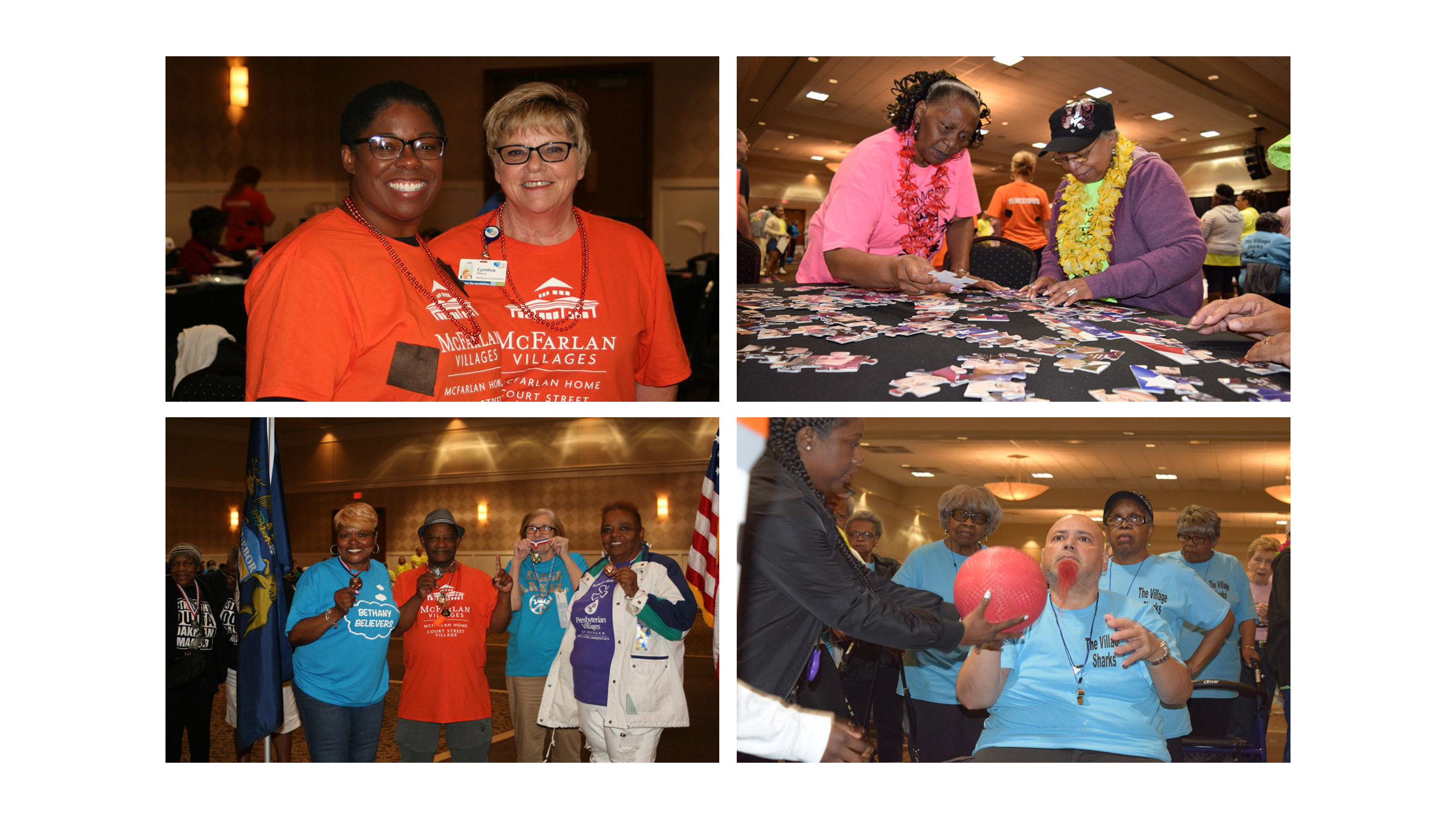
Residents of the Presbyterian Villages of Michigan engaging in play / Presbyterian Villages of Michigan 2021
How
While observing residents of Woodbridge and St. Martha's Presbyterian Villages of Michigan, we observed a lack of opportunities for social engagement that were applicable throughout the year. Several of the indoor spaces were underutilized by the residents, due to the small size of rooms and lack of windows. Residents and administration also cited the need for activity set-up in these spaces as a challenge. Administration specifically noted that when events are held, much of the set up and organization fell to staff to do which is quite challenging if needed to do frequently.
To address this gap and improve the brain health of residents, we decided to create digitial and physical spaces specifically for play that will connect different living communities within the Presbyterian Village Network. We decided to focus on play because it improves brain health through many different pathways. The social aspect of play combats loneliness, leading to lowered stress and improved social bonds. Engaging in play also strengthens cognitive function, increases physical activity, stimulates creativity, and improves mood.
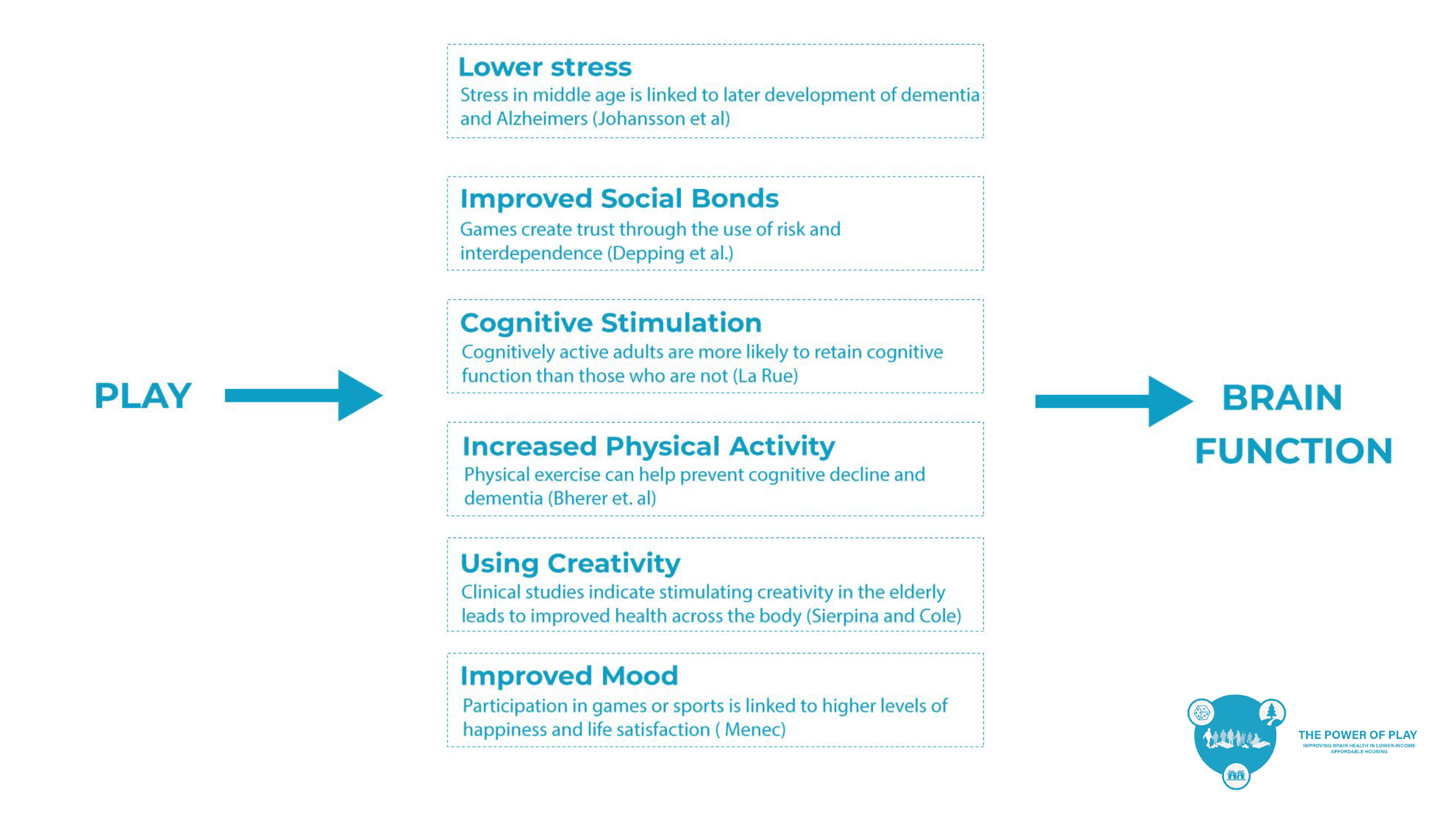
Links between play and brain health
Methodology
To understand the challenges facing residents of the Presbyterian Villages and their potential solutions, we used several strategies. First, we visited the Village of St. Martha’s and Woodbridge Manor to observe existing facilities and talk with administrators and residents. We also conducted a literature review of the relationship between brain health and play. Finally, we met with experts to gain domain-specific feedback.

The “Fun Bus”
Design To Outcomes
Now
The Victor's Cup is an annual, widely-anticipated competition event that involves communities across the Presbyterian Villages of Michigan network. An impactful intervention we could implement right now Presbyterian Villages is a more frequent (monthly) Victor's Cup with online leaderboards which will help connect the Village's social network through digital space. Specfically, we would develop a systematic policy around games to create a Michigan-wide community of gaming and competition. From our observations and conversations with residents, it is a fun and popular event. By making the Victor's Cup competition and gaming practice once a month, we can bring this excitement and physical activity more often.
Each month we will provide each of the PVM villages with a game, giving the residents an opportunity to score as many points as they can. An online leaderboard will display the top scores across the different villages, instigating a sense of community and competition between residents in the same village and across the villages). The variety in games will provide opportunities for residents of varying physical and cognitive abilities to participate.
Near

Fun Bus in warm weather
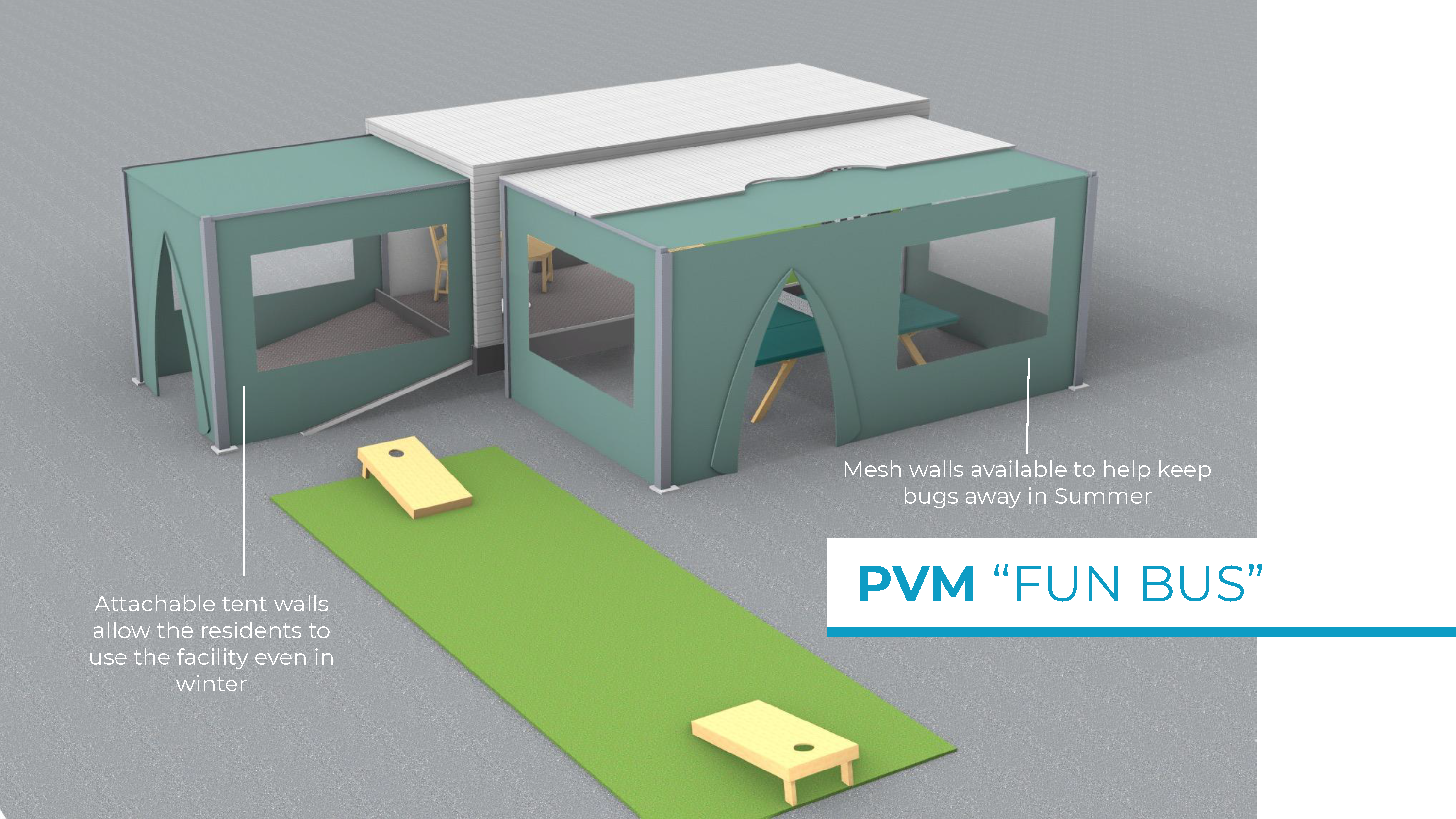
Fun Bus in colder weather
The intervention we plan for the near future and with grant funding would be a travelling fun/ game bus that would visit each village for a limited amount of time. Because the bus only comes occasionally, its arrival would mark a special occasion that could get residents excited.
The fun bus is a trailer that is attachable and detachable from a van or truck and is able to occupy either the greenspace or parking lot. It can store a collection of fun games and activities which can be set up upon arrival. To increase occupiable space, the doors open out with additional tent material. Metal poles hold the roof in place, and in winter additional siding can slot into the metal poles to create a tent like structure, allowing for thermal comfort and weather protection.
The flexible programming of the bus means that the games and activities could change across the year, or as needs change. It could also engage with a wider audience, including the families of residents, or the wider community.
Far

Our far intervention will utilize both the physical interior existing spaces and digital space through an app called PVM CONNECT. This would widen our design continuum scale scope to include product and interiors.
PVM CONNECT is an application that can be downloaded onto a tablet or computer and acts as an online leaderboard and tracking system that can be used to measure inter-village competition. The app provides an easy to use score input system that is easy for residents to use. PVM CONNECT is able to track usage and participation through the amount of information put into the scheme. It naturally translates the input scores into leaderboards and acknowledgements that are presented to the competitors on the app.
Measuring Impact
We plan to measure these outcomes now by observing the frequency of participation with the activities and use of the space. Additionally, we will conduct surveys asking residents about their sense of belonging and engagement in the community. In the future, with more funding, we could measure individual outcomes through biometric testing.
So What
Residents of the Presbyterian Villages of Michigan currently lack opportunities to engage in play and social activity. Our intervention offers a cost-effective way to help seniors stay healthy and have a strong sense of belonging. By implementing this intervention, the Presbyterian Villages of Michigan would be able to keep their independent living residents independent for longer.
︎︎︎Link to 2 Pages Research Paper
︎
Works Cited
1. Bherer, L., Erickson, K. I., & Liu-Ambrose, T. (2013). A Review of the Effects of Physical Activity and Exercise on Cognitive and Brain Functions in Older Adults. Journal of Aging Research, 2013, e657508. https://doi.org/10.1155/2013/657508
2. Blume, C., Garbazza, C., & Spitschan, M. (2019). Effects of light on human circadian rhythms, sleep and mood. Somnologie, 23(3), 147–156. https://doi.org/10.1007/s11818-019-00215-x
3. Calkins, M. P. (2020). Designing Gardens to Attract Activity. IDEAS Institute. https://www.pioneernetwork.net/resources/designing-gardens-to-attract-activity/
4. Depping, A. E., Mandryk, R. L., Johanson, C., Bowey, J. T., & Thomson, S. C. (2016). Trust Me: Social Games are Better than Social Icebreakers at Building Trust. Proceedings of the 2016 Annual Symposium on Computer-Human Interaction in Play, 116–129. https://doi.org/10.1145/2967934.2968097
5. Jimenez, M. P., DeVille, N. V., Elliott, E. G., Schiff, J. E., Wilt, G. E., Hart, J. E., & James, P. (2021). Associations between Nature Exposure and Health: A Review of the Evidence. International Journal of Environmental Research and Public Health, 18(9), 4790. https://doi.org/10.3390/ijerph18094790
6. Johansson, L., Guo, X., Waern, M., Östling, S., Gustafson, D., Bengtsson, C., & Skoog, I. (2010). Midlife psychological stress and risk of dementia: A 35-year longitudinal population study. Brain, 133(8), 2217–2224. https://doi.org/10.1093/brain/awq116
7. La Rue, A. (2010). Healthy Brain Aging: Role of Cognitive Reserve, Cognitive Stimulation, and Cognitive Exercises—ClinicalKey. Clinics in Geriatric Medicine, 26(1), 99–111. https://doi.org/10.1016/j.cger.2009.11.003
8. Menec, V. H. (2003). The Relation Between Everyday Activities and Successful Aging: A 6-Year Longitudinal Study. The Journals of Gerontology: Series B, 58(2), S74–S82. https://doi.org/10.1093/geronb/58.2.S74
9. National Academies of Sciences, Engineering, and Medicine 2020. Social Isolation and Loneliness in Older Adults: Opportunities for the Health Care System. Washington, DC: The National Academies Press.https://doi.org/10.17226/25663.
10. Patterson, Michael C., and Susan Perlstein. “Good for the Heart, Good for the Soul: The Creative Arts and Brain Health in Later Life.” Generations: Journal of the American Society on Aging 35, no. 2 (2011): 27–36. https://www.jstor.org/stable/26555772.
11. Razani, N., Malekinejad, M., & Rutherford, G. W. (2021). Clarification Regarding “Outdoor Transmission of SARS-CoV-2 and Other Respiratory Viruses: A Systematic Review.” The Journal of Infectious Diseases, 224(5), 925–926. https://doi.org/10.1093/infdis/jiab298
12. Ristau, Stephen. “People Do Need People: Social Interaction Boosts Brain Health In Older Age.” Generations: Journal of the American Society on Aging 35, no. 2 (2011): 70–76. https://www.jstor.org/stable/26555777.
13. Rodin, Judith. “Aging and Health: Effects of the Sense of Control.” Science 233, no. 4770 (1986): 1271–76. http://www.jstor.org/stable/1697974.
14. Salthouse, Timothy A. “Mental Exercise and Mental Aging: Evaluating the Validity of the ‘Use It or Lose It’ Hypothesis.” Perspectives on Psychological Science 1, no. 1 (2006): 68–87. http://www.jstor.org/stable/40184198.
15. Sierpina, M., & Cole, T. R. (2004). Stimulating Creativity in All Elders: A Continuum of Interventions. Care Management Journals, 5(3), 175–182. https://doi.org/10.1891/cmaj.2004.5.3.175
16. Wilson, Robert S. “Mental Stimulation and Brain Health: Complex, Challenging Activities Can Support Cognitive Health in Older Adults.” Generations: Journal of the American Society on Aging 35, no. 2 (2011): 58–62. https://www.jstor.org/stable/26555775.
︎
Therapeutic Wayfinding: Transforming the Corridor Into a Healing Environment
How can the corridor be transformed from a space of disorientation into a stabilizing and re-regulating place that enriches the broader therapeutic environments and supports healthy aging?
By Aidan Barron ︎ , Chun-Li Chen (Julie) ︎ , Elyssa Bakker ︎ , Irene Routte ︎

Why
Studies show that some of the first tasks affected by cognitive loss are those that involve spatial learning and spatial memories. (O’Malley, 2018). It has also been demonstrated that those who have experienced complex trauma or PTSD also suffer cognitive impediments that impact spatial navigation (Smith, 2015). In particular trauma impacts the brain’s ability to process both memories and emotions due to changes that occur to both the hippocampus and amygdala (Fidalgo, 2016). Changes in the amygdala of someone with PTSD causes increased response to stimuli which causes a person to experience dysregulation. Dysregulation, a hallmark of trauma/PTSD, arises from an exaggerated response to a threat and/or inability to regulate negative emotional states. In addition, hippocampal changes in the brain limits the ability for contextualizing memories. This contributes to a lowered capacity for allocentric processing because of the lack of memory for object location relative to spatial boundaries (Fidalgo).To compensate for this lack, egocentric processing, or navigating spatially based on self-to-object, is relied on more heavily for wayfinding (Allocentric vs. Egocentric Spatial Processing, 2021).
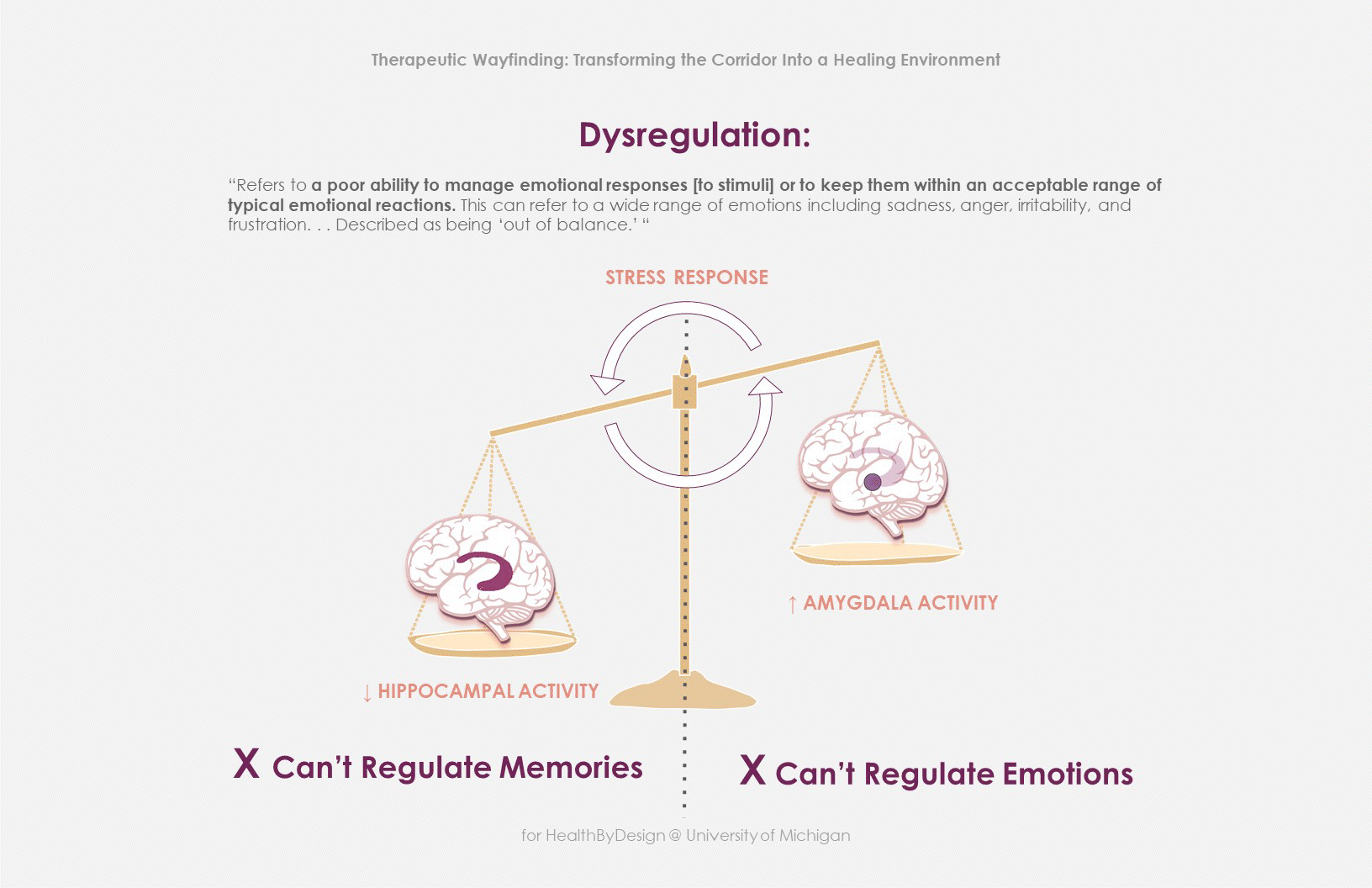
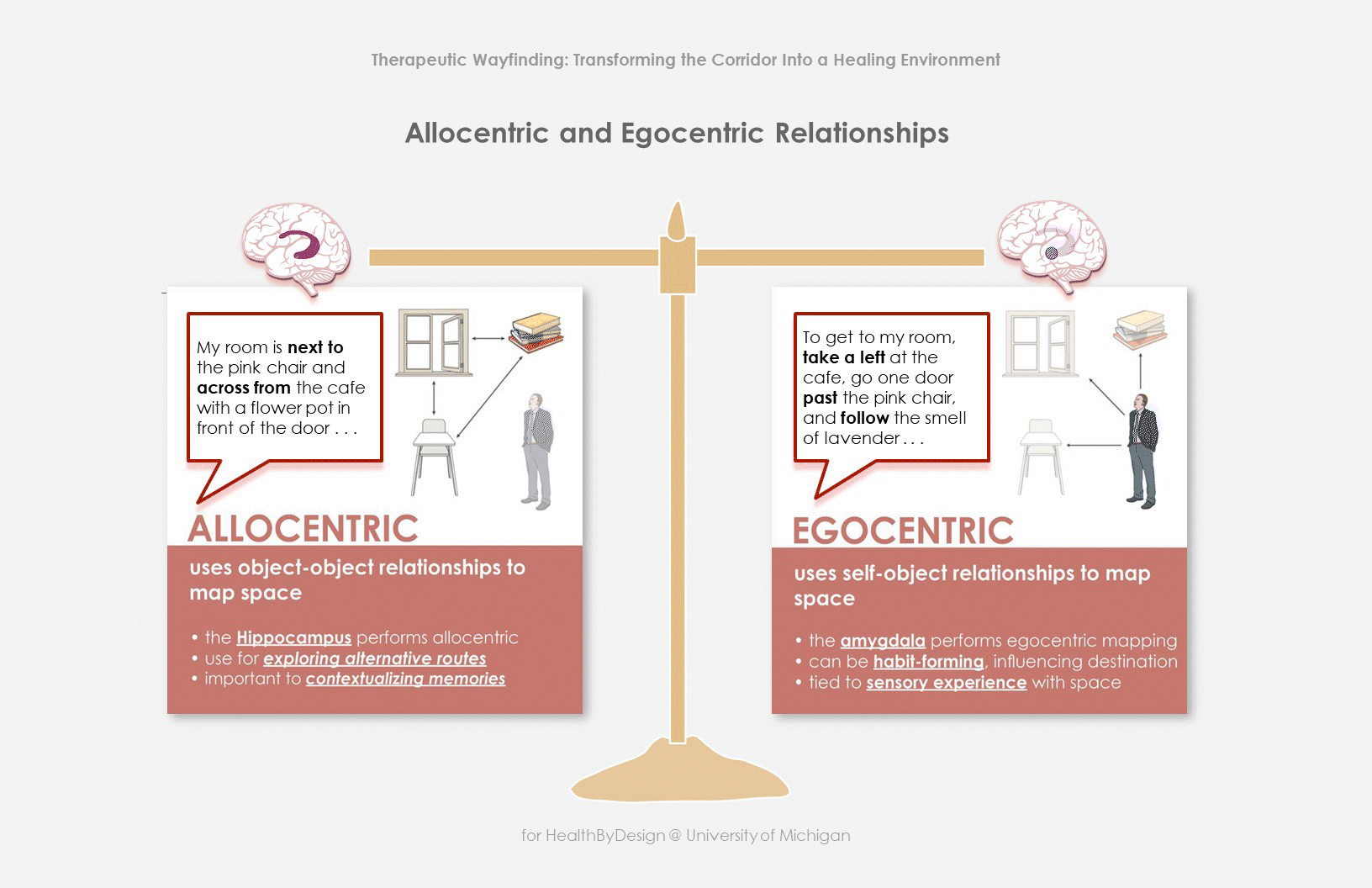
Dysregulation/ Graphic by Elyssa Bakker
Allocentric vs Egocentric / Graphic by Elyssa Bakker
Net Effect of Allocentric and Egocentric Imbalance / Graphic by Elyssa Bakker
Reliance on egocentric processing increases trauma survivor’s need to rely on sensory cues for wayfinding which then heightens the chances for dysregulation. Experiencing a trigger, due to intrusive cognitive or somatic memory may cause dissociation, flashbacks, and physiological responses. These intrusive memories occur from an inability to ground oneself due to detached sensory stimuli causing disconnection from the present moment and place. Transitional spaces, for instance corridors are particularly triggering due to unfiltered stimuli, lack of identity markers and absence of places or tools for re-regulation. Reregulation and grounding techniques often use sensory cues, sound, touch, sight to connect an individual to the here and now, reassure them of safety and/or detach from emotional pain (Ottoboni, 2013). Therefore, we question how corridors, where dysregulation may occur, can be transformed into a space that provides in its design ways for continuous re-regulation and supports therapeutic wayfinding. Trigger-inducing experiences within the corridor can be inhibitors to autonomous exploration and community participation, and both activities are essential to healthy-aging. By removing stressors from the corridors, as well as building well-designed grounding elements and navigational cues, this project intends to facilitate therapeutic wayfinding and increased autonomy within vulnerable residential communities.
The Corridor: Unfiltered Anxiety Inducing / Graphic by Elyssa Bakker, Chun-Li Chen
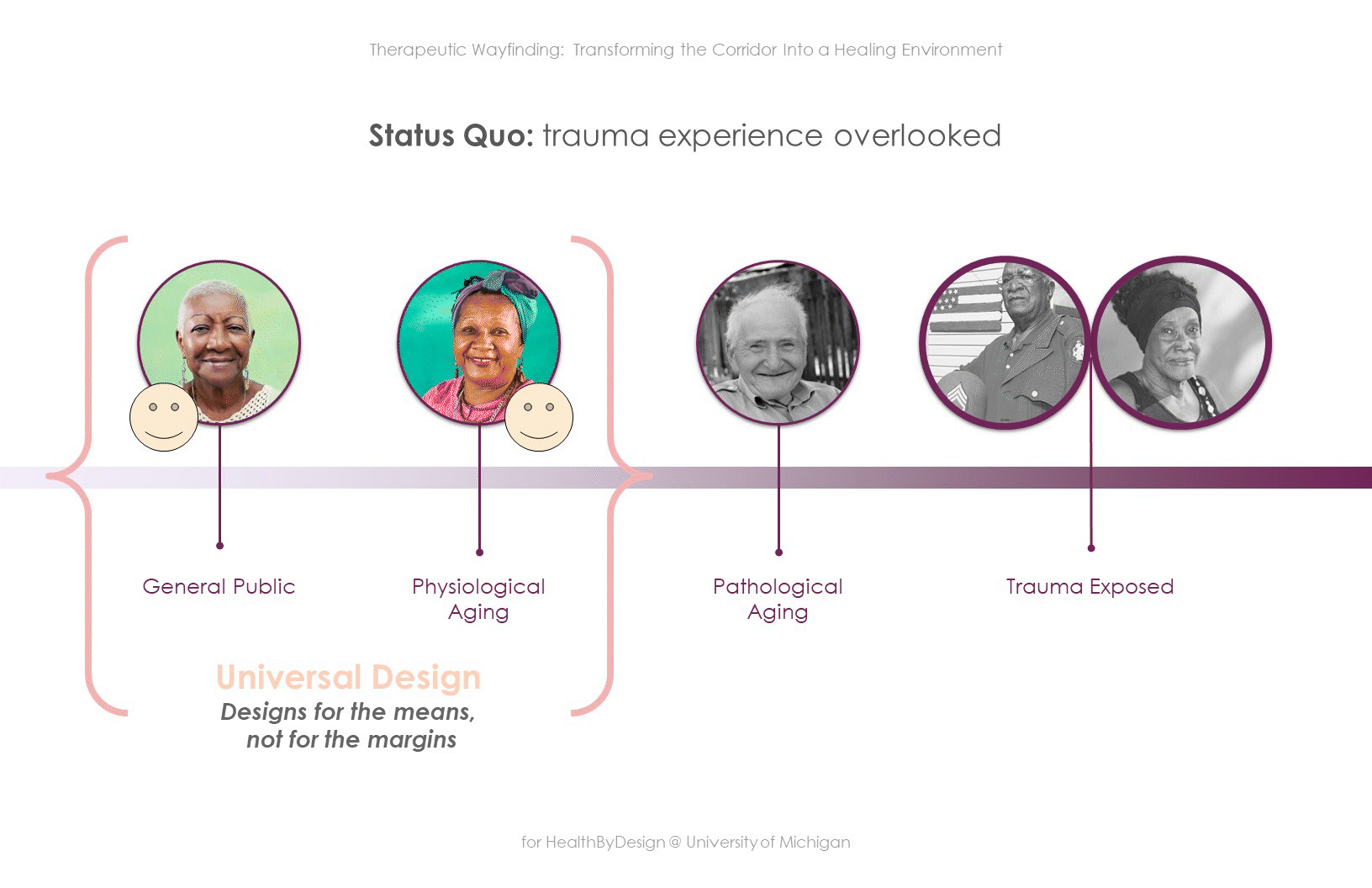

Personas and their inaccessible loop / Graphic by Chun-Li Chen, Elyssa Bakker; Persona created by Irene Routte
Personas and their inaccessible loop / Graphic by Aidan Barron
We are designing for those who have experienced trauma because when we design for those who are most vulnerable around us, we design for everyone. While Universal Design is geared towards the design of environments that are usable by all people, it does not take into account the specific ways that spatial navigation differs for those who are experiencing PTSD and symptoms of trauma (The Center for Universal Design, 2021). Furthermore, according to the Substance Abuse and Mental Services Administration, 61% of men and 51% of women in the United States have been exposed to at least one traumatic event in their lifetimes (Van den Berk-Clark, 2017). If we neglect the experience of such a great number of our community members, we are not designing with a perspective of better health for all.
Hypothesis / Hypotheses
- If we improve allocentric cues through placemaking and distinct audiovisual landmarks, we can facilitate wayfinding and re-regulation for trauma exposed and aging adults.
- If we embed identity anchors, such as personalized features and interactive tactile activities along the corridor, egocentric navigation can be improved, route-learning can be reinforced, and re-regulation can be better supported for trauma-exposed adults.
Who are we designing for and the relationship with design continuum / Graphic by Chun-Li Chen (Julie), Elyssa Bakker ; Concept Develop by Aidan Barron, Chun-Li Chen, Elyssa Bakker, Irene Routte
We are focused on designing interventions for seniors living in Federally subsidized, low income independent living at Woodbridge Village in Detroit. Elders living there are 62 years and older and are majority African American. We are particularly designing for those who may be the most vulnerable within this space. Those who have experienced multiple instances of trauma, and may have not had access to care at younger ages due to lack of resources or stigma. Examples of personas that we are designing for include elders who have experienced complex trauma, Intimate Partner Violence (IPV), chronic houselessness, witnessing community violence, experience of historical trauma and PTSD from service in the military.
Research Path / Graphic by Chun-Li Chen (Julie), Elyssa Bakker;
Concept
Develop
by Aidan Barron, Chun-Li Chen, Elyssa Bakker,
Irene Routte
How
This design challenge was first formulated through field observation at Woodbridge Village. After this occurred we conducted a thorough literature review of cognitive changes, spatial navigation and trauma. We looked at both peer reviewed sources, as well as sources from current practitioners in the design field. Based on several previous case histories, we created two personas with differing trauma histories and differing symptoms (dysregulation and dissociation) who we aimed to design for. In addition we consulted with two professors of Social Work who specialize in trauma informed interventions as well as trauma and cognition.

Design Intervention/ Graphic by Chun-Li Chen, Elyssa Bakker; Concept Develop by Aidan Barron, Chun-Li Chen, Elyssa Bakker, Irene Routte
What
Trauma informed design principles speculate that grounding elements such as identity anchors--achieved through personalization of space and somatic interactions--and contextual maps--achieved through distinct landmarks--can provide the needed opportunities for re-regulation along corridors. We will improve allocentric navigational performance which will provide opportunities for both re-regulation and reduction of intrusive memories. This will also impact the ability for those relying heavily on egocentric wayfinding. Designing corridors that provide context cues as well as places to continuously reregulate will improve willingness of residents to leave room and explore and create a greater sense of residential autonomy. These elements can also be leveraged to improve wayfinding for the benefit of not only trauma-exposed individuals, but the broader population by enhancing allocentric and egocentric cues for route learning ensures safety, choice, and empowerment.
Design Outcomes/ Graphic by Chun-Li Chen, Elyssa Bakker; Concept Develop by Aidan Barron, Chun-Li Chen, Elyssa Bakker, Irene Routte
Design To Outcomes
Designing contextual relationships and distinct landmarks within the built environment
- Attends to hippocampal changes by increasing individuals allocentric wayfinding abilities
- Attends to amygdala changes by providing spaces and places for re-regulation along corridors.
So What
Using trauma-informed design interventions ensure that all residents, especially those who are most marginalized, have the confidence and comfort to move through in their living space. Confidence in mobility increases autonomy which affects both social interaction as well as the potential of further cognitive decline. Increasing wayfinding abilities for a longer period of time allows for less caregiver support, as well as promotes autonomy, which is a factor in preventing further cognitive decline. By focusing on trauma informed wayfinding for the most vulnerable; elderly, minoritized communities, those with mental, developmental and physical disabilities, we in fact design more accessible and equitable environments for all.
︎︎︎Link To Project Research Miro Board
︎︎︎Link To Project The Design Continuum Paper
︎
Works Cited
1. Cicago style Citation“Allocentric vs. Egocentric Spatial Processing.” Imagery Lab RSS. Accessed December 8, 2021. https://www.nmr.mgh.harvard.edu/mkozhevnlab/?page_id=308.
2. Caballar, R. D. (2021, October 7). Neuroaesthetics: Mental Health Facilities of the Future. NEO.LIFE. Retrieved October 13, 2021, from https://neo.life/2021/10/neuroaesthetics-mental-health-facilities-of-the-future/.
3. Clay, J. (2019, April 19). For Alzheimer's and Dementia Patients, Thoughtful Design Can Have Big Impact. USC School of Architecture. Retrieved October 12, 2021, from https://arch.usc.edu/news/for-alzheimers-and-dementia-patients-thoughtful-design-can-have-big-impact.
4. Doeller CF, King JA, Burgess N (2008) Parallel striatal and hippocampal systems for landmarks and boundaries in spatial memory. Proc Natl Acad Sci U S A 105:5915–5920, doi:10.1073/pnas.0801489105, pmid:18408152.
5. Fidalgo, C., Martin, C. The Hippocampus Contributes to Allocentric Spatial Memory through Coherent Scene Representations. Journal of Neuroscience 2, March 2016, 36 (9) 2555-25557; DOI: 10.1523/JNEUROSCI.4548-15.2016
6. Fitzgerald, J. M., DiGangi, J. A., & Phan, K. L. (2018). Functional Neuroanatomy of Emotion and Its Regulation in PTSD. Harvard review of psychiatry, 26(3), 116– 128. https://doi.org/10.1097/HRP.0000000000000185.
7. Jhirad, D. (2021, September 21). Trauma-informed design. Davis Brody Bond. Retrieved October 12, 2021, from https://www.davisbrodybond.com/events-dialogues2/dbb-aia-discover-architecture-2021-zt5dh.
8. Kuliga S, Berwig M, Roes M. Wayfinding in People with Alzheimer’s Disease: Perspective Taking and Architectural Cognition—A Vision Paper on Future Dementia Care Research Opportunities. Sustainability. 2021; 13(3):1084. https://doi.org/10.3390/su13031084
9. Marquardt, G. (2011). Wayfinding for People with Dementia: A Review of the Role of Architectural Design. HERD: Health Environments Research & Design Journal, 4(2), 75–90. https://doi.org/10.1177/193758671100400207
10. Mollerup P. (2016) The Challenge of Wayfinding in Health Care Environments. In: Hunter R., Anderson L., Belza B. (eds) Community Wayfinding: Pathways to Understanding. Springer, Cham. https://doi-org.proxy.lib.umich.edu/10.1007/978-3-319-31072-5_6
11. Ottoboni G. (2013). Grounding clinical and cognitive scientists in an interdisciplinary discussion. Frontiers in psychology, 4, 630. https://doi.org/10.3389/fpsyg.2013.00630
12. Smith, K., Burgess, C. Brewin, C. Impaired allocentric spatial processing in posttraumatic stress disorder,Neurobiology of Learning and Memory, Volume 119, 2015, Pages 69-76, https://doi.org/10.1016/j.nlm.2015.01.007.
13. “The Center for Universal Design.” Center for universal design NCSU - about the center - Ronald L. Mace. Accessed December, 2021. https://projects.ncsu.edu/ncsu/design/cud/about_us/usronmace.htm.
14. Wiener, J.M., Pazzaglia, F. Ageing- and dementia-friendly design: theory and evidence from cognitive psychology, neuropsychology and environmental psychology can contribute to design guidelines that minimise spatial disorientation. Cogn Process (2021). https://doi.org/10.1007/s10339-021-01031-8
15. van den Berk-Clark, C., & Patterson Silver Wolf, D. (2017). Mental Health Help Seeking Among Traumatized Individuals: A Systematic Review of Studies Assessing the Role of Substance Use and Abuse. Trauma, violence & abuse, 18(1), 106–116. https://doi.org/10.1177/1524838015596344
︎ Chair, Clinic, and the Classroom
The school nurse’s office is the first place where many students feeling ill go to receive medical attention. Instead of this place being a middleman in the step to seeing a real doctor, what if our primary care health system was rooted within schools? Care from the first point of contact can aid in the timely diagnoses of patients, help lower the spread of illnesses, and shorten recovery times.
By Blaise Gimber ︎ , Andrew Hoover ︎
[Our project lies on the product stage of the design continuum, existing in a school environment]
Why
Primary care clinics can be a child’s worst nightmare. We seek to remove the fear and necessity of visiting the doctor’s office by making access to care more convenient and comfortable.

[Tommy Boy Persona]
How
We are bringing care to children directly at their school by boosting the capabilities of current nurse’s offices, making them somewhere students can feel safe, looked after, and comfortable while being diagnosed.
[School Nurses must play a larger role]
What
An at-school clinic that possesses the ability to diagnose students and provide care at the first point of contact through the use of a welcoming and comfortable check-in-chair environment.
[Interior Perspective of a child-catered “Check-In-Chair”]
So What
Create a more efficient and engaging check-in experience that creates more accurate vital tracking and a more pleasurable waiting experience. Care is achieved from the first point of contact at a location one goes to every day.
Design To Outcomes
In our nation access to care is an important issue. Statistics show “as many as 25% of Americans do not have a primary care provider.” In addition, “In 2020, 4.3 million children under the age of 19 — 5.6% of all children — were without health coverage for the entire calendar year.” The importance of universal access to care as well as having a established primary care doctor can not be understated. Primary care physicians serve as the first point of care, keep detailed medical records, monitor and treat chronic health conditions over time, as well as provide referrals if you need advanced care from a specialist. Through the help of C-cubed, we aim to solve all issues of accessibility to care as schools are the most frequented establishment in a child’s day-to-day life and abundant in every community.
C-cubed would carry a full staff of knowledgeable physicians, integrated check-in chairs with diagnostic capabilities, and comprehensive exam/consultation spaces. Every child within the school community would have not only convenient access to care, but also consistent access to care throughout their adolescent years.
Ultimately through the help of C-cubed, we aim to skip the steps of patients “Reaching out”, “Making an appointment”, and “Visit” by going immediately from “Feeling sick” to “Diagnostic” and “Check out”.

[Steps of the Health Continuum]
Links to Follow:
︎︎︎Two Page Report
︎︎︎Miro Board
︎
Works Cited
“A Successful Public Health Experiment: School - ProQuest.” 2006. Www.proquest.com. May 23, 2006. https://www.proquest.com/docview/199456931?fromopenview=true&pq-origsite=gscholar&parentSessionId=%2B9sc5eJjJhOzIkh2jjvRpv4UKsHTGjPciSXzufL4Xoo%3D.
Bureau, US Census. 2021. “Uninsured Rates for Children in Poverty Increased 2018–2020.” The United States Census Bureau. September 14, 2021. https://www.census.gov/library/stories/2021/09/uninsured-rates-for-children-in-poverty-increased-2018-2020.html.
CDC. 2021. “Recognizing School Nurses.” Centers for Disease Control and Prevention. April 27, 2021. https://www.cdc.gov/healthyschools/features/school_nurse.htm.
medgadget. 2014. “EarlySense Chair Sensor Monitors Vitals through the Butt | Medgadget.” Https://Www.medgadget.com/. July 7, 2014. https://www.medgadget.com/2014/07/earlysense-chair-sensor-monitors-vitals-through-the-butt.html.
Nakhleh, Morad K., Haitham Amal, Raneen Jeries, Yoav Y. Broza, Manal Aboud, Alaa Gharra, Hodaya Ivgi, et al. 2016. “Diagnosis and Classification of 17 Diseases from 1404 Subjects via Pattern Analysis of Exhaled Molecules.” ACS Nano 11 (1): 112–25. https://doi.org/10.1021/acsnano.6b04930.
Stergiou, George S., Nikolaos J. Yiannes, Vayia C. Rarra, and Christina V. Alamara. 2005. “White-Coat Hypertension and Masked Hypertension in Children.” Blood Pressure Monitoring 10 (6): 297–300. https://doi.org/10.1097/00126097-200512000-00002.
“Trends in Suicidal Ideation-Related Emergency Department Visits for Youth in Illinois: 2016–2021.” 2022. Aap.org. 2022. https://publications.aap.org/pediatrics/article/150/6/e2022056793/189943/Trends-in-Suicidal-Ideation-Related-Emergency.
“Why You Need a Primary Care Physician.” n.d. Www.fhcp.com. https://www.fhcp.com/fhcp-news/2021/october/why-you-need-a-primary-care-physician/#:~:text=Statistics%20show%20as%20many%20as.
︎ ︎Redefining the Point of Entry: Heal as You Wait
We want to re-innovate the first point of entry in primary care facilities. Taking the waiting room out of the picture, and implementing spaces that promote healing.
By Dureti Ahmed ︎ , Devin Chaldecott ︎, Dua Duran ︎, Prakriti Vasudeva ︎
Why
Healthcare and care accessibility are extremely critical acts of service for communities, the first point of entry both in the physical and digital realm are often isolating and claustrophobic spaces that produce feelings of anxiety, uncertainty, stress, and unproductivity. These suffocating environments do not cater to the health and well being of patients and users who are searching for personalized care. As it stands, waiting rooms increase stress and produce feelings of intimidation around going into primary care visits. According to CapeCod Health, 63% of Americans admit they have waiting room anxiety and state that “the most stressful thing about going to their doctor was sitting in the waiting room.”
How
By intervening in both the physical and digital realm, we can offer opportunities for new points of influence for the waiting room experience that reduces patient anxieties, nurtures productive states of mind, will make the health care and waiting experience less intimidating and more familiar, and allow calm and soothing emotions overall.
What
Our app Helping Hand- will bridge the gap between patients and providers, and offers resources about scheduling, will request that you fill out pre- visit questionnaires about your health and well being as well as your personal interests in order to personalize your digital waiting room space and save time before meeting your doctor, provides information about the process of digital and physical appointments, keeps you updated on your patient wait status, and provides links to positive distractions such as healing spaces within and outside of the primary care space that can help reduce patient anxiety significantly. If a patient decides to select a digital appointment option, the app will send you a link to a digital waiting space that is extremely personalized to your likes and interests based on the answers you provided in the pre-visit questionnaire. These personalizations include the website background being your favorite color, and the option to watch your favorite netflix show, movie, or meditation videos in order to make patients feel comfortable, safe, and cared for. This playful and interactive method of engaging with patients will promote a sense of calm and establish personalization that positively distracts them during this anxious and uncertain period. If you choose the physical appointment option, the physical waiting space includes healing and stress relieving programs such as gardens, open reading spaces, and exercise centers that allows for independent and autonomous movement, and keeps patients preoccupied and productive in environments that have been proven through research to be inherently therapeutic and inviting. The healing programs can also be accessed by different members of the community who aren't visiting strictly for primary care.

So What
By making the waiting room experience more familiar, inviting, and stress relieving, patients would feel more comfortable entering healthcare spaces and having more communication with their doctor overall. When the waiting room space is as familiar and close to home as opening up your laptop and watching your favorite show, or as stress relieving as walking through a garden and entering quiet space of a public reading area– the entry point and process of primary care will feel very safe and nurturing and would encourage and support people to reach out to their doctor. It's important to take care of patients through every step in the process, and it's vital to recognize how the first step in that process, and the amount of stress that that induces, could affect the rest of the health care process. With our project, we are taking care of our patients right from the beginning.
Design To Outcomes
We are designing waiting spaces that promote healing, safety, and familiarity. Improving patient experience/feelings in the waiting space, with the implementation of meditation, other positive distracting activities, and personalization tactics. We hope to better the readiness of patients and the entire visit overall. All while, redefining the point of entry so that the initial entry to a primary care visit no longer looks like a waiting room.
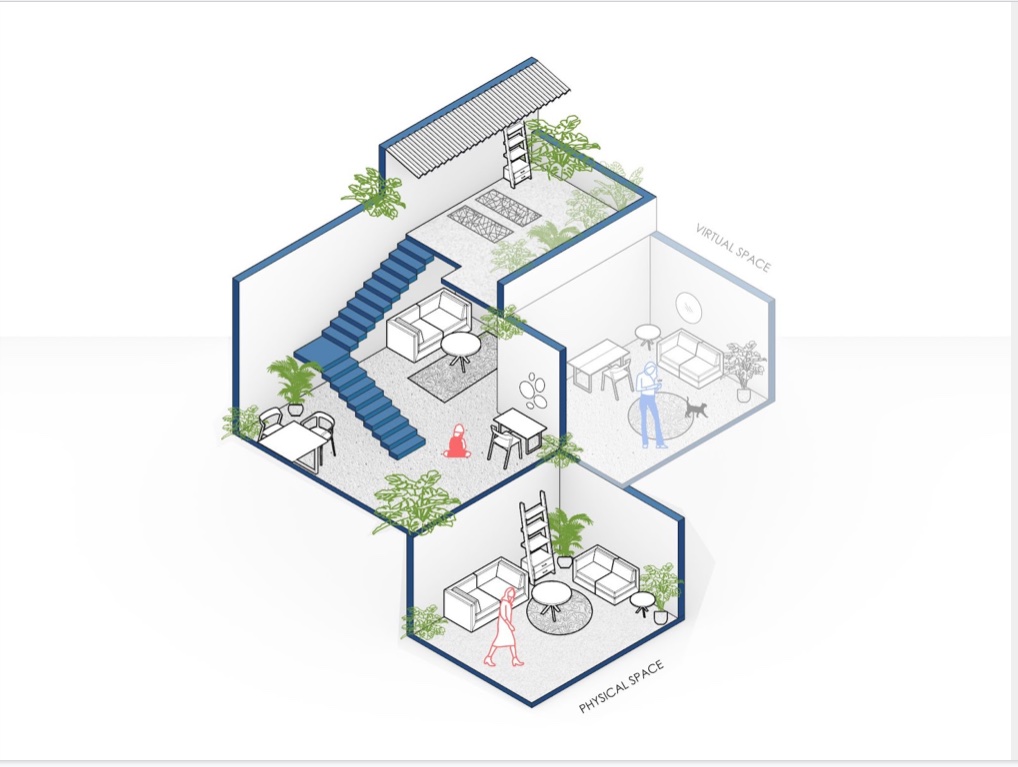
Links to Follow:
︎︎︎Two Page Report
︎︎︎Miro Board
︎
Works Cited
- Lombardi, Beth Ann. “A Mindful Approach to Waiting Room Anxiety - Cape Cod Healthcare.” Cape Cod Healthcare, 29 Oct. 2019, www.capecodhealth.org/medical-services/behavioral-health/a-mindful-approach-to-waiting-room-anxiety/.
- Das, Lala Tanmoy. “What Science Tells Us about the Mood-Boosting Effects of Indoor Plants.” The Washington Post, WP Company, 8 Sept. 2022, www.washingtonpost.com/wellness/2022/06/06/how-houseplants-can-boost-your-mood/.
- “15 Things to Do on a Layover at Singapore Changi Airport.” Sleeping in Airports, 20 Oct. 2021, www.sleepinginairports.net/layovers/things-to-do-on-a-layover-at-singapore-changi-airport.htm.
- Team, GoodTherapy Editor. “Bibliotherapy.” GoodTherapy, GoodTherapy, 5 Sept. 2016, www.goodtherapy.org/learn-about-therapy/types/bibliotherapy.
- “Infographic: Average Wait Times to See a Doctor.” RelyMD, 6 Mar. 2020, relymd.com/blog-infographic-average-wait-times-to-see-a-doctor/.
- Tšernov, Kirill. “Disney and the Art of Queuing.” Qminder, Qminder, 1 Dec. 2017, www.qminder.com/blog/queue-management/disney-queueing/.
- PatientEngagementHIT. “83% Of Patients Predict Long-Term Telehealth Care Access.” PatientEngagementHIT, 23 June 2020, patientengagementhit.com/news/83-of-patients-predict-long-term-telehealth-care-access.
- Hackett, Mallory. “Patients Report Scrolling on Social Media, Exercising and Drinking during Virtual Doctor Appointments.” MobiHealthNews, 28 Oct. 2020, www.mobihealthnews.com/news/patients-report-scrolling-social-media-exercising-and-drinking-during-virtual-doctor.
- Truffa, Luciana. “Healing Gardens: Nature as Therapy in Hospitals.” ArchDaily, ArchDaily, 13 Dec. 2021, www.archdaily.com/972112/healing-gardens-nature-as-therapy-in-hospitals.
- “20 Stats: How Do Patients Feel about Telehealth?” EVisit, 27 June 2016, evisit.com/20-stats-how-do-patients-feel-about-telehealth#:~:text=The%20average%20wait%20time%20for,that%20of%20in%2Dperson%20visits.
- Alrajhi, Khaled N, et al. “Effect of Waiting Time Estimates on Patients Satisfaction in the Emergency Department in a Tertiary Care Center.” Saudi Medical Journal, U.S. National Library of Medicine, Aug. 2020, www.ncbi.nlm.nih.gov/pmc/articles/PMC7502966/.
- Mills, Terence. “Council Post: How Health Care Apps Can Improve Patient Health and Support Physicians.” Forbes, Forbes Magazine, 4 Sept. 2019, www.forbes.com/sites/forbestechcouncil/2019/09/04/how-health-care-apps-can-improve-patient-health-and-support-physicians/?sh=5feaac98772b.
- “5 Benefits of Online Scheduling for Healthcare Practices.” PatientPop, 24 Mar. 2022, www.patientpop.com/whitepapers/3-benefits-of-online-scheduling/.
- LLC, Consagous Technologies. “Otboo: Doctor's Appointment Scheduling App.” Top Digital Agency, 3 Sept. 2019, topdigital.agency/case-study/otboo-doctors-appointment-scheduling-app/.
- Franco, Lara S, et al. “A Review of the Benefits of Nature Experiences: More than Meets the Eye.” International Journal of Environmental Research and Public Health, U.S. National Library of Medicine, 1 Aug. 2017, www.ncbi.nlm.nih.gov/pmc/articles/PMC5580568/.
- Yeo, Lee Bak. “Psychological and Physiological Benefits of Plants in the Indoor Environment: A Mini and in-Depth Review.” International Journal of Built Environment and Sustainability, ijbes.utm.my/index.php/ijbes/article/view/597.
- Jercich, Kat. “Telehealth's Awkward Waiting Room Problem, and How One Company Aims to Solve It.” Healthcare IT News, 23 Apr. 2021, www.healthcareitnews.com/news/telehealths-awkward-waiting-room-problem-and-how-one-company-aims-solve-it.
- “Preparing for a Virtual Visit.” Telehealth.HHS.gov, telehealth.hhs.gov/patients/preparing-for-a-video-visit/.
- Heath, Sara. “Virtual Waiting Rooms Key for Post-Covid Patient Experience Efforts.” PatientEngagementHIT, 20 Apr. 2021, https://patientengagementhit.com/news/virtual-waiting-rooms-key-for-post-covid-patient-experience-efforts.
- Gilpin, Gregory. “Public Libraries Continue to Adapt, Enriching Communities across America.” Brookings, Brookings, 9 Mar. 2022, https://www.brookings.edu/blog/brown-center-chalkboard/2021/06/01/public-libraries-continue-to-adapt-enriching-communities-across-america/.
- Group, Priory. “Nature and Mental Health.” Priory, https://www.priorygroup.com/blog/nature-and-mental-health.
- Aycock, Anthony. “How Libraries Became Refuges for People with Mental Illness.” Slate Magazine, Slate, 22 Sept. 2022, https://slate.com/technology/2022/09/libraries-mental-health-support.html.
︎ Provider’s Plug
From feeling exhausted and burntout to feeling refreshed and engaged the creation of “pause points” and “nooks” in the primary care scene will allow for nurses and other healthcare providers to destress and relax to prevent the causes of burnout.
By Natalie Brown ︎, Cassidy Kohl ︎, Elaine (Siyuan) Cheng ︎,

Why
Burnout is a syndrome characterized by emotional exhaustion that results in depersonalization and decreased personal accomplishment at work. The emotionally exhausted clinician is overwhelmed by work to the point of feeling fatigued, unable to face the demands of the job, and unable to engage with others.
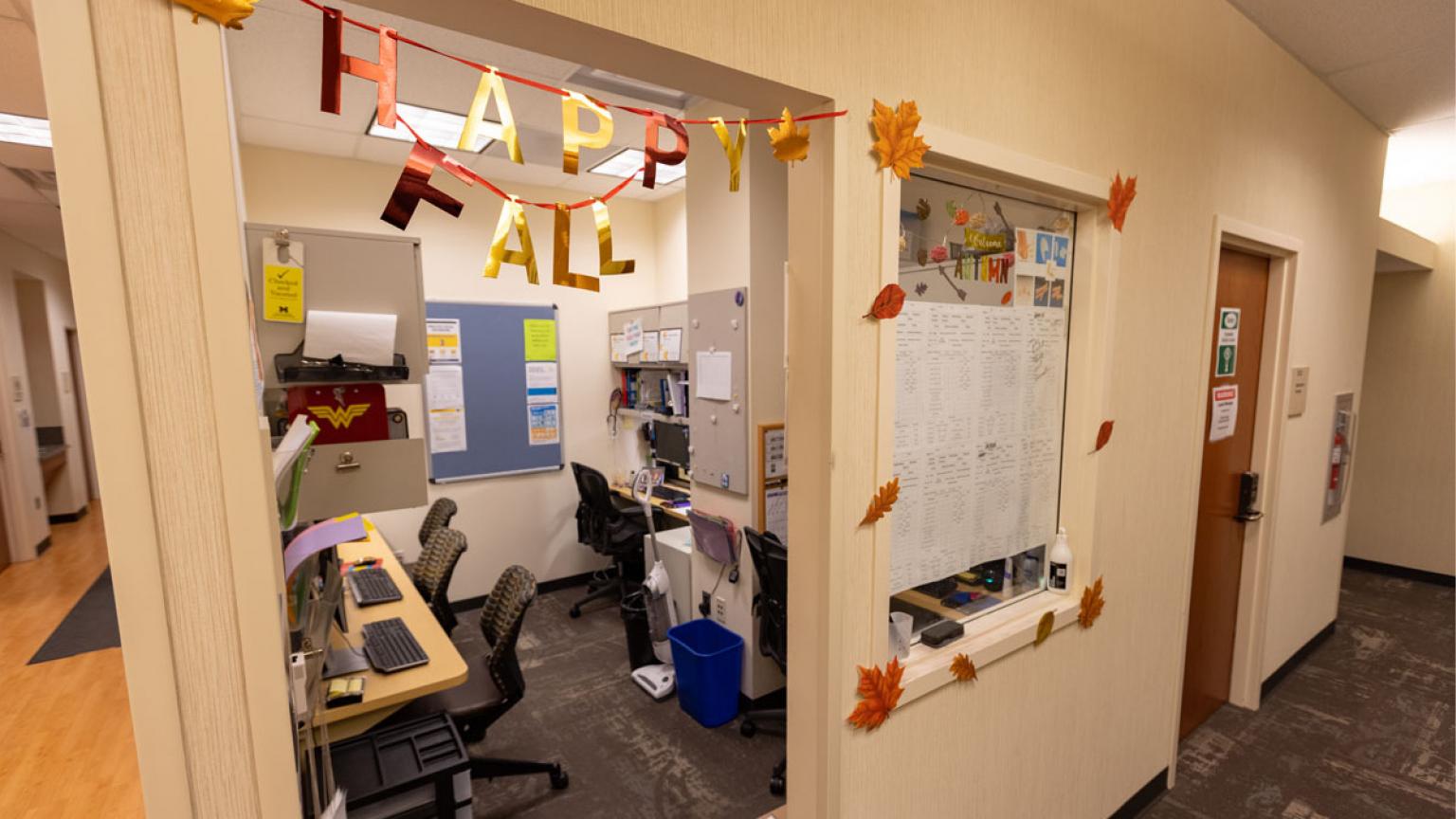

How
Through product and interior design, staff wellbeing can be improved. Clinics can enhance connecting spaces with pause points and wellness nooks, or by rethinking staff areas and unused spaces to include nooks or sensory features.
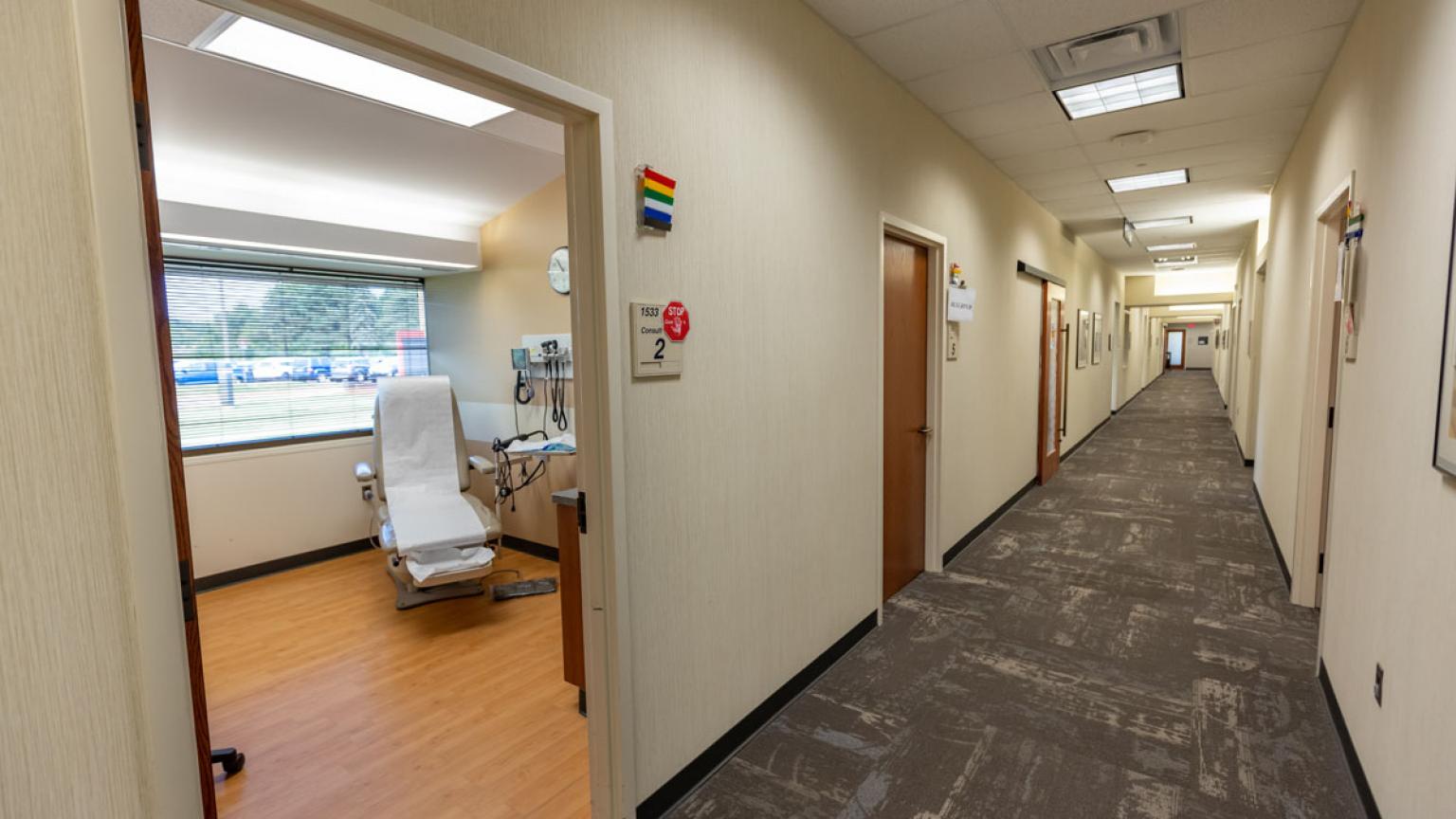

What
Pause points, or our Nook for example, could be positioned within the corridors of a clinic and preferably punching into unused areas. New delight design additions can be costly but strategically finding these areas within an existing clinic can reduce initial costs. The nook gives autonomy to providers at work.
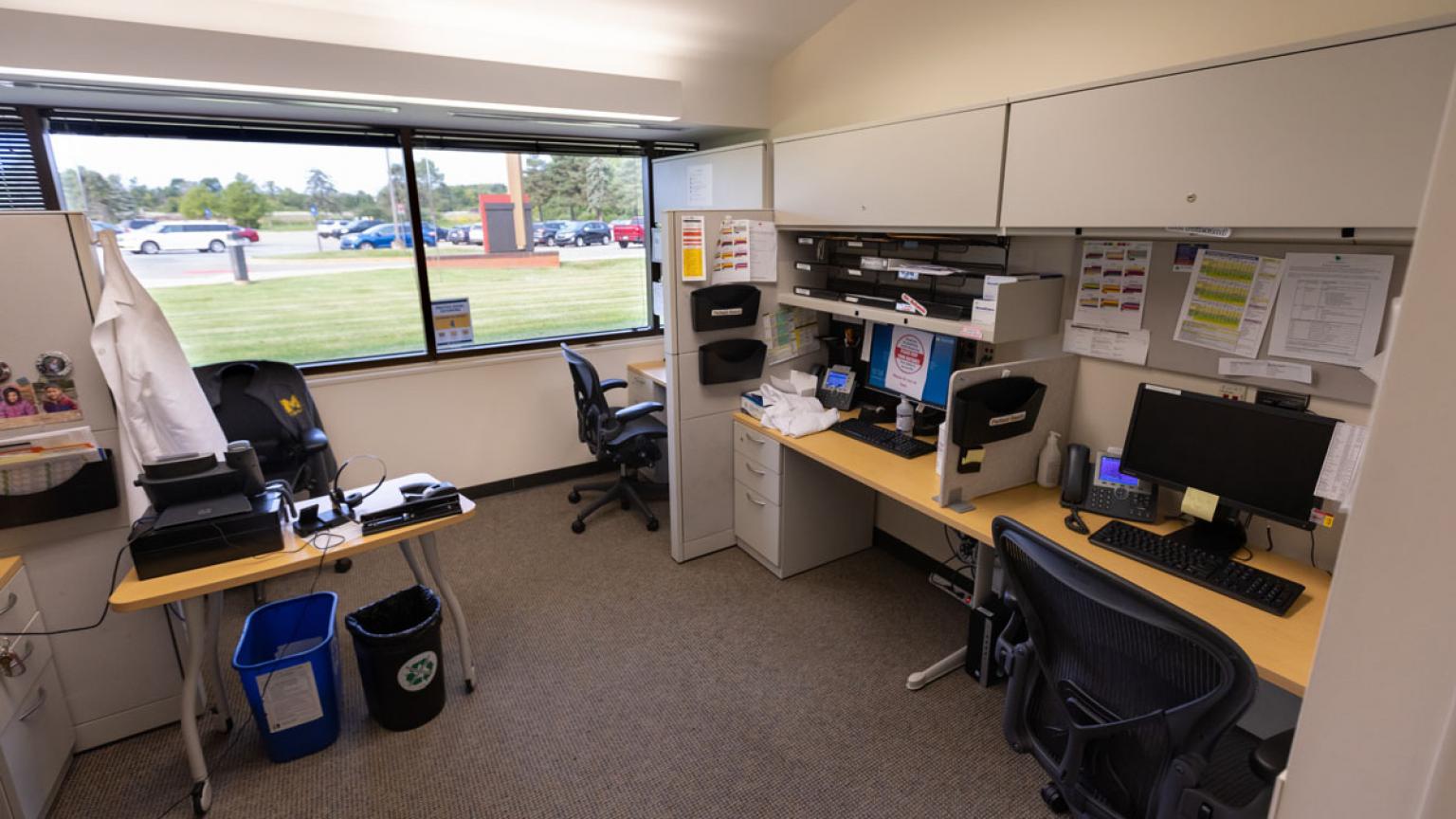

So What
Studies have proven that stress relief, relaxation and exercise can be effective in alleviating burnout among healthcare professionals, thereby improving patient satisfaction and quality of care. Short breaks in medical work can be effective in improving indicators of fatigue, burnout, depression and worn out, and thus improve the healthcare providers’ efficiency and performance
Design To Outcomes
Designing a series of “pause points” will take the form of “nooks” designed to provide healthcare providers with a short break in their work. Using different sensory experiences will give each “nook” a different character, providing a multi-dimensional relaxation and experience for the staff.
Links to Follow:
︎︎︎Two Page Report
︎︎︎Miro Board
︎
Works Cited
Nurse Burnout Statistics, Causes, Effects and Symptoms,https://www.berxi.com/resources/articles/nurse-burnout-statistics/
Burnout in Healthcare Workers: Prevalence, Impact and Preventative Strategies, https://www.ncbi.nlm.nih.gov/pmc/articles/PMC7604257/
Effective Holistic Approaches to Reducing Nurse Stress and Burnout During COVID-19, https://journals.lww.com/ajnonline/Fulltext/2022/05000/Effective_Holistic_Approaches_to_Redtarget="_blank">https://journals.lww.com/ajnonline/Fulltext/2022/05000/Effective_Holistic_Approaches_to_Reducing_Nurse.20.aspx target="_blank">20.aspx
Lubos, Lesley C. “The Role of Colors in Stress Reduction.” Liceo Journal of Higher Education Research, vol. 5, no. 2, 2008, https://doi.org/10.7828/ljher.v5i2.39.
Image Sources:
1. https://www.precheck.com/blog/3-ways-address-physician-burnout-healthcare
2. https://www.rxnt.com/provider-burnout-is-on-the-rise-whats-the-antidote/
3. https://journals.lww.com/ajnonline/Fulltext/2022/05000/Effective_Holistic_Approaches_
to_Reducing_Nurse.20.aspx
4. https://www.mountsinai.org/about/newsroom/podcasts/road-resilience/recharge-room
5. https://www.chausa.org/publications/catholic-health-world/archives/issues/pandemic-
coverage/icu-nurse-creates-relaxation-spaces-where-covid-care-providers-can-pause-and-
breathe
6. https://www.designweek.co.uk/issues/11-17-february-2019/a-hospital-relaxation-room-
to-make-cancer-treatment-less-daunting/
7. https://www.texashealth.org/Newsroom/News-Releases/2021/Zen-Rooms-Offer-
Tranquility-Relaxation-during-Pandemic
8. Domain's new HQ: A home away from home for employees - The Interiors Addict
9. All-In-One Touch Kiosks and Outdoor Kiosks | I&E Kiosk (iekiosk.com)
︎ Health Connect:
Creating an Equitable Community Health Ecosystem
Our aim is to create hyper-localized disruptions within a community’s
existing social determinants of health for better health outcomes.
By Natalie DeLiso ︎, Nina Lang ︎, Nehal Jain ︎, Angana Symanoy ︎


Why
The medical community is increasingly incorporating a set of principles called the Social Determinants of Health into assessments of patient health. Health Connect seeks to address these social determinants both physically and digitally to decrease isolation and activate underutilized urban space. According to Michigan's 2020 Primary Care Needs Assessment, Michigan has no shortage of primary care providers, but these providers are distributed unequally and are not always utilized even within densely populated healthcare networks. This is not just a Michigan problem: 80% of counties across the United States lack healthcare access according to a 2021 GoodRx Study. [Insert project name here] aims to provide a widely applicable framework of digital and physical interventions to move communities from underutilized space and disconnected community health services to engaged and connected health ecosystems for equitable health access.

Social Determinants of Health Pyramid. Source: http://www.healthydouglas.org/
How
Health Connect's physical interventions are scalable based on the existing healthcare infrastructures of each community. While an urban area like Detroit might have an abundance of physical clinics, location-activated healthcare reminders could be built into naturally occurring urban waiting spaces like bus stops or laundromats. Suburban environments like Livingston County might require interventions such as deployable popups or mobile clinics. Finally, because of the sprawling nature of rural environments, communities such as Clare County would require the most physical of interventions, with semi-permanent clinic buildings located near other local infrastructures like libraries, post offices, or grocery stores to ensure the most access for the most people.
The digital interface is conceived as the secondary connection between an individual and their health community, driven by the Social Determinants of Health. A series of "check ins" is available on the app seek to address different elements of the Social Determinants: A notification nudge for a grandchild to check on their grandparent who hasn't logged their medication intake in several days would address the "Social and Community Context" Determinant, for example. These digital interventions also become physical when addressing the "Healthcare Access" and "Neighborhood and Built Environment" Determinants with invitations to local popup health screenings, EMR tech literacy classes, and insurance enrollment drives.
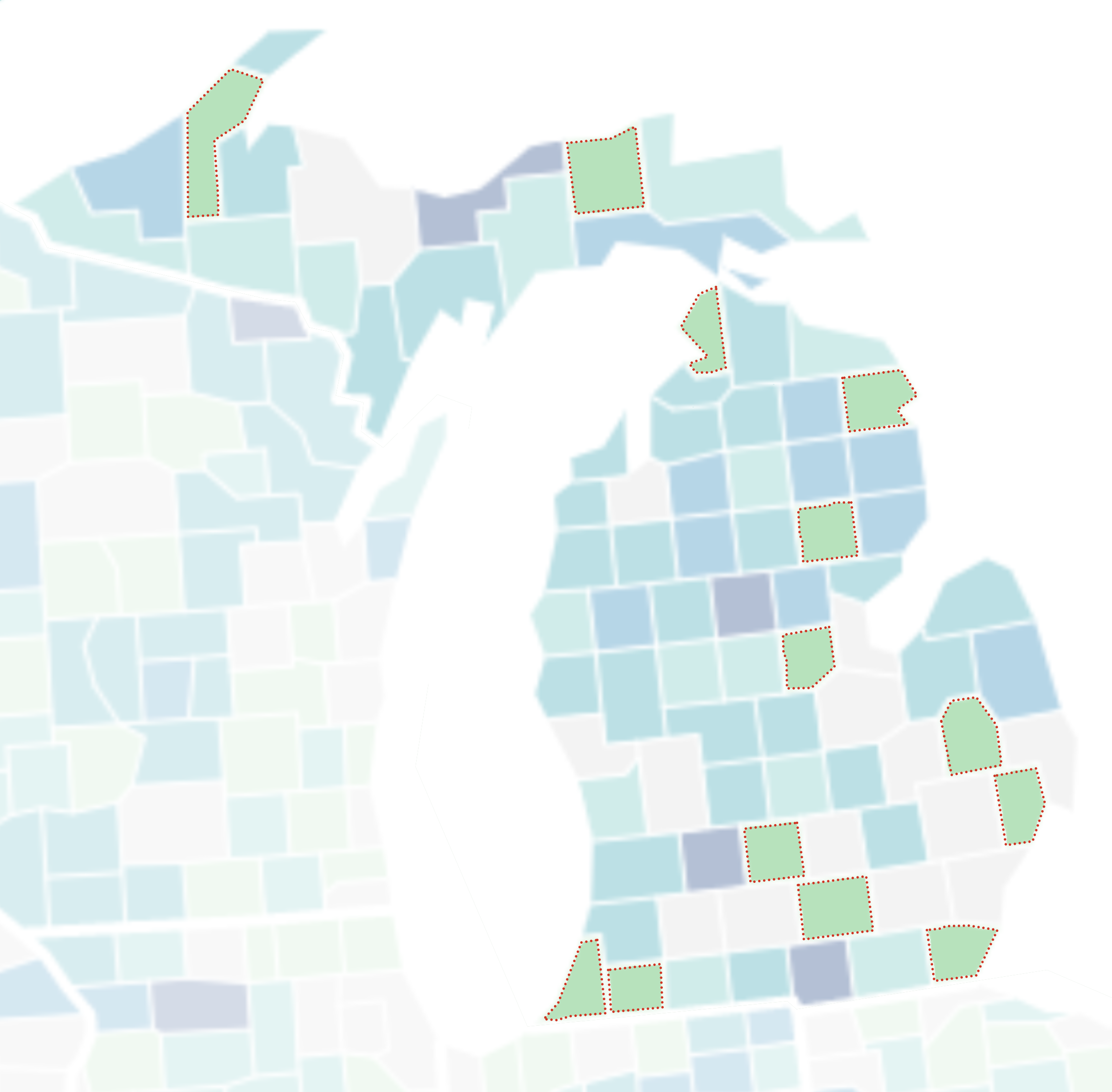
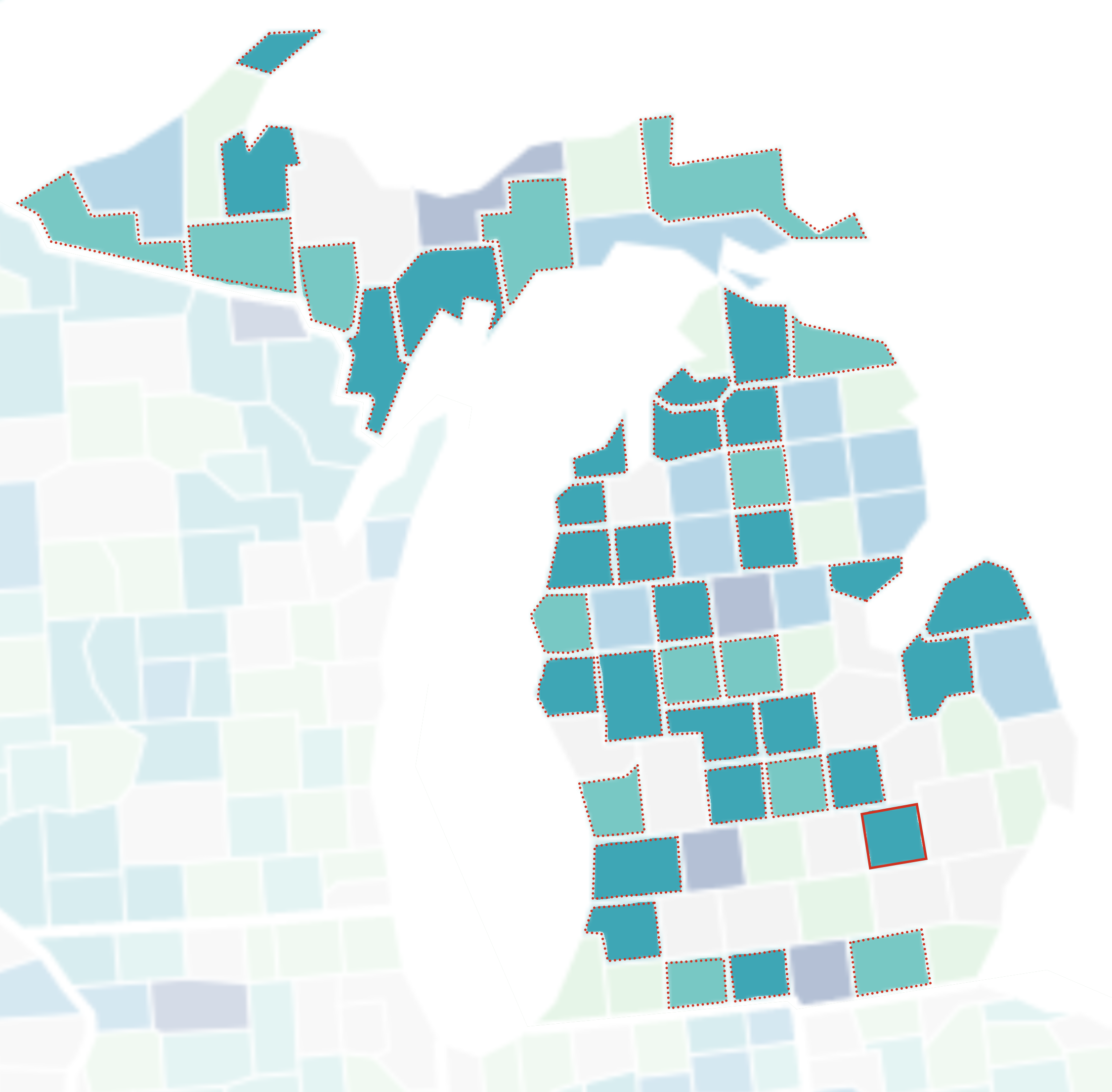
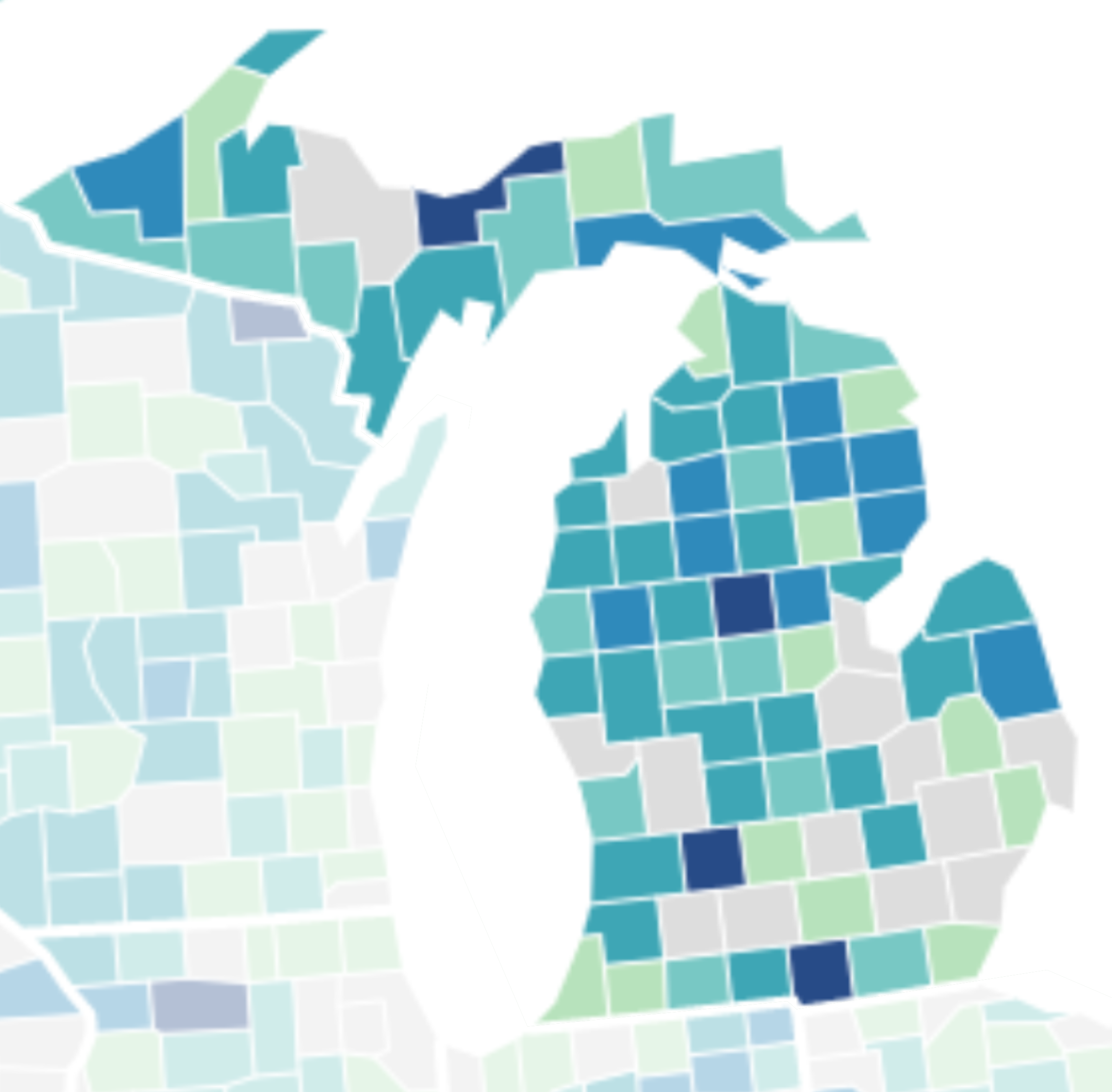
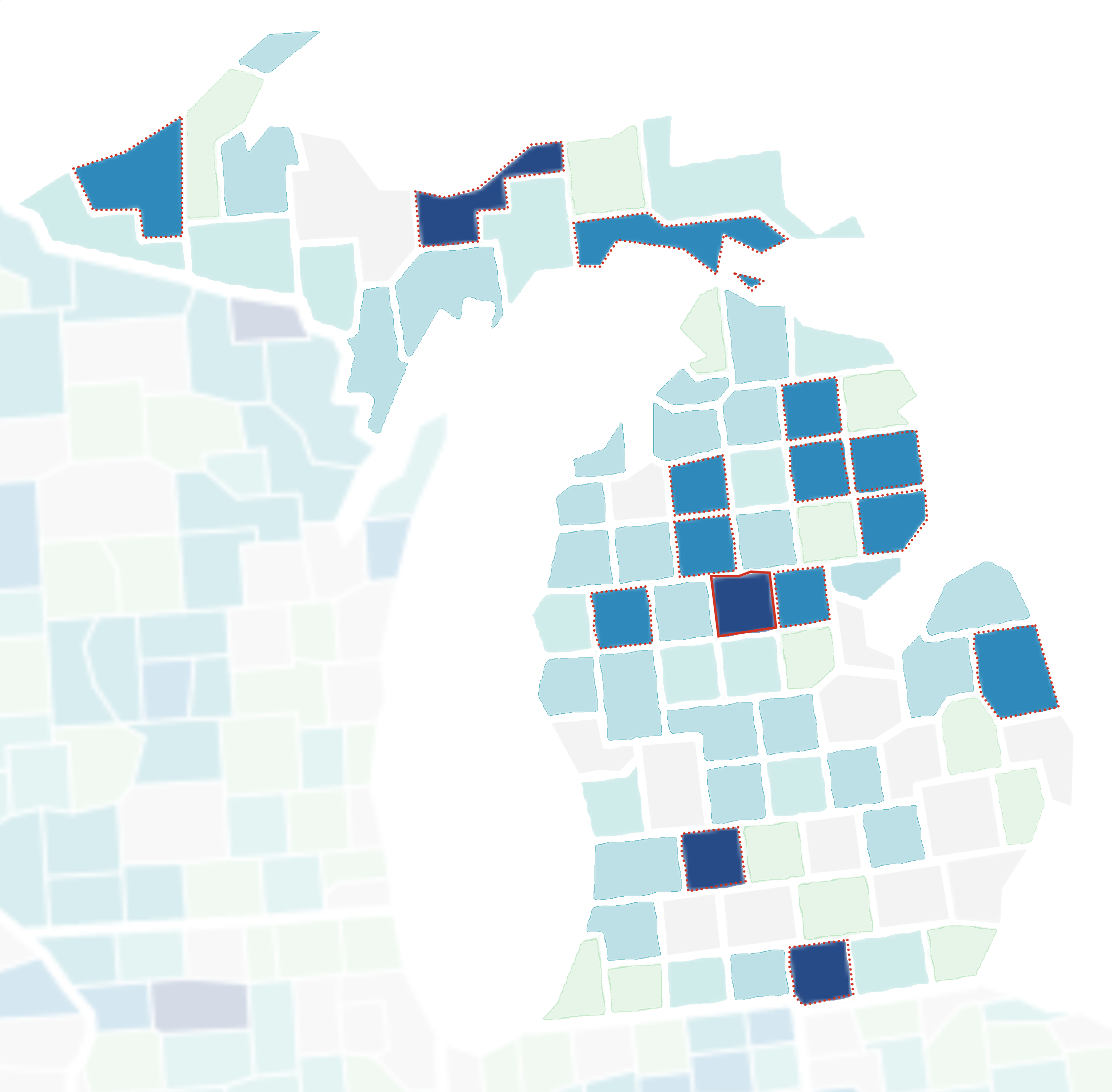
Mapping Healthcare Deserts in Michigan
What
To address the healthcare desert scenarios we identified in our research, we developed a series of physical interventions. Our three physical elements are augmented by our digital intervention: an app that we’ve developed. Each physical intervention is equipped with a wifi hotspot which can work in tandem with the app and encourage more interaction with Health Connect. Now we will walk through each intervention in more detail.
Our smallest-scale physical intervention makes use of space where people already wait in their daily lives and turns waiting time into a healthcare opportunity. Kiosks will be installed in natural waiting areas like grocery stores, laundromats, or bus stops. These kiosks will allow people to schedule appointments, update their health information, or chat with providers. This is most appropriate for low level deserts to create connections between existing healthcare infrastructures.
As we scale up in physicality and healthcare need, we move to our mobile intervention. These clinics take primary care to areas of highest need and provide care across various health disciplines: from vaccination stations, to pediatric pop-ups. Services would not necessarily be limited to medical needs, as these interventions could host classes on insurance and technology literacy. This would be most appropriate for medium level deserts to fill in gaps in communities with less substantial healthcare infrastructure.
Our final intervention is for communities with the highest level of healthcare need. For these communities, established infrastructure is either poor or nonexistent, and our intervention would involve construction of new clinics. This newly built infrastructure would be sited in a location with high local utilization to eliminate access issues. For example, a clinic could be sited near a school to provide care for sick children and make access easier for parents if they also need to see a doctor.
The digital element of our healthcare ecosystem is WebWell by Health Connect. This mobile app supports our physical interventions and promotes healthy and connected lifestyles for its users. Elements of the app address its three guiding principles: health behaviors, social connection, and environmental health. For example: badges, points, and check-ins foster better health behaviors while local events and digital buddies encourage social connectivity beyond the digital sphere.To further the environmental health of a community, geolocations are leveraged to notify users of Health Connect’s physical intervention locations.
The digital interface will provide a platform for information sharing and engagement among community members. People will be able to connect with individuals they already know and be encouraged to interact with new community members in the physical realm. Through information about local events, This point system will provide rewards for individuals, providing positive affirmations that encourage habitual healthy behavior. This intervention will also monitor health behaviors, providing feedback and insight into each user's personal health goals. This project aims to develop a digital platform that creates connections and encourages healthy habits to improve health outcomes and reduce disparities in these underserved communities.

Physical Interventions







Digital Interface
So What
By creating an expanded network of opportunities for connection and health services, underutilized areas in underserved communities will be transformed to create better social connections and health outcomes. This network will encourage community members to engage with their neighborhood and neighbors by providing easily accessible information and hyper-localized program options. These interventions will promote a wide range of healthy lifestyle behaviors. The proposal will encourage digital and physical interaction, each creating a feedback loop, furthering and encouraging engagement.
Physical interventions will activate underutilized urban, suburban, and rural spaces in the pursuit of health-centric communities. The digital connections within the community will encourage potentially isolated populations to attend healthcare-related spaces and events.

Building Block of Health Connect Interventions
Design To Outcomes
Ultimately, we aim for our physical and digital interventions to work together to promote healthy, connected communities. Health Connect will provide increased access to resources, with a firm grounding in addressing the Social Determinants of Health. We seek to leverage these Social Determinants to empower each individual in the community to take an active role in making healthier choices. By establishing a hub of services designed to meet the current and future needs of the community, this initiative will create positive, lasting change in the health outcomes of underserved populations.
Links to Follow:
︎︎︎Two Page Report
︎︎︎Miro Board
︎
Works Cited
- “Assets.ctfassets.net.” Accessed December 8, 2022. https://assets.ctfassets.net/4f3rgqwzdznj/1XSl43l40KXMQiJUtl0iIq/ad0070ad4534f9b5776bc2c41091c321/GoodRx_Healthcare_Deserts_White_Paper.pdf.
- “Assets.ctfassets.net.” Accessed December 8, 2022. https://assets.ctfassets.net/4f3rgqwzdznj/1XSl43l40KXMQiJUtl0iIq/ad0070ad4534f9b5776bc2c41091c321/GoodRx_Healthcare_Deserts_White_Paper.pdf.
- “Brighton Real Estate - Homes for Sale.” Brighton Real Estate - Homes for Sale. Accessed December 8, 2022. https://www.realestateone.com/community/mi/livingston-county/brighton/.
- “Change Systems.” Care Share Health Alliance, November 3, 2020. https://www.caresharehealth.org/partner-for-systems-change/.
- “City Health Dashboard.” City Health Dashboard, October 15, 4687. https://www.cityhealthdashboard.com/.
- “Civic Commons.” Studio Gang. Accessed December 8, 2022. https://studiogang.com/project/civic-commons.
- “Community Health Workers.” County Health Rankings & Roadmaps. Accessed December 8, 2022. https://www.countyhealthrankings.org/take-action-to-improve-health/what-works-for-health/strategies/community-health-workers.
- Constine, Josh. “Kitestring, the App That Makes Sure You Get Home Safe.” TechCrunch, April 16, 2014. https://techcrunch.com/2014/04/16/kitestring/.
- “Container to Clinic: Um-Designed Pop-up Clinic a First-of-Its Kind in Jamaica: GlobalReach: Michigan Medicine.” GlobalReach, January 27, 2020. https://medicine.umich.edu/dept/globalreach/news/archive/201611/container-clinic-um-designed-pop-clinic-first-its-kind-jamaica.
- “Containers 2 Clinics.” Stack + Co. Accessed December 8, 2022. https://stackac.com/projects/containers-2-clinics/.
- “Free Vectors, Stock Photos & PSD Downloads.” Freepik. Accessed December 8, 2022. https://www.freepik.com/.
- “Health Care Services for Uninsured Final Report - Nciom.org.” Accessed December 8, 2022. https://nciom.org/wp-content/uploads/2017/07/HealthCareServicesforUninsured_FinalReport.pdf.
- “Home.” Kindbody, October 25, 2022. https://kindbody.com/.
- “Homeless Pets Get Care at Pop Up Clinic: KCRW Features.” KCRW. KCRW, June 29, 2018. https://www.kcrw.com/news/shows/kcrw-features/homeless-pets-get-care-at-pop-up-clinic.
- “How Do Mobile Health Clinics Improve Access to Health Care?” School of Public Health, September 15, 2022. https://publichealth.tulane.edu/blog/mobile-health-clinics/.
- Lily Bohlke, Michigan News Connection. “Report: Mobile Health Clinics Reach Vulnerable Michigan Communities.” Detroit Metro Times. Detroit Metro Times, June 5, 2022. https://www.metrotimes.com/news/report-mobile-health-clinics-reach-vulnerable-michigan-communities-29790196.
- “Live Healthy Douglas.” Live Healthy Douglas, February 23, 2018. http://www.healthydouglas.org/.
- Marta. Accessed December 8, 2022. https://www.itsmarta.com/station-soccer.aspx.
- Media, F8. “Medical Clinics Go Mobile with Shipping Containers.” Premier Box, August 10, 2022. https://premiershippingcontainers.com.au/2017/11/01/medical-clinics-go-mobile/.
- "Miss Neighbor Lady" Kathy Mouacheupao hosts "Gatherings" in her St. Paul neighborhood – Creative Exchange, and Can Artist Pop-ups Redefine Health? | Amrank Real Estate. “Connecting Creative Practice to Healthcare through Ready Go Tools at the People's Center Health Services.” Creative Exchange, December 13, 2019. https://springboardexchange.org/ready-go-at-peoples-center/.
- “Mobile Clinics.” Sparrow. Accessed December 8, 2022. https://www.sparrow.org/sparrow-community-health/mobile-clinics.
- “Mobile Fact Sheet.” Pew Research Center: Internet, Science & Tech. Pew Research Center, November 16, 2022. https://www.pewresearch.org/internet/fact-sheet/mobile/.
- “Mobile Fact Sheet.” Pew Research Center: Internet, Science & Tech. Pew Research Center, November 16, 2022. https://www.pewresearch.org/internet/fact-sheet/mobile/.
- Module 3: Program Clearinghouse - RHIhub Community Health Workers Toolkit. Accessed December 8, 2022. https://www.ruralhealthinfo.org/toolkits/community-health-workers/3/program-clearinghouse.
- Nanda, Upali, Dr. Upali Nanda is Global Practice Director, Babak Soleimani, and Babak Soleimani is a Senior Design Researcher at HKS. He uses data from sensors. “Community-Bloc: A Framework for Healthy and Pandemic-Resilient Communities.” HKS Architects, October 26, 2022. https://www.hksinc.com/how-we-think/reports/community-bloc-a-framework-for-healthy-and-pandemic-resilient-communities/.
- “Part of the Downtown Business District.” CardCow.com. Accessed December 8, 2022. https://www.cardcow.com/528617/part-downtown-business-district-harrison-michigan/.
- “Provider Relations - Michigan.” Accessed December 8, 2022. https://www.michigan.gov/-/media/Project/Websites/mdhhs/Folder3/Folder27/Folder2/Folder127/Folder1/Folder227/2009-2016_BBA_Archive.pdf?rev=2d7a2d2efd0f4e2ab534eece62960087.
- “Read the Latest Report.” Driving change in health care delivery | Mobile Health Map. Accessed December 8, 2022. https://www.mobilehealthmap.org/.
- “Reef and Rezilient Put Doctors' Offices in Parking Lots - Fast Company.” Accessed December 8, 2022. https://www.fastcompany.com/90688523/rezilient-reef-mobile-doctors-offices.
- “Serving Latino Communities for over 35 Years.” MHP Salud, November 19, 2022. https://mhpsalud.org/.
- “Social Determinants of Health.” Social Determinants of Health - Healthy People 2030. Accessed December 8, 2022. https://health.gov/healthypeople/priority-areas/social-determinants-health.
- “Technology for Healthcare Collaboration and Communication.” Pager. Accessed December 8, 2022. https://pager.com/.
- United Hospital Fund. “Home.” United Hospital Fund. Accessed December 8, 2022. https://uhfnyc.org/.
- View of there's an app for that: A guide for healthcare practitioners and researchers on smartphone technology. Accessed December 8, 2022. https://ojs3-prod.lib.uic.edu/ojs/index.php/ojphi/article/view/5522/4717.
- Wagner, Jodie. “New Mobile Health Clinic to Deliver Care to County's Homeless.” The Palm Beach Post. Palm Beach Post, September 4, 2018. https://www.palmbeachpost.com/story/news/local/2018/09/03/new-mobile-health-clinic-to/7346309007/.
- Wallace-Wells, Benjamin. “Inequality Intensifies the Coronavirus Crisis in Detroit.” The New Yorker, April 7, 2020. https://www.newyorker.com/news/news-desk/the-coronavirus-and-inequality-meet-in-detroit.
︎ Taubman Let’s get Healthy - Paving the way for a healthier college community
College students have difficulty recognizing health problems and lack awareness about the healthcare services available to them. This project aims to make the student healthcare network more comprehensive by promoting healthier habits among students by proposing a physical intervention at various strategic locations in the architecture building and around the college campus. The focus is on guiding students to make decisions that benefit their physical health, even without them realizing it.
By Raunak Desai ︎, Feiling Jin ︎


Why
Many college students need to be aware of the health problems they face and not know how to access healthcare as they find the whole process complicated and overwhelming. Also, they are unsure whether it is suitable for them to seek help from a doctor, so they shy away from it.
The severity of mental health and other issues is extremely prominent. In 2021, it was estimated that up to 41% of college or university students showed signs of depression. A more serious problem is that college students may lack awareness of their health status. Only 23% of students strongly agreed that they knew where to go on their campus if they needed to seek professional help for mental or emotional health.


Mental health of college students
How
For the health problems faced by college students, the provision of health resources for college students is as important as the shaping of their health awareness. We believe that how to enable college students to obtain health resources and solve health problems when the psychological problems and health awareness problems of college students are difficult to be solved in a short period of time has become the core issue. In other words, it is necessary to enable college students to solve health problems without realizing it, and use this as an opportunity to encourage more health resources to enter the campus and cultivate students' health awareness and healthy habits. We are looking to create a safety net within the student community which provides support to those who are facing problems at different levels, Making Primary Care more accessible to college students by strategically creating a first point of contact to healthcare in the college community. By providing easy access to primary care, promoting healthy eating options and creating an overall healthy lifestyle we will be able to create a more healthy College community.
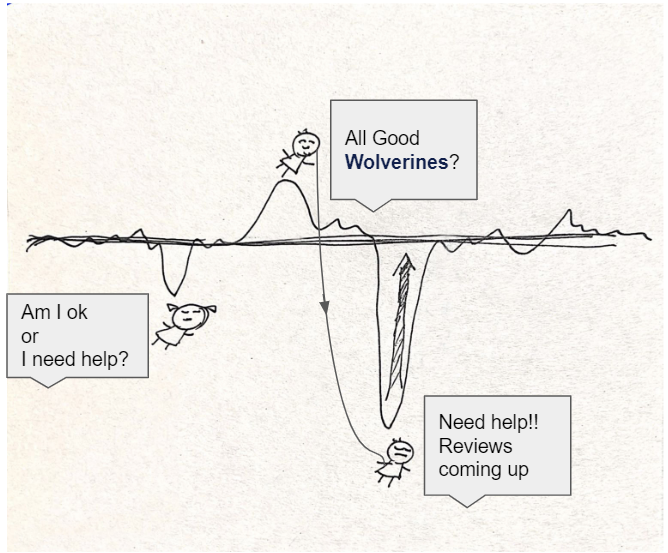
Creating a safety health net for the college students
What
We referenced Point-of-Decision Design and also took inspiration from open-world game Guidance. We found out that some points of attraction can lead students to make healthier decisions naturally. Point-of-Decision Design hopes to help students consciously make more healthy decisions. Therefore, the design advocates design at various locations in the community, that is, Point-of-Decision, to establish positive guidance for students. In open world games, space and line of sight guidance are usually used to continuously attract players to the next set goal and use it. Our team believes that combining these two types of design methods, we can establish a health guidance system in the campus community, through a series of signals to encourage students to contact and use health facilities more, so as to guide them to maintain a healthier lifestyle unconsciously.
Further, this guidance system can help them build health awareness. The basic components of the health guidance system are Attraction Decision Points. They are the facilities that attract the student, provide health assistance to them, and guide them to the next goal.
Attraction Decision Points mainly include the following four types:
-Mobile APP;
-Healthy Living Facilities;
-Physical Examination Facilities;
-Medical Kiosks.
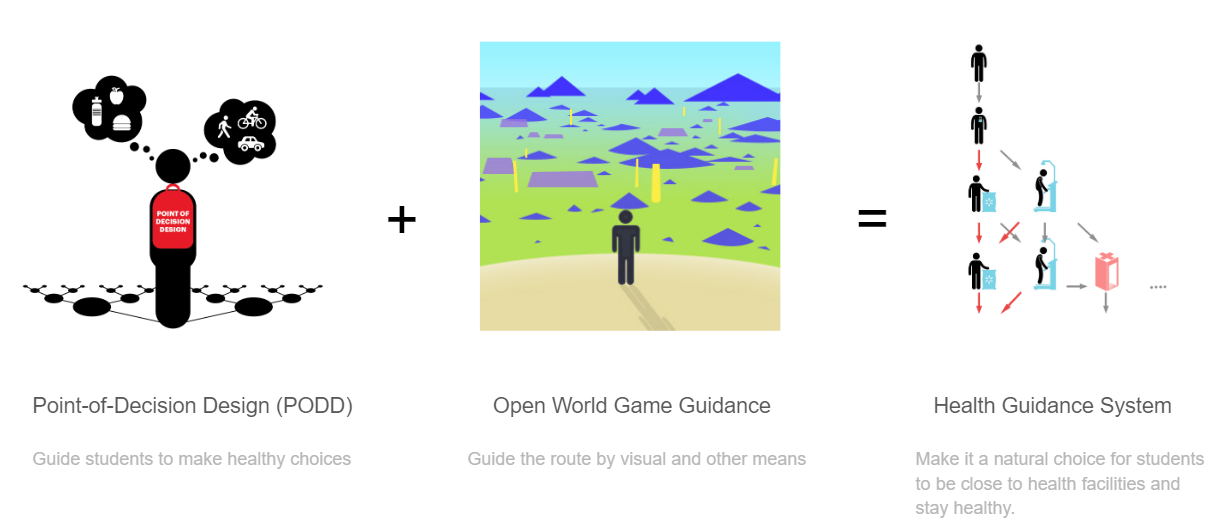
Point of decision and reference to open world game guidance
So What
Establishing a community health network is the most consistent with our definition of community health: everyone can live better, but when someone falls behind, we all need to give him a hand. We hope this Campus Health Network can help every college student live a healthy life.
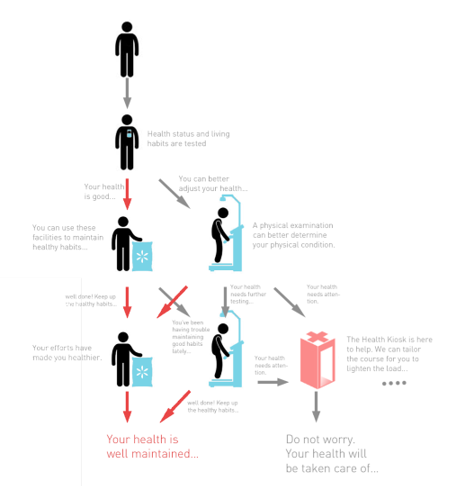

Point of decision design and the primary care network
Design To Outcomes
Making Primary Care more accessible by strategically creating first point of contacts for healthcare in the college community will result in an overall healthy lifestyle for the college students.

Healthcare Kiosk - A first point of contact to the primary care system
Links to Follow:
︎︎︎Two Page Report
︎︎︎Miro Board
︎
Works Cited
2. Roth, Sasha Aslanian and Alisa. “Inside the College Mental Health Crisis.” Accessed December 4, www.apmreports.org/episode/2021/08/19/under-pressure-the-college-mental-health-crisis. target="_blank">2022.https://www.apmreports.org/episode/2021/08/19/under-pressure-the-college-mental-health-crisis.
3. Drugwatch.com. “Student Health - Comprehensive Guide to Staying Healthy in College.” Accessed December 4, 2022. https://www.drugwatch.com/health/students/.
4. Upali Nanda, Michelle Eichinger, Jessica Hedge, Shelli Dent, Giyoung Park, Timothy Lalowski, Sheba Ross, Ileana Rodriguez, and Erin Peavey. “Point-of-Decision Design (PODD) | Healthy Choice. Healthy Campus.” Accessed December 4, 2022. https://www.cadreresearch.org/pointofdecision-design-podd-to-support-healthy-behaviors-in-the-college-campuses.
5. 西川善司. “[CEDEC 2017]「ゼルダの伝説BotW」の完璧なゲーム世界は,任天堂の開発スタイルが変わったからこそ生まれた.” Accessed December 4, 2022. https://www.4gamer.net/games/341/G034168/20170901120/.
6. Sasha Aslanian, Alisa Roth. “PUnder Pressure: Inside the college mental health crisis”. Accessed December 4, 2022. https://www.apmreports.org/episode/2021/08/19/under-pressure-the-college-mental-health-crisis.
7. John Elflein. “College student health - Statistics & Facts”. Accessed December 4, 2022. https://www.statista.com/topics/4553/college-student-health-in-the-us/#topicOverview. target="_blank">www.statista.com/topics/4553/college-student-health-in-the-us/#topicOverview.
8. Jessica Colarossi. “Mental Health of College Students Is Getting Worse”. Accessed December 4, 2022. https://www.bu.edu/articles/2022/mental-health-of-college-students-is-getting-worse/.
9. Kristin Compton. “Student Health Guide: College Students”. Accessed December 4, 2022. https://www.statista.com/topics/4553/college-student-health-in-the-us/#topicOverview.
#HealthByDesign Projects
CareByDesign
2022 Fall
2024 Winter
︎ CAREByDesign
How can we create environments for primary care that address the needs of patients, families, and caregivers, for physical and mental health?
This semester, students focus on ways primary care can happen beyond clinic walls. They are tasked with removing their assumptions and encouraged to explore ways care can be provided throughout the design
continuum, both in digital and physical realms. Through this process, students are understanding how to use their skills as designers to identify opportunities and propose solutions that are research-driven,
people-centered, and rooted in a systems view of health. The intent is for the breadth of work to create a supportive health network, where proposals strengthen one-another and further support health outcomes.
︎
CareByDesign Projects
Team members: Dureti Ahmed, Devin Chaldecott, Dua Duran, Prakriti Vasudeva
Team members: Raunak Desai, Feiling Jin
Team members: Natalie DeLiso, Angana Syamroy, Nina Lang, Nehal Jain
Team members: Priya Sam, Katie Bailey, Alison Yuan
Team members: Andrew Hoover, Blaise Gamber
Team members: Aaron Comstock, Ann Borek
Team members: Natalie Brown, Cassidy Khol, Elaine Cheng
︎
Project Debut
Mid Review: Nov. 16th, 2022 │ Final Review: Dec. 7th, 2022
Teresa Keenan ︎
Director, Consumer Insights, Health and Health Security at AARP
Maya Fraser ︎
M.Arch Candidate at Taubman College at the University of Michigan, Longo Fellow at MASS Design Group
Craig Kolstad, AIA, ASID, NOMA, LFA, LEED AP, WEDG, LSSYB ︎
Principal & Design Lead at ROSSETTI
Andrea Marquez ︎
Project Coordinator at Communities First, Inc.
Dr. Deborah Wingler, PhD, MSD-HHE, EDAC ︎
Associate Director of Research, Principal at HKS
Daniela Aguirre Alfaro ︎
Design Researcher at CADRE
Tamie Glass ︎
Associate Professor, Author of Prompt: Socially Engaging Objects and Environments
Alison Avendt, MBA ︎
Chief Operating Officer at McLaren St. Luke's
Project Debut
Mid Review: Nov. 16th, 2022 │ Final Review: Dec. 7th, 2022
Reviewers:
Teresa Keenan ︎
Director, Consumer Insights, Health and Health Security at AARP
Maya Fraser ︎
M.Arch Candidate at Taubman College at the University of Michigan, Longo Fellow at MASS Design Group
Craig Kolstad, AIA, ASID, NOMA, LFA, LEED AP, WEDG, LSSYB ︎
Principal & Design Lead at ROSSETTI
Andrea Marquez ︎
Project Coordinator at Communities First, Inc.
Dr. Deborah Wingler, PhD, MSD-HHE, EDAC ︎
Associate Director of Research, Principal at HKS
Daniela Aguirre Alfaro ︎
Design Researcher at CADRE
Tamie Glass ︎
Associate Professor, Author of Prompt: Socially Engaging Objects and Environments
Alison Avendt, MBA ︎
Chief Operating Officer at McLaren St. Luke's
︎ CAREByDesign
How can we refine primary care to better support both patients and caregivers, leveraging the relationship between primary care and design?
This topic explores the relationship between primary care and design, addressing challenges across the continuum—from information to product to place and policy—while considering the environments we live in and the human behaviors that shape them. The goal is to create meaningful transformations in the lives of patients and caregivers by implementing feasible and actionable solutions.
Throughout the semester, students will engage with real-world challenges faced by patients and primary care workers, drawing insights from primary and secondary research. They will focus on thoughtful considerations to address mental health issues among senior residents. Each student team will propose actionable and interdisciplinary interventions and innovations, contributing to the comprehensive design spectrum in primary care.
By refining primary care through this interdisciplinary approach, students aim to provide holistic solutions that improve patient care while supporting caregiver wellbeing.
Throughout the semester, students will engage with real-world challenges faced by patients and primary care workers, drawing insights from primary and secondary research. They will focus on thoughtful considerations to address mental health issues among senior residents. Each student team will propose actionable and interdisciplinary interventions and innovations, contributing to the comprehensive design spectrum in primary care.
By refining primary care through this interdisciplinary approach, students aim to provide holistic solutions that improve patient care while supporting caregiver wellbeing.
︎
CareByDesign Projects
︎ Intergenerational Design for Mental Health
How can we improve design for healthy aging through an evidence-based approach?
Intergenerational Design for Mental Health was the theme for the final projects. An exercise to prepare for the project
was to practice applied-research skills using qualitative and quantitative methods. We chose a local site in Ann
Arbor for our observation visit. This exercise guided our interests in addition to learning from the guest speakers
and readings for the class.
For each project, students created a short elevator pitch in addition to describing the context along the design continuum. An evidence-based approach and supporting research was utilized as part of the process to design for the desired health outcome.
For each project, students created a short elevator pitch in addition to describing the context along the design continuum. An evidence-based approach and supporting research was utilized as part of the process to design for the desired health outcome.
︎
Intergenerationl Design for Mental Health Projects
︎ CAREByDesign
How can telehealth be effectively incorporated into primary care while considering diverse healthcare delivery models to ensure accessibility, affordability, and quality care for all patients?
This semester, in collaboration with RVO Health, students explored the design of primary healthcare spaces beyond traditional clinic walls. Tasked with challenging their assumptions, they were encouraged to investigate innovative ways care can be delivered across the design continuum in both digital and physical realms.
Four key healthcare delivery models were identified, and through this process, students learned to use their design skills to identify opportunities and propose solutions that are research-driven, people-centered, and rooted in a systems view of health. The course aimed to cultivate a new perspective on healthcare delivery, empowering students to envision primary care in unconventional yet impactful ways
Four key healthcare delivery models were identified, and through this process, students learned to use their design skills to identify opportunities and propose solutions that are research-driven, people-centered, and rooted in a systems view of health. The course aimed to cultivate a new perspective on healthcare delivery, empowering students to envision primary care in unconventional yet impactful ways
Primary Care - International Perspective
Students conducted comprehensive research to explore and document the status of primary care across various regions of the world.
︎ Video Presentation
︎
CareByDesign Projects
Team members: Lauren Jenkins, Rachel Liu, Srinjayee Saha, Irene Wei, Jintao Zhai
Team members: Paresh Hemnani, Siya Shah, Elijah Underhill-Miller, Christa Keyrouz
Team members: Adriano De Quesada, Beatriz Vezzaro, Arlo Delgado
Team members: Nana Temple, Marianna Godfrey, Chloe Zhang, Kristina Marchand
︎
Project Debut
Final Review: May 17th, 2024
Dr. Jenny Yu, ︎
Chief Health Officer | Oculoplastic Surgeon | Social Entrepreneur | Travel Health Expert
Dr. Joy Knoblauch, ︎
Associate Professor of Architecture at Taubman College, University of Michigan
Matias del Campo, ︎
Architecture and AI expert | Director of AR2IL, Taubman College, University of Michigan
Jonathan Rule, ︎
Assistant Professor of Practice, Taubman College, University of Michigan
Betsy Williams, ︎
Principal, Studio Design Leader, HKS Inc.
Camilla Moretti, ︎
Healthcare Practice Leader, HKS Inc.
Nikola Gjurchinoski, ︎
Architect, Researcher | Research, HKS Inc.
Rutali Joshi, ︎
Senior Design Researcher, Associate, HKS Inc
Natalie DeLiso, ︎
M.Arch Student, Taubman College, University of Michigan
Prakriti Vasudeva, ︎
M.Arch Student, Taubman College, University of Michigan
Project Debut
Final Review: May 17th, 2024
Reviewers:
Dr. Jenny Yu, ︎
Chief Health Officer | Oculoplastic Surgeon | Social Entrepreneur | Travel Health Expert
Dr. Joy Knoblauch, ︎
Associate Professor of Architecture at Taubman College, University of Michigan
Matias del Campo, ︎
Architecture and AI expert | Director of AR2IL, Taubman College, University of Michigan
Jonathan Rule, ︎
Assistant Professor of Practice, Taubman College, University of Michigan
Betsy Williams, ︎
Principal, Studio Design Leader, HKS Inc.
Camilla Moretti, ︎
Healthcare Practice Leader, HKS Inc.
Nikola Gjurchinoski, ︎
Architect, Researcher | Research, HKS Inc.
Rutali Joshi, ︎
Senior Design Researcher, Associate, HKS Inc
Natalie DeLiso, ︎
M.Arch Student, Taubman College, University of Michigan
Prakriti Vasudeva, ︎
M.Arch Student, Taubman College, University of Michigan
